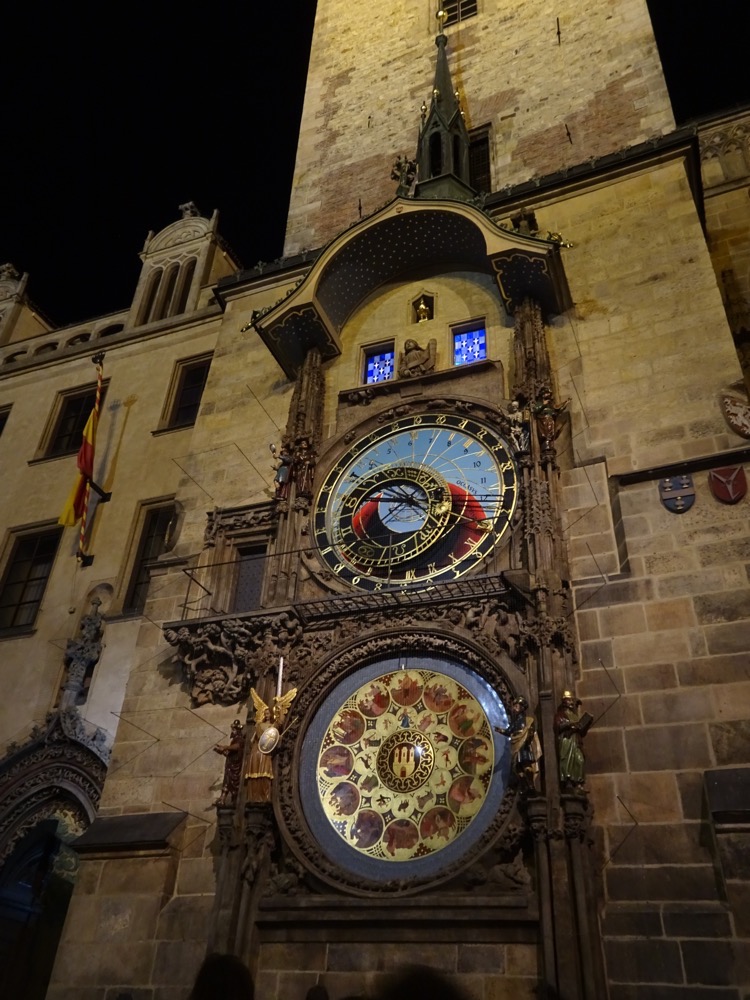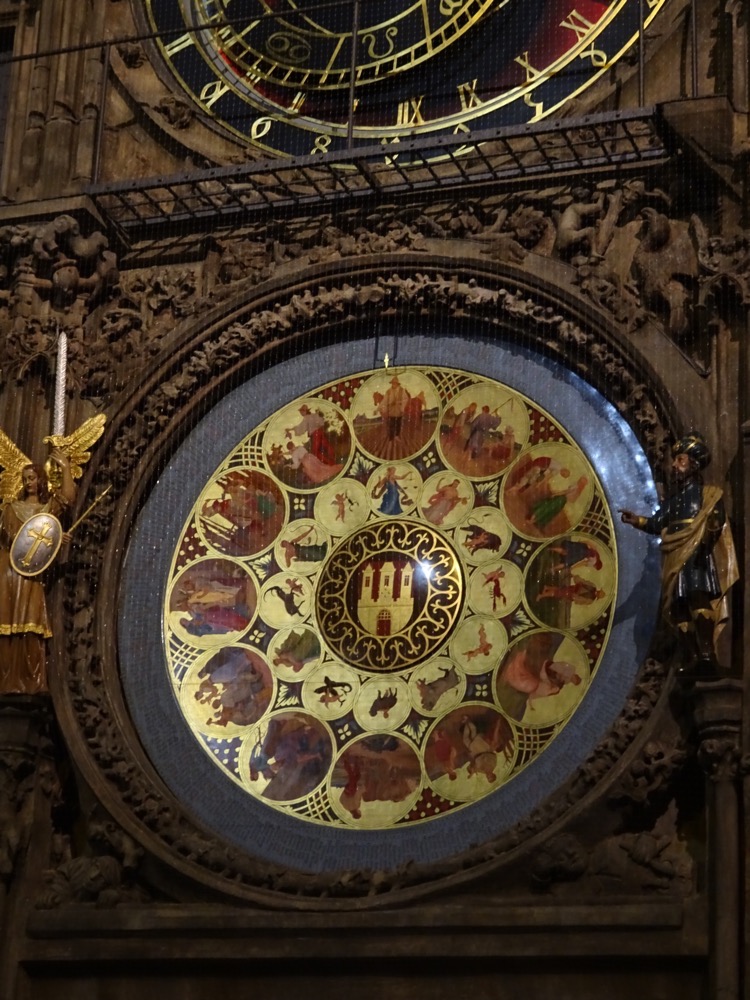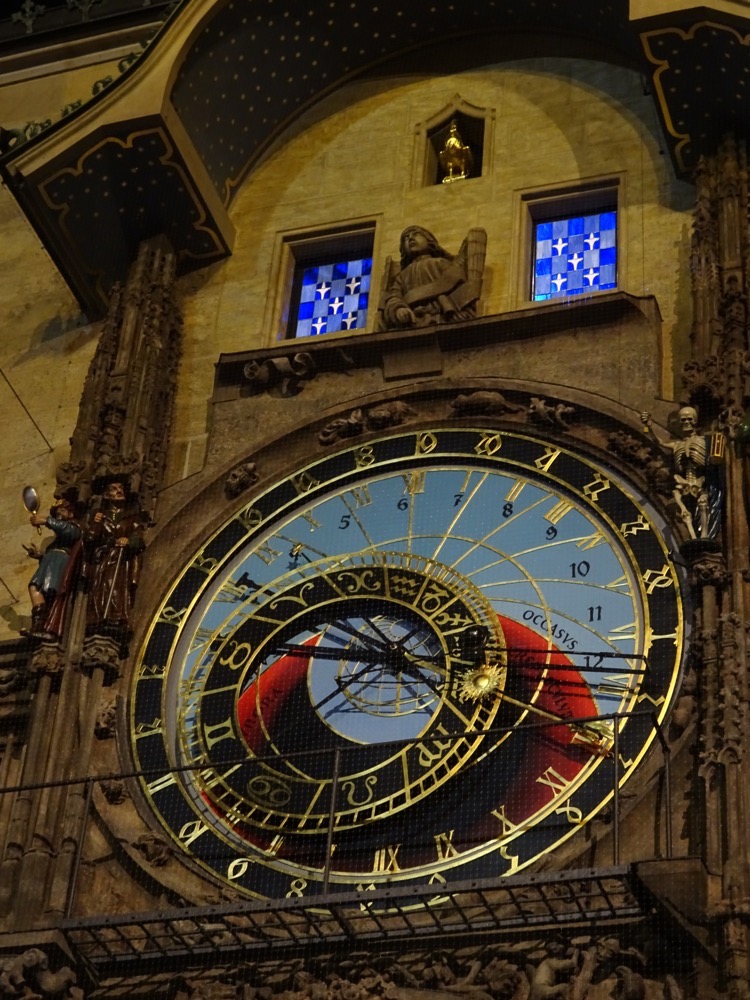Today we had booked a Prague All Inclusive Walking Tour with Martin the Loquacious. It was to be a full day tour following the “King’s Coronation Way” or the “Royal Way”, which is the is an established historical path which goes through the historical centre of Prague from the former Royal Court at Prague Castle to the old town. Czech kings would travel this way on their coronation parades, though they usually started in the Old Town with the peasants and wended their way up to the Castle. Given that is a seriously uphill route – most people choose to do it on foot the other way around these days, as most of the historically important sights of the historical Prague are situated along the route.
We started off our tour at the Černínský Palác or Czernin Palace which is the largest baroque palaces in Prague. The palace was commissioned by the diplomat, Humprecht Jan Černín z Chudenic (great name!), Habsburg imperial ambassador of the Habsburgs in the 1660s. It has more recently been used as government offices and has been the Czech foreign ministry since the 1930s.
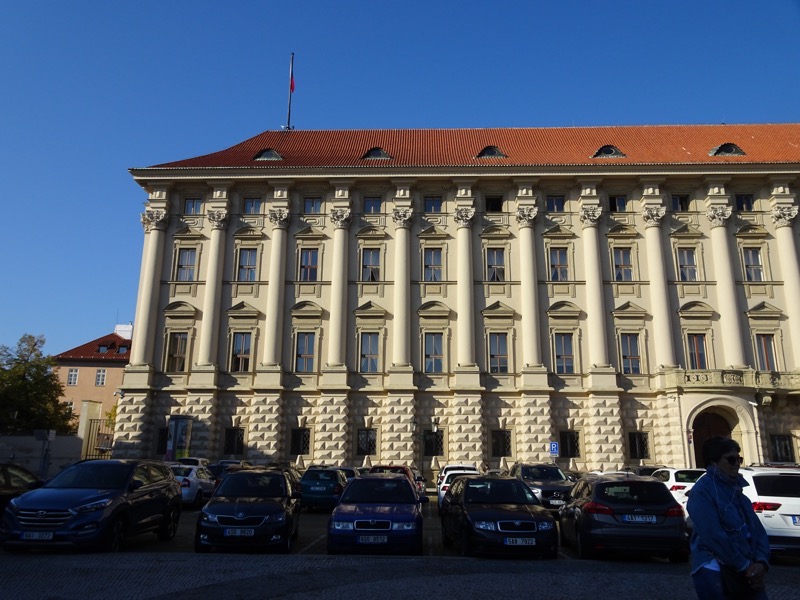 Down the road a little bit is a monument called ‘Prague Tower’, which is a monument to the Catholic Virgin Mary.
Down the road a little bit is a monument called ‘Prague Tower’, which is a monument to the Catholic Virgin Mary.
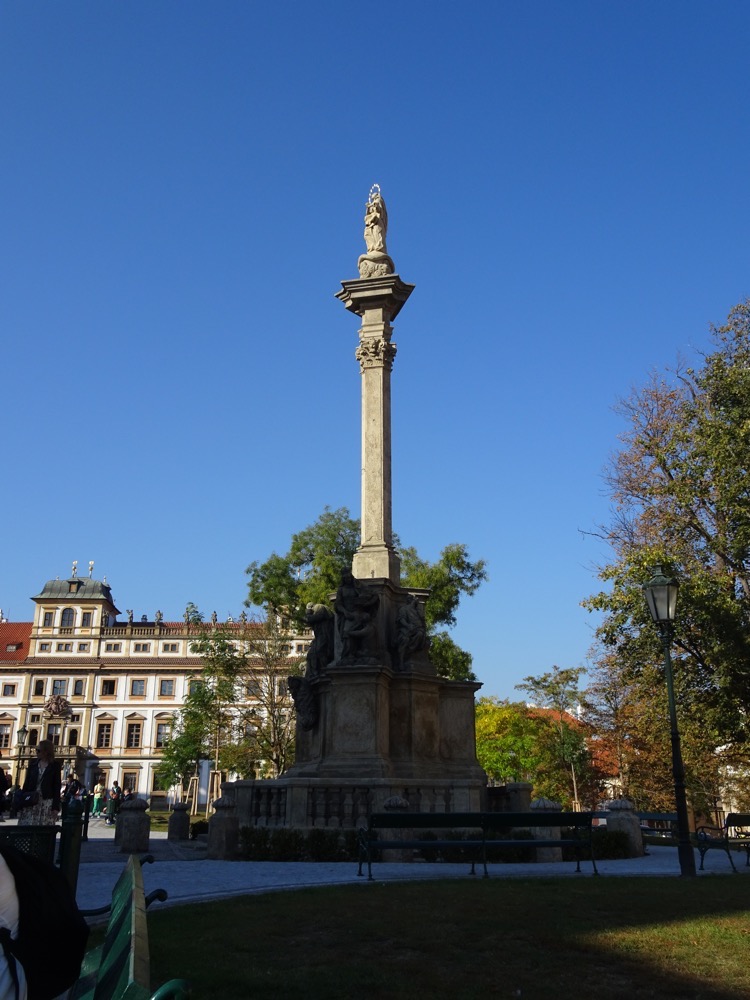
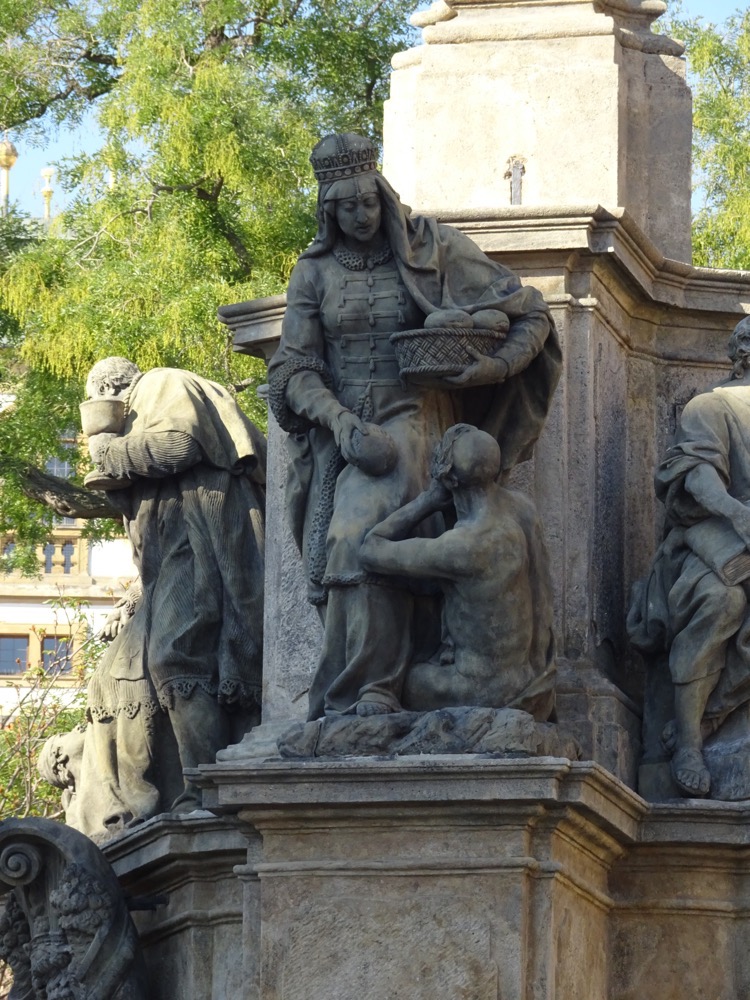
In Hradčanské (Hradcany) Square, you will find what is considered to be the ‘pearl of Renaissance houses of Prague’ – Schwarzenberg Palace – family rents for one Crown per year to the national gallery.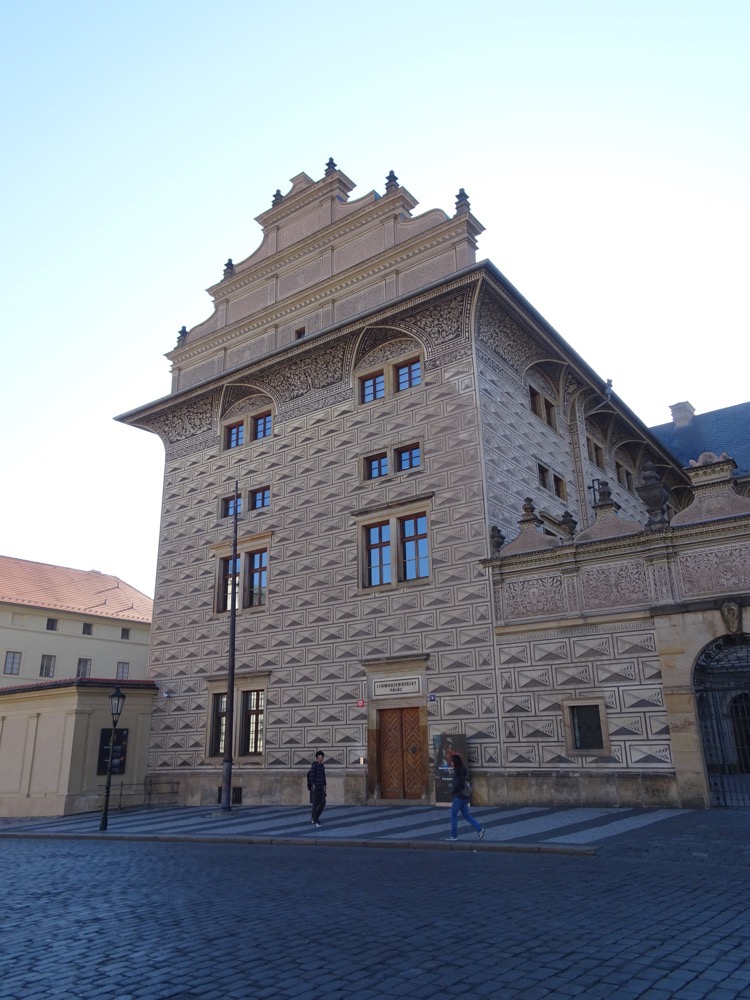 Schwarzenberg Palace is famous for its striking sgraffito decorations. Sgraffito is a decorative technique based which is created by the application of two layers of mortar. After the mortar layers are applied, skilled craftsmen scratch through the top layer until they reach the black bottom layer creating intricate designs and illusions, giving the walls unusual depth and dimension. The method reminds me of the black and coloured crayon artworks we used to create as kids – put a myriad of colours on the paper and then cover it with black crayon, then we would scratch the black off to reveal patterns and drawings. 😛
Schwarzenberg Palace is famous for its striking sgraffito decorations. Sgraffito is a decorative technique based which is created by the application of two layers of mortar. After the mortar layers are applied, skilled craftsmen scratch through the top layer until they reach the black bottom layer creating intricate designs and illusions, giving the walls unusual depth and dimension. The method reminds me of the black and coloured crayon artworks we used to create as kids – put a myriad of colours on the paper and then cover it with black crayon, then we would scratch the black off to reveal patterns and drawings. 😛
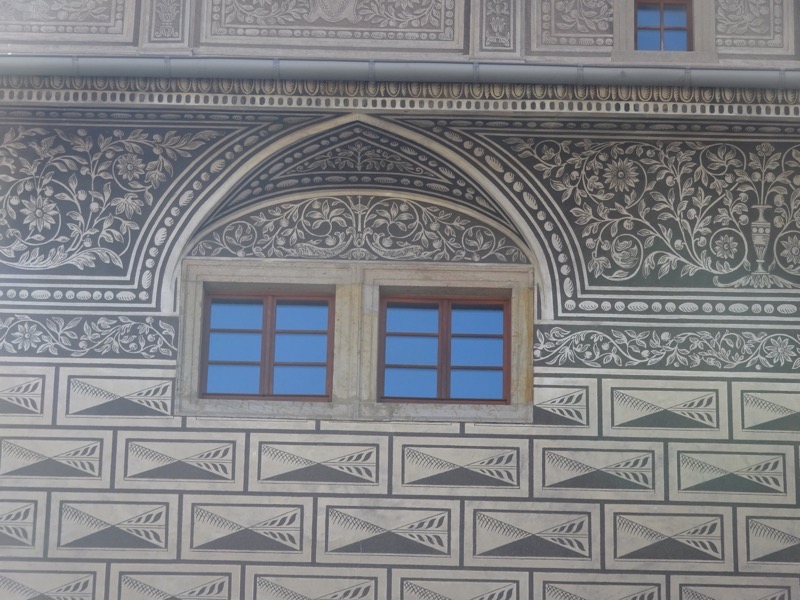
Across the square from the Schwarzenberg Palace is the rather impressive Archbishop´s Palace which has been the seat of Prague Archbishops continuously since the 16th century. It has been renovated/rebuilt several times in various styles – and you can see Renaissance, Baroque and Rococo features on the facade today. 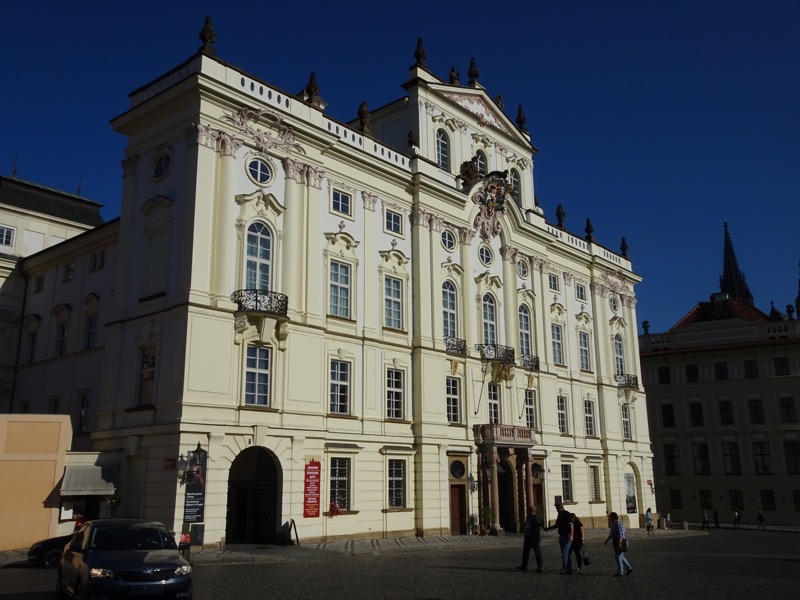 Originally the palace was built for Florian Griespek of Griesbach, who was secretary of the Czech Chamber and confidante of Emperor Ferdinand I in the first half of the 16th century. But then Ferdinand bought the palace in 1561 and gave it to the Prague Archbishop, Antonin Brousa of Mohelnice (as you do!), and it has been the official residence of the Prague archbishopric ever since.
Originally the palace was built for Florian Griespek of Griesbach, who was secretary of the Czech Chamber and confidante of Emperor Ferdinand I in the first half of the 16th century. But then Ferdinand bought the palace in 1561 and gave it to the Prague Archbishop, Antonin Brousa of Mohelnice (as you do!), and it has been the official residence of the Prague archbishopric ever since.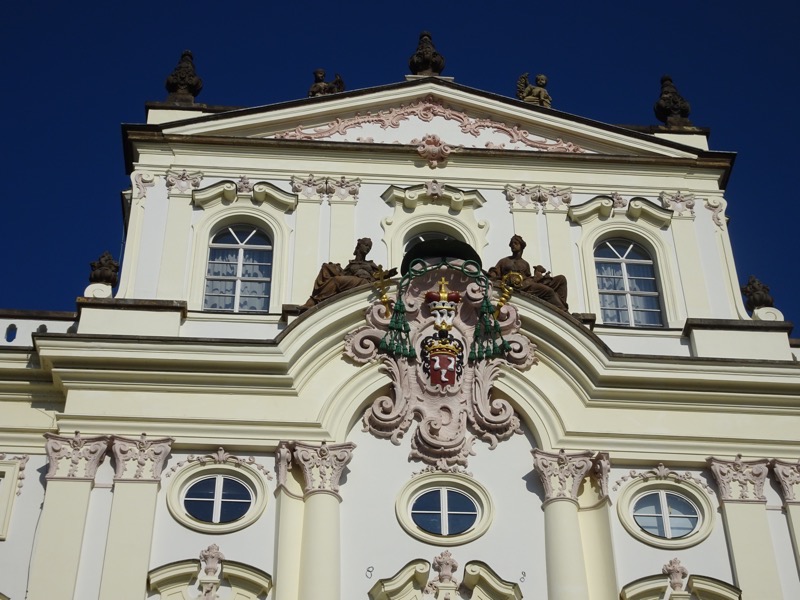
Prague Castle and Hradcany Square
Next stop – Pražský Hrad (Prague Castle) which is actually an entire castle complex that dates back to the 9th century. It is currently the official office of the President of the Czech Republic, but the castle has been the traditional seat of power for kings of Bohemia, the various Holy Roman emperors, and recent presidents of Czechoslovakia. The castle has replicas of the Bohemian Crown Jewels available for viewing from the public but the originals are kept within a secure hidden room somewhere. Apparently, they have done a spectral analysis on the gems in the Crown Jewels and instead of the gemstones originating from Siberia, the stones are puzzlingly only able to have been sourced from Australia or Thailand? Not sure about that one – I don’t know enough about the provenance of the items to discuss it further (and I don’t have any internet connection at present!).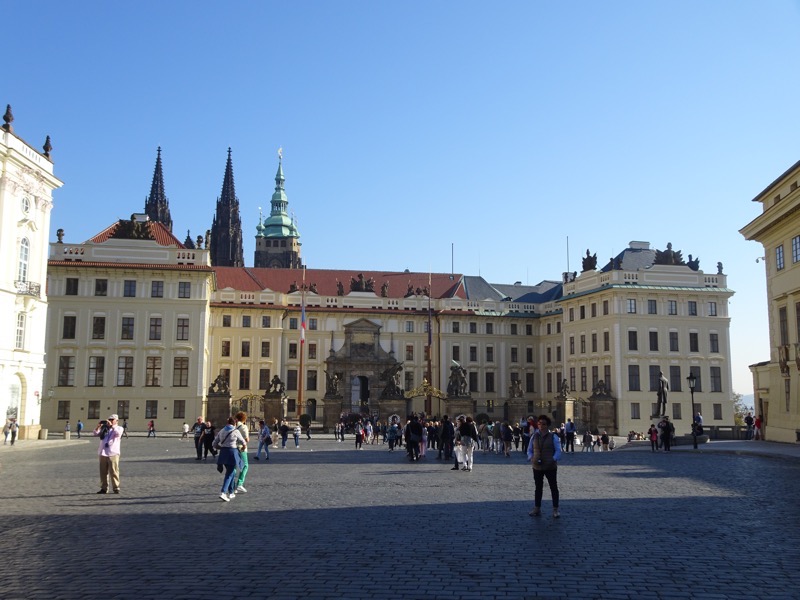 Prague Castle is THE largest ancient castle in the world, occupying an area of almost 70,000 square metres, and is about half a kilometre long and about 130m wide. It is one of the most visited attractions in Prague, seeing nearly 1.8 million visitors per annum (which means sections of the Castle are frequently closed for renovations and restorations), and it takes a good three to four hours to go through properly.
Prague Castle is THE largest ancient castle in the world, occupying an area of almost 70,000 square metres, and is about half a kilometre long and about 130m wide. It is one of the most visited attractions in Prague, seeing nearly 1.8 million visitors per annum (which means sections of the Castle are frequently closed for renovations and restorations), and it takes a good three to four hours to go through properly. 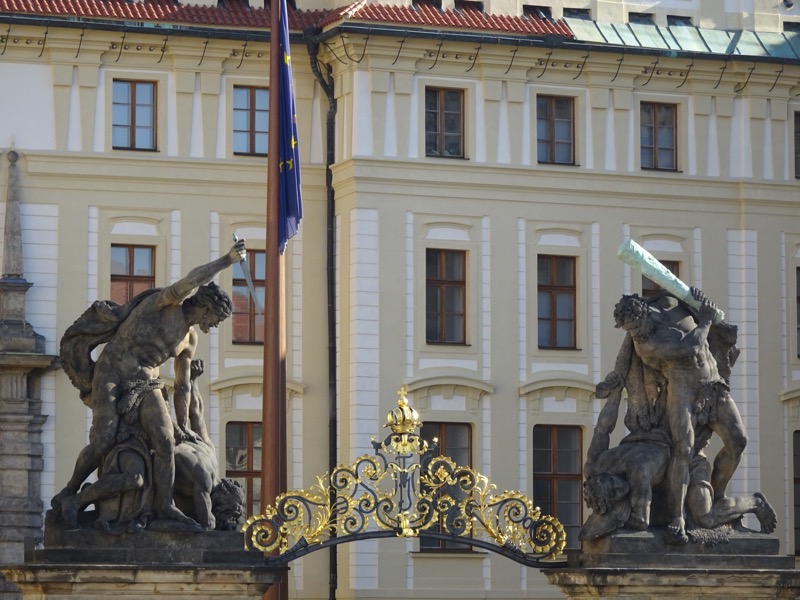 One very bored palace guard. At least he’s allowed to wear his Raybans so the tourist can’t see him rolling his eyes at them…
One very bored palace guard. At least he’s allowed to wear his Raybans so the tourist can’t see him rolling his eyes at them…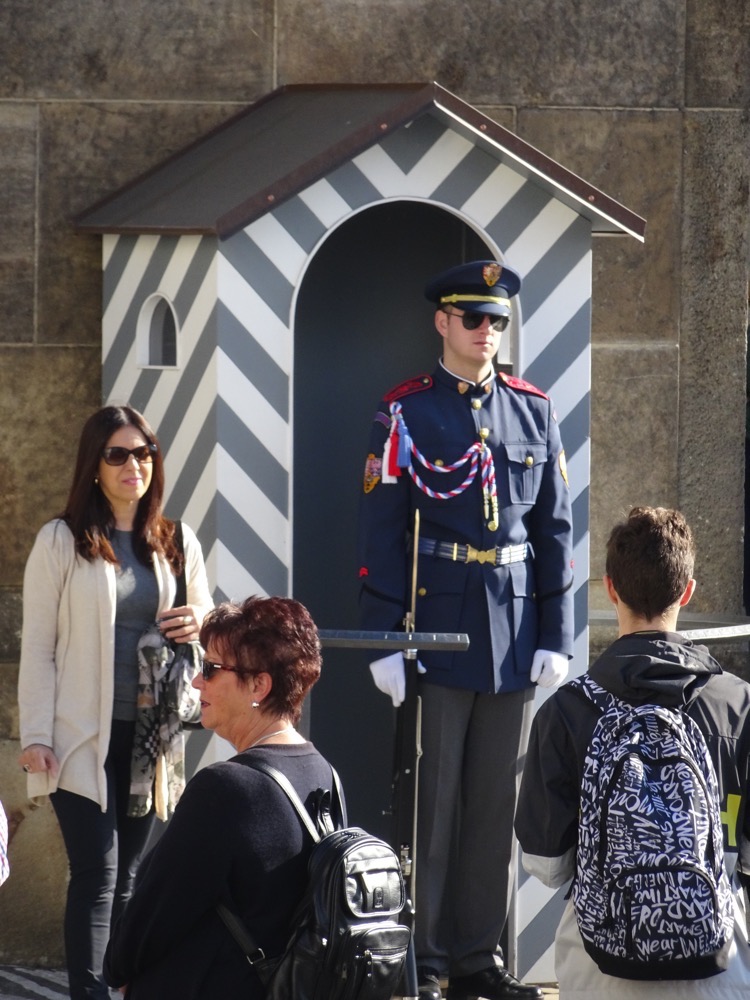
The first courtyard of the palace which contains the famous Kohl’s Fountain and today is hosting a photo shoot for yet another Chinese bride.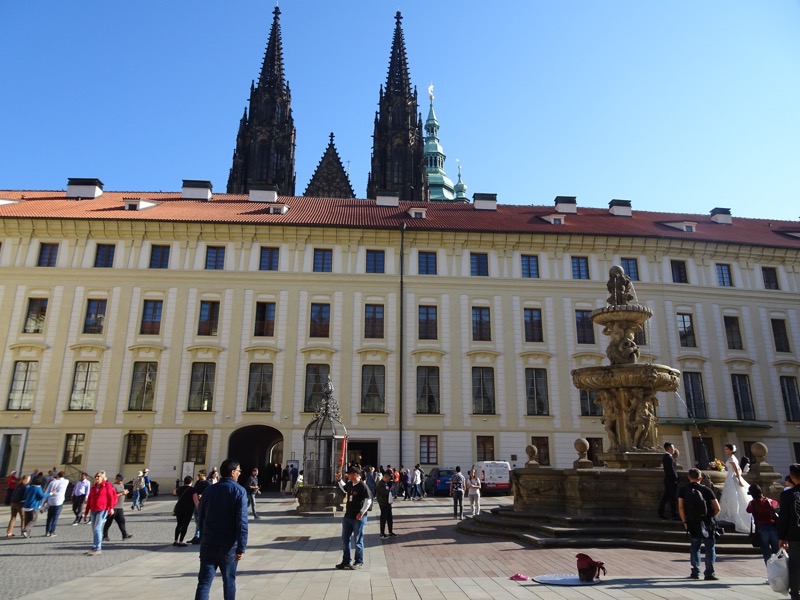
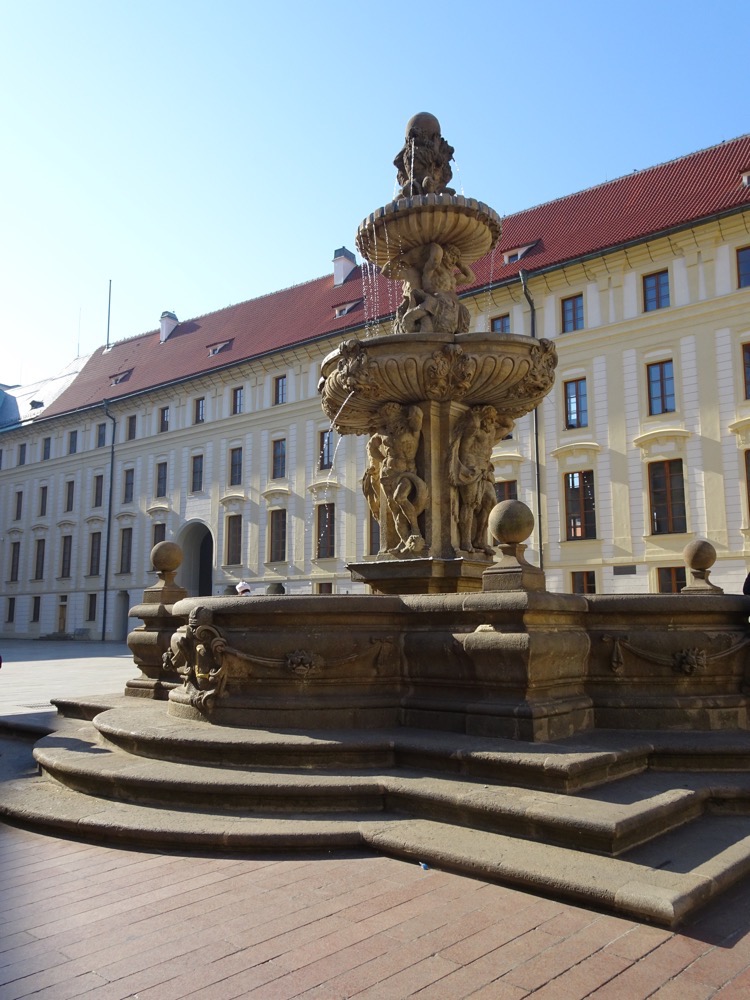
So I have done a bit of investigating into this Chinese brides in western bridal gowns being photographed everywhere we go. I have seen them in Sydney, at the Trevi Fountain, in London, in Brisbane, in Santorini, and yale has seen them in Cappadocia in Turkey. It turns out that the Chinese have a tradition of having wedding photography done before their wedding day, rather than on the occasion itself. 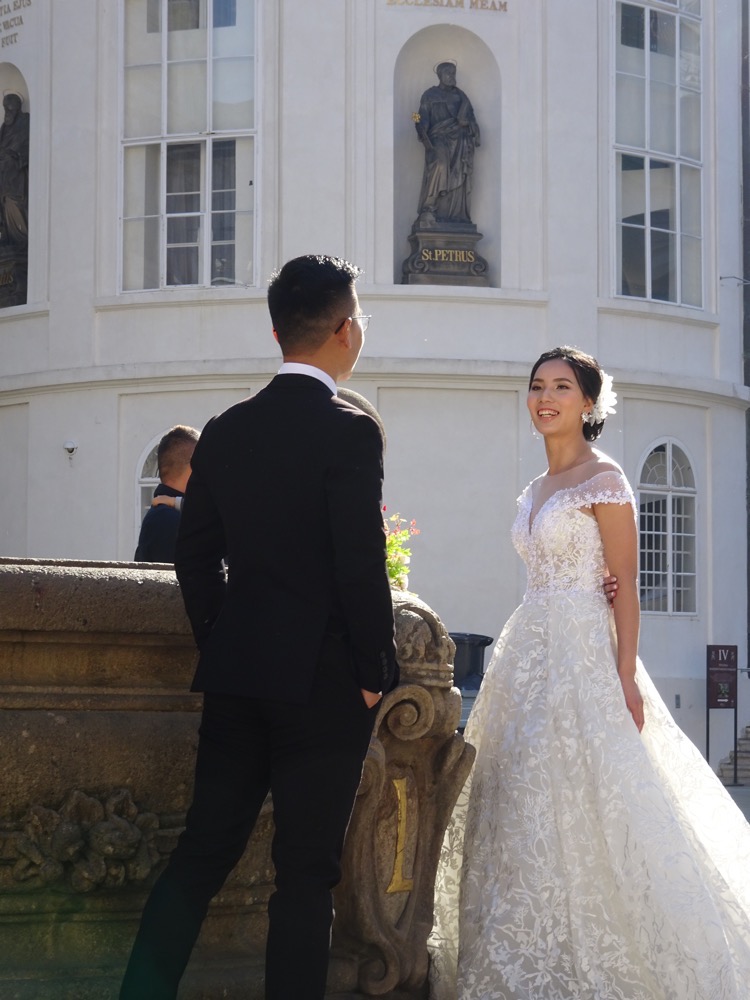 Usually the couple would get dressed up and go somewhere nice and have their pictures taken and then copies are printed out and given to guests, or images are printed and on display at the actual wedding or even used in videos etc,… but as the Chinese population are becoming more and more affluent, they are studying and travelling abroad and choosing to have their pre-wedding photographs done at famous locations. For some of the more wealthy Chinese families, this is turning into a grand European tour with stops at many famous locations for a staged and posed series of photographs that could take several weeks to complete – which certainly explains why so many of the grooms look thoroughly over it. There are many Chinese photographers (the Chinese prefer very staged and posed photographs, and won’t use local photographers who aim for more candid and natural poses) basing themselves in desireable locations to capitalise on this market, and they sell packages which include photographer, makeup artists, gown rental and even permits to shoot in public places, in London and Paris. So that explains that.
Usually the couple would get dressed up and go somewhere nice and have their pictures taken and then copies are printed out and given to guests, or images are printed and on display at the actual wedding or even used in videos etc,… but as the Chinese population are becoming more and more affluent, they are studying and travelling abroad and choosing to have their pre-wedding photographs done at famous locations. For some of the more wealthy Chinese families, this is turning into a grand European tour with stops at many famous locations for a staged and posed series of photographs that could take several weeks to complete – which certainly explains why so many of the grooms look thoroughly over it. There are many Chinese photographers (the Chinese prefer very staged and posed photographs, and won’t use local photographers who aim for more candid and natural poses) basing themselves in desireable locations to capitalise on this market, and they sell packages which include photographer, makeup artists, gown rental and even permits to shoot in public places, in London and Paris. So that explains that.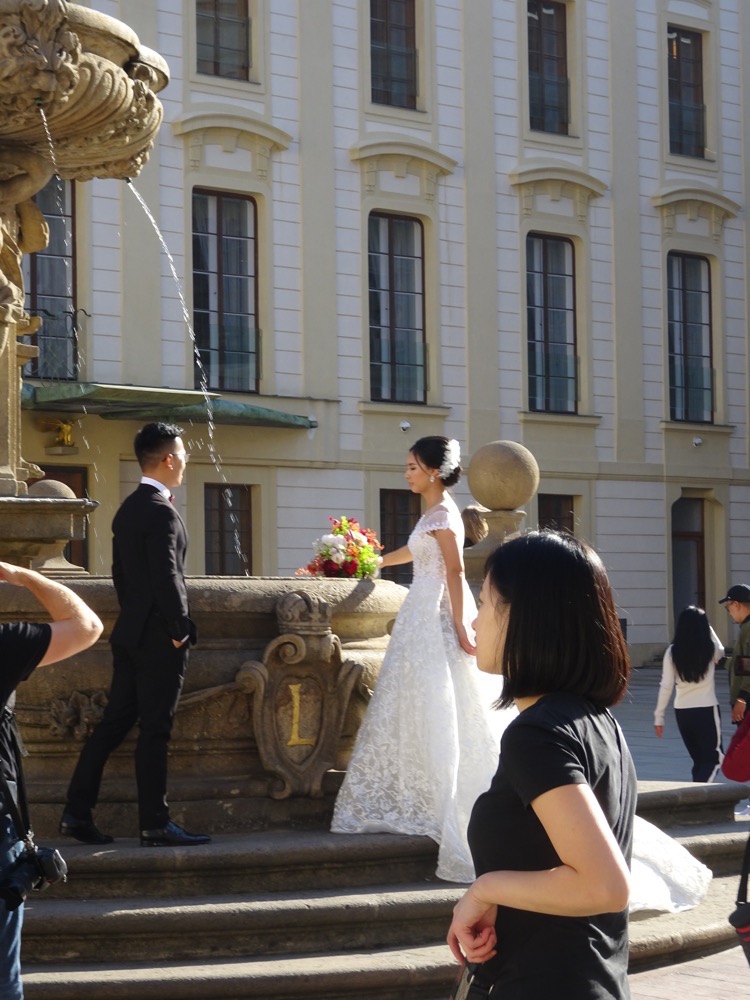
In the second courtyard is the famous St. Vitus Cathedral also known as the Metropolitan Cathedral of Saints Vitus, Wenceslaus, and Adalbert (nope, not going to try and translate that one into Czech). It is a Roman Catholic cathedral and the official seat of the Archbishop of Prague. The Cathedral is a prominent example of classic high Gothic architecture and it is considered the largest and most important church in the Czech Republic. Wait, I found it: in Czech, it is the ‘Metropolitní katedrála svatého Víta, Václava a Vojtěcha’! A-ha!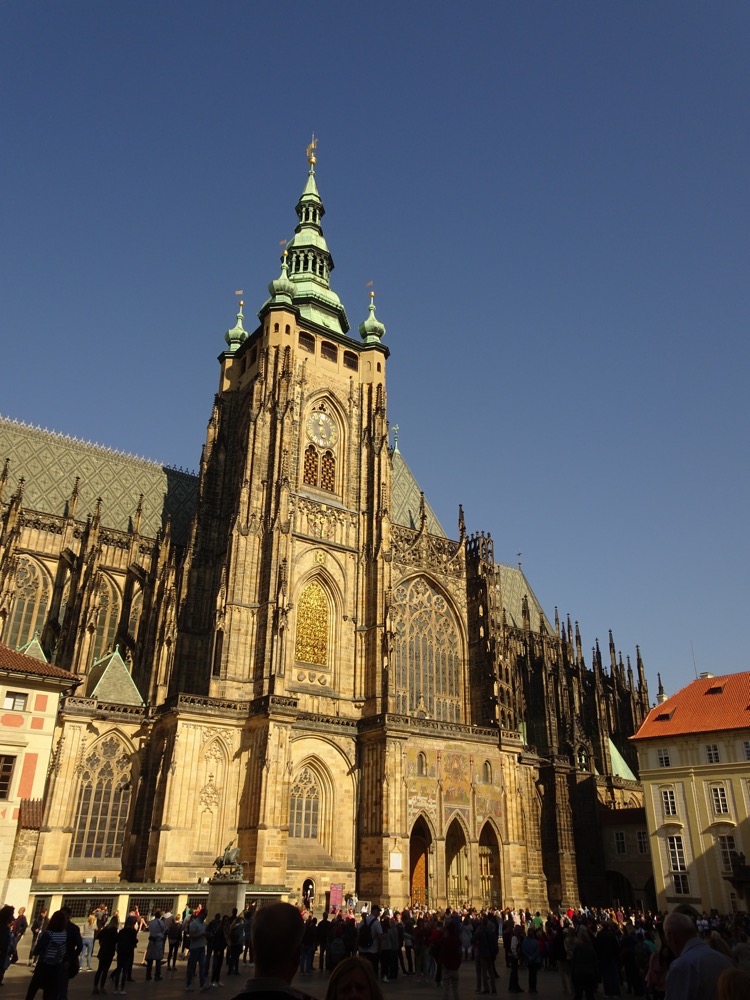 Originally the courtyard was 4-6m lower than it is currently, but has been built up over the centuries. I imagine that it is a rather interesting and impressive archaeological dig that we are walking over.
Originally the courtyard was 4-6m lower than it is currently, but has been built up over the centuries. I imagine that it is a rather interesting and impressive archaeological dig that we are walking over. 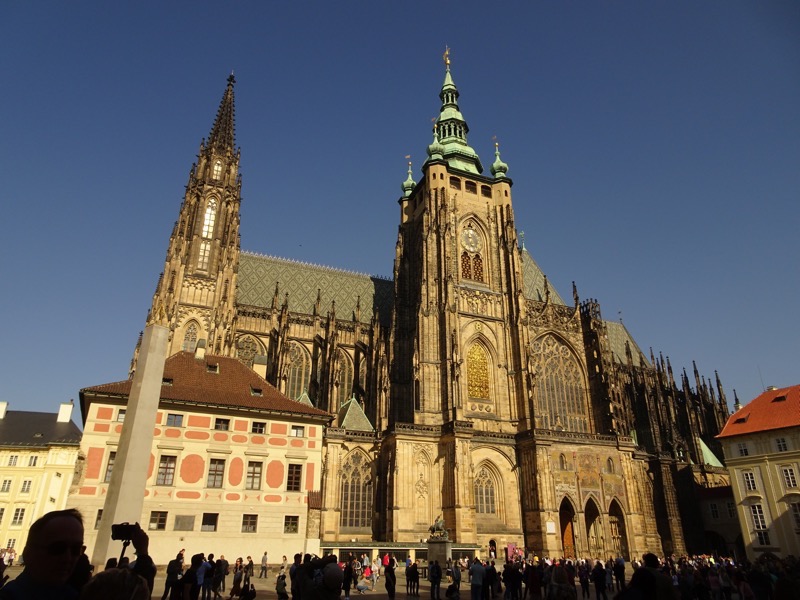
Unusually, the cathedral is not owned by the Catholic church, but rather is owned by the Czech government as it is part of the castle complex. The cathedral as we see it today is actually the third of a series of cathedrals built on this site, all of which have been dedicated to St. Vitus. The first church was an early Romanesque rotunda structure that was built by Wenceslaus I, Duke of Bohemia in 930. Not long after this in 1060, the bishopric of Prague was bestowed and then Prince Spytihněv II, built a larger church as the rotunda was too small for the burgeoning Catholic population.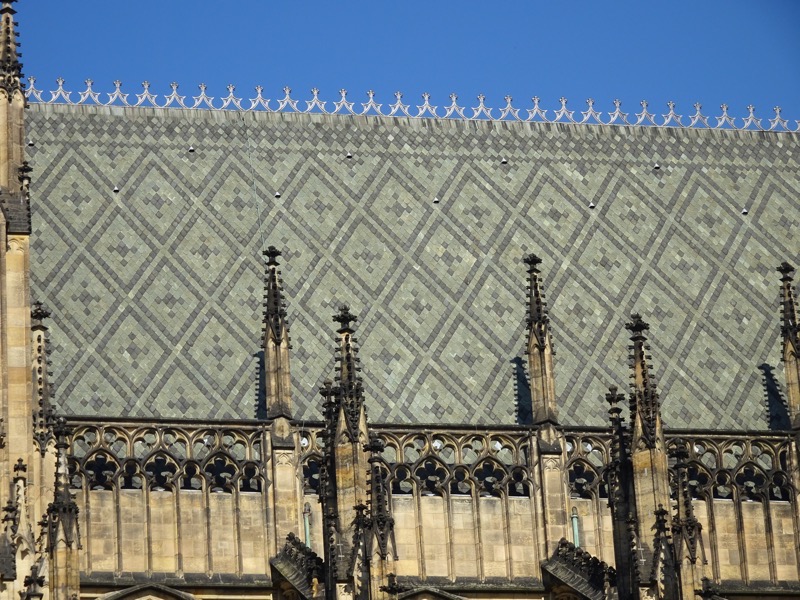 Construction of the present-day full-on Gothic cathedral began on 21 November 1344, when the See of Prague was elevated to an archbishopric. At that time, King John of Bohemia starting the building of the current impressive edifice. Apparently Charles IV, King of Bohemia and a soon-to-be self proclaimed Holy Roman Emperor, was heavily involved in the construction (read: patron/donor) and he planned for the new cathedral to be a coronation church, family crypt, treasury for the precious relics, and the final resting place of Saint Wenceslaus with a view to it also becoming a pilgrimage site. Charles IV, however, didn’t live to see much of the cathedral built.
Construction of the present-day full-on Gothic cathedral began on 21 November 1344, when the See of Prague was elevated to an archbishopric. At that time, King John of Bohemia starting the building of the current impressive edifice. Apparently Charles IV, King of Bohemia and a soon-to-be self proclaimed Holy Roman Emperor, was heavily involved in the construction (read: patron/donor) and he planned for the new cathedral to be a coronation church, family crypt, treasury for the precious relics, and the final resting place of Saint Wenceslaus with a view to it also becoming a pilgrimage site. Charles IV, however, didn’t live to see much of the cathedral built. 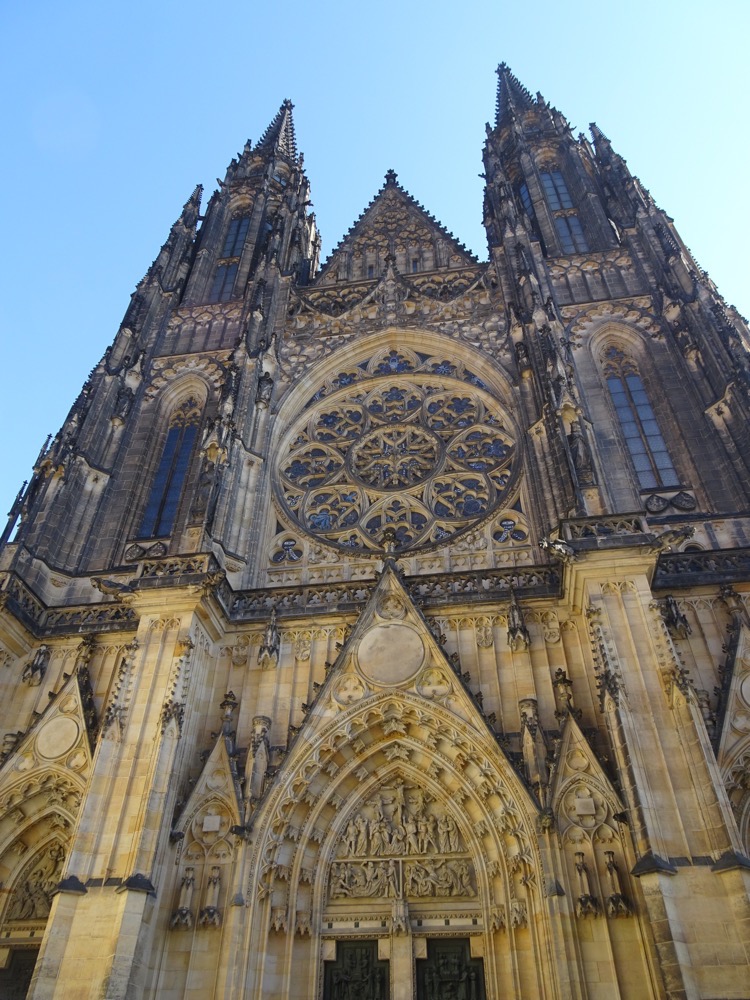 The cathedral has a long and illustrious history of various architects and patrons that goes on and on and which I won’t recount here – the long and the short of it is that the Cathedral remaind half completed for several hundred years, but by the time of St. Wenceslas jubilee in 1929 (yes, you read that right!), the St. Vitus cathedral was finally finished, nearly 600 years after it was started.
The cathedral has a long and illustrious history of various architects and patrons that goes on and on and which I won’t recount here – the long and the short of it is that the Cathedral remaind half completed for several hundred years, but by the time of St. Wenceslas jubilee in 1929 (yes, you read that right!), the St. Vitus cathedral was finally finished, nearly 600 years after it was started.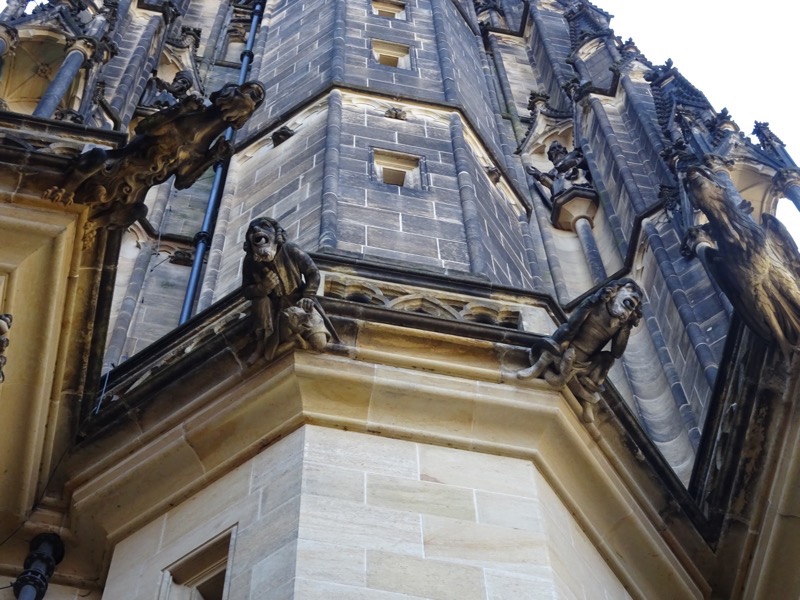 n 1997, on the 1000th anniversary of the death of Saint Voitechus, there was a dedication ceremony where the church was re-dedicated to include Saint Wenceslaus and Saint Adalbert, as the remains/relics of Saint Adalbert have been interred here since 1038.
n 1997, on the 1000th anniversary of the death of Saint Voitechus, there was a dedication ceremony where the church was re-dedicated to include Saint Wenceslaus and Saint Adalbert, as the remains/relics of Saint Adalbert have been interred here since 1038.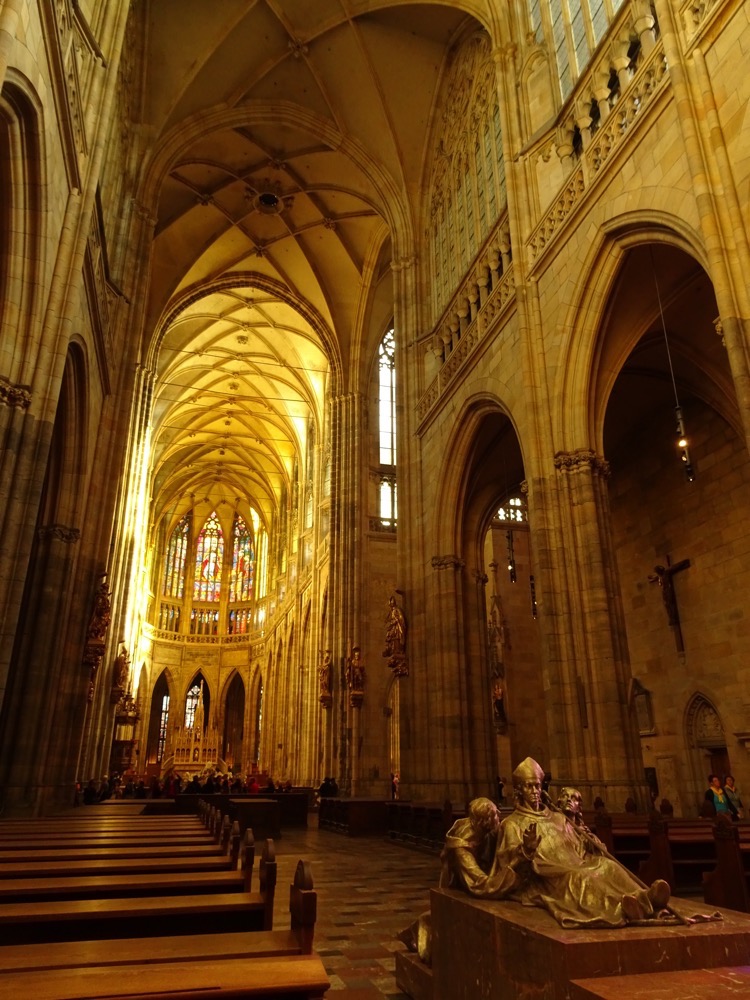
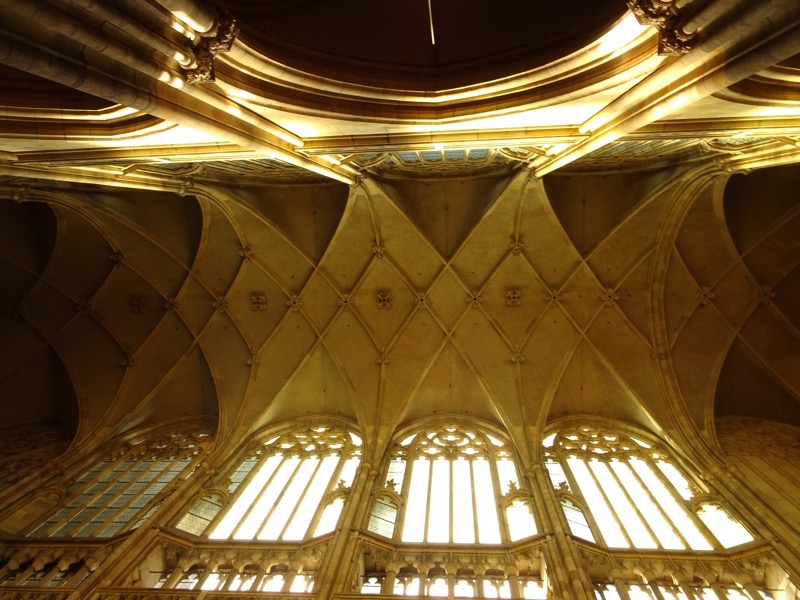
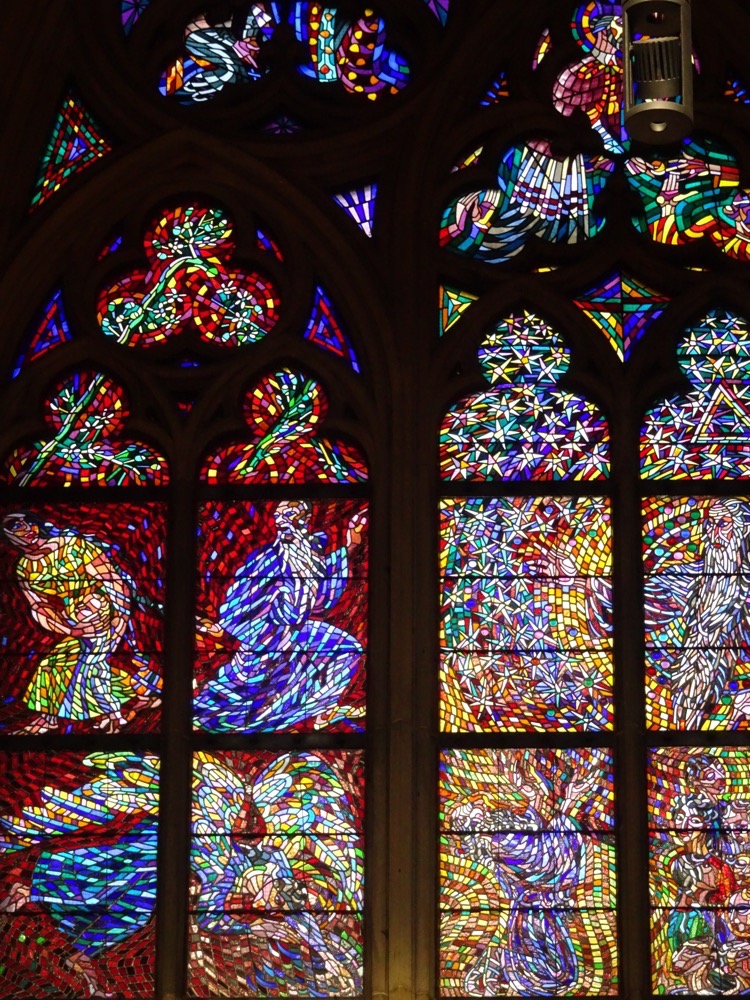 If you are looking at the stained glass and thinking the designs seem particularly modern – you are quite correct. Most of the glasswork was completed in 1929… and are somewhat incongruous with the high gothic style.
If you are looking at the stained glass and thinking the designs seem particularly modern – you are quite correct. Most of the glasswork was completed in 1929… and are somewhat incongruous with the high gothic style.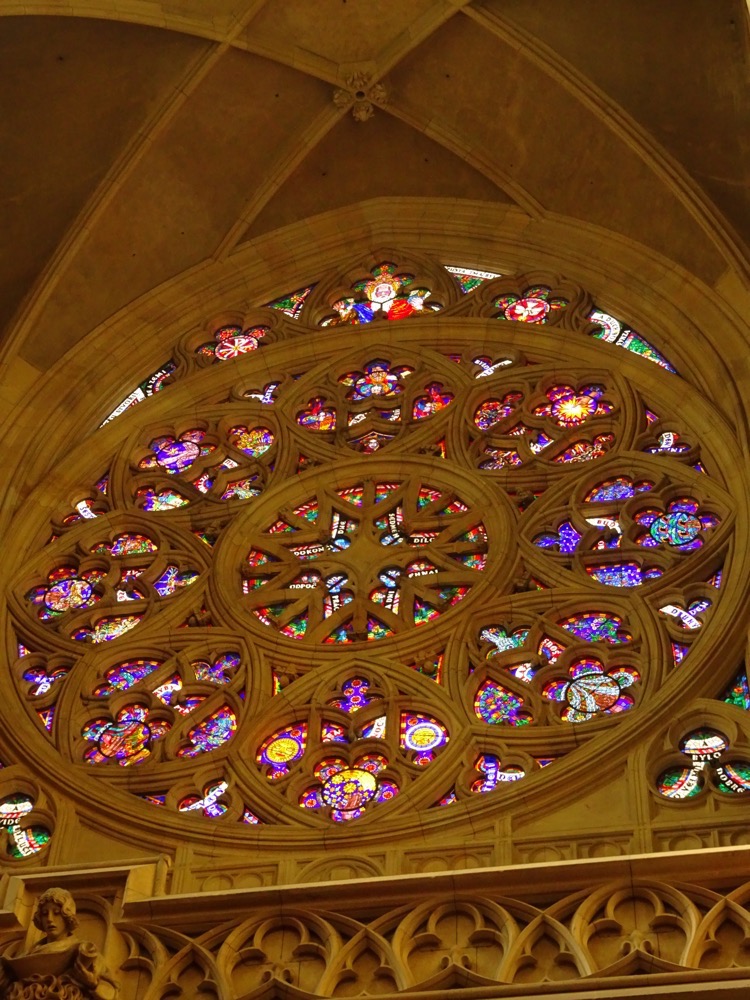
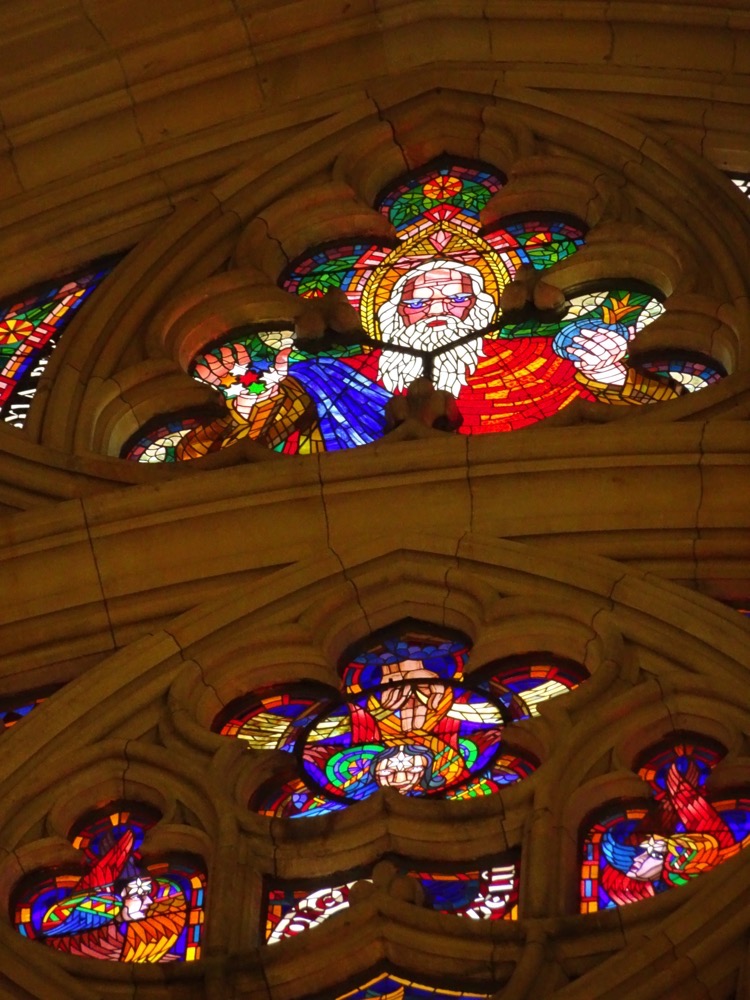
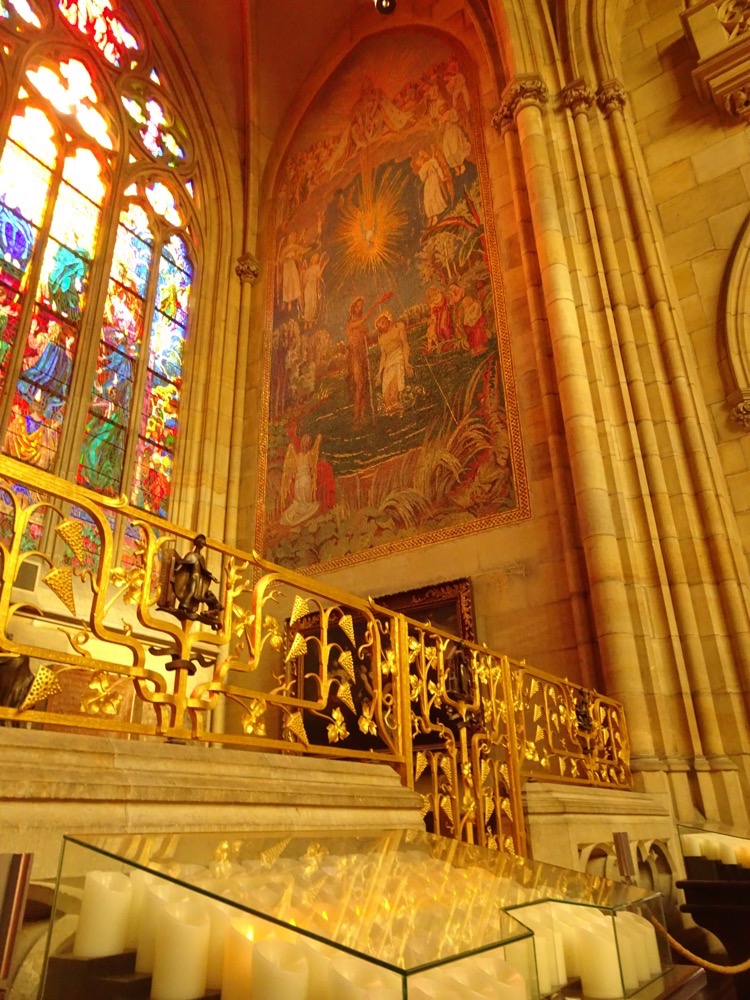
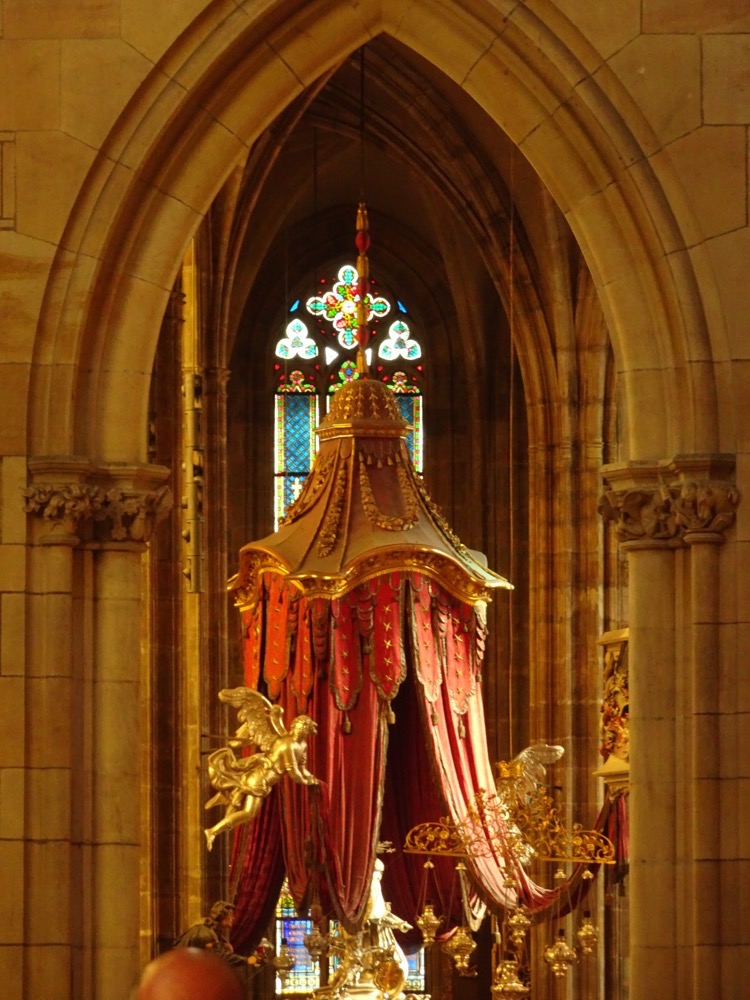
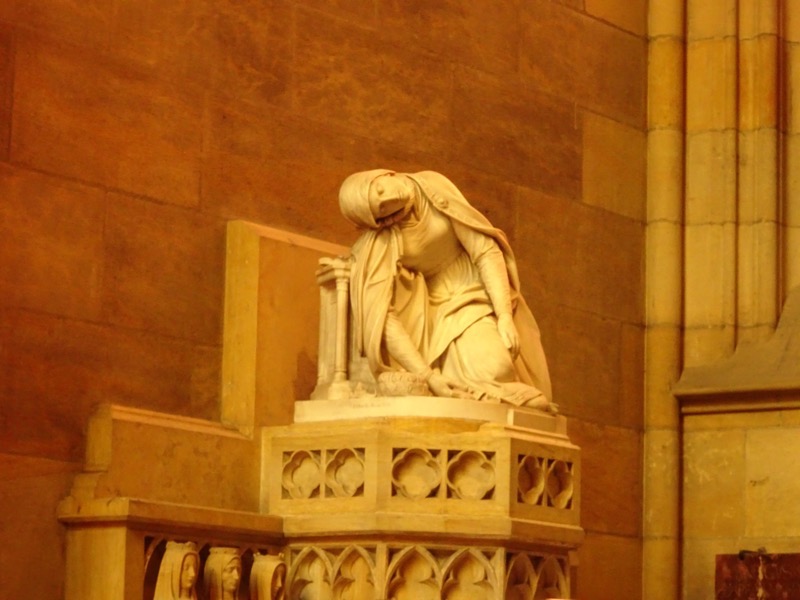
Strahov Monastery – Strahovský klášter – is a Premonstratensian abbey that was founded in the 12th century. According to Martin, it is not very exciting except they have a brewery there apparently…
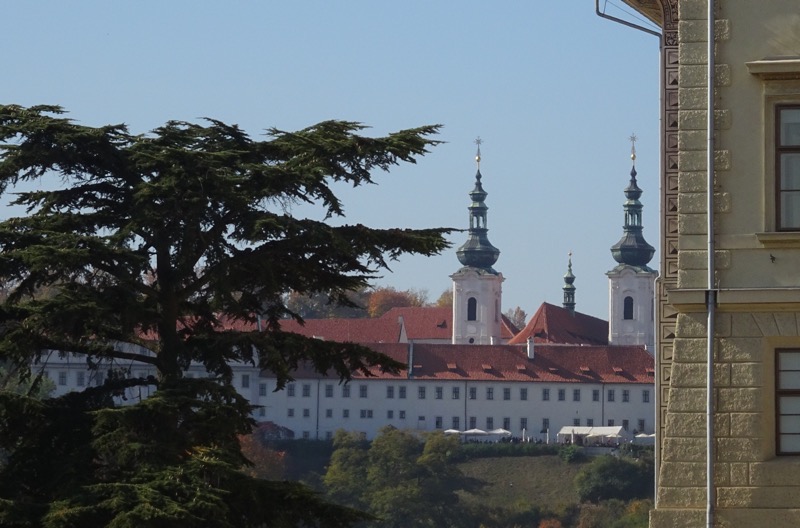 My faith in Martin is thoroughly shattered – I have just remembered that the famous Strahov library is there! Nothing there indeed. 😮
My faith in Martin is thoroughly shattered – I have just remembered that the famous Strahov library is there! Nothing there indeed. 😮
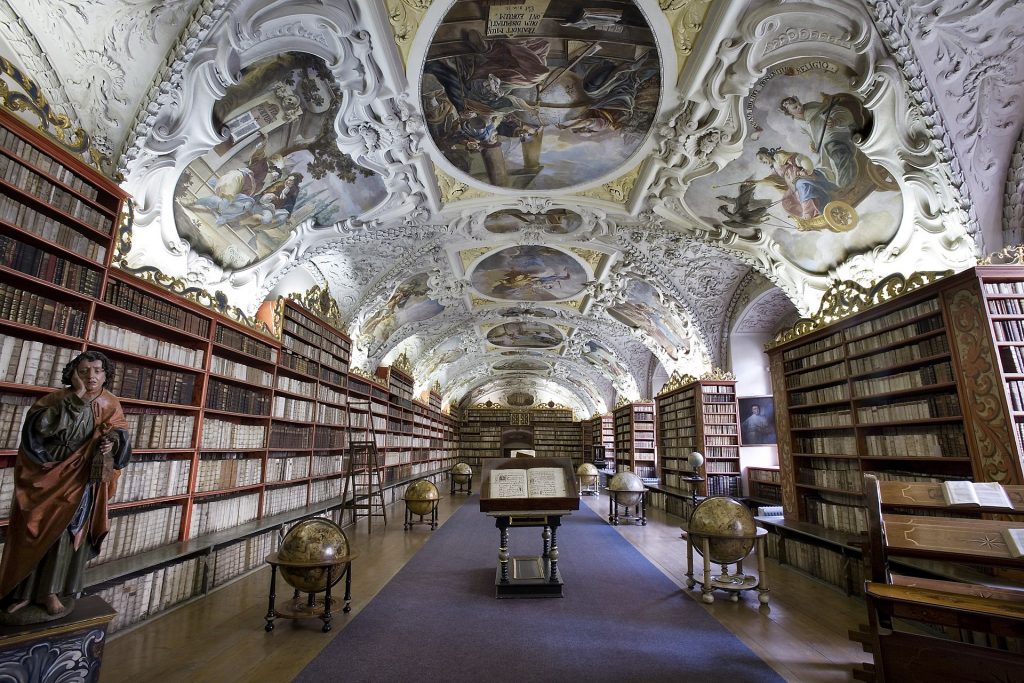
Image courtesy: Jorge Royan / http://www.royan.com.ar
There is a ‘Breathtaking Viewpoint’ out the exit of the Prague Castle which overlooks the entire city, however today with the unseasonal heat – at 23C it is about 7C warmer than usual for this time of year – there is a weird heat haze (yes, the Queenslanders scoffed appropriately) hanging in the air obscuring much of the view. We have been completely spoiled with the lovely light quality in Iceland, where even if it was overcast, raining and/or snowing, the landscapes were always visible.
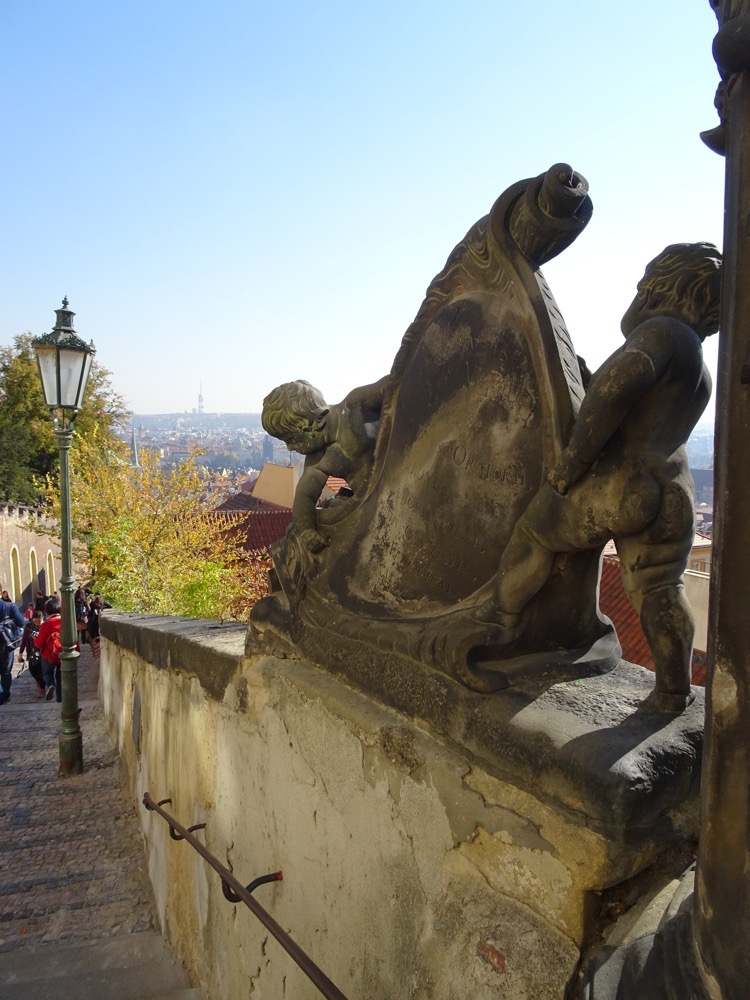 Next, it was the long march/trudge down the stairs to the Mala Strana, or Lesser Town area. The Lesser Town is a hillside area with views across the Vitava River towards the Old Town. Traditionally its streets have been lined with hotels, bars, pubs and casual eateries.
Next, it was the long march/trudge down the stairs to the Mala Strana, or Lesser Town area. The Lesser Town is a hillside area with views across the Vitava River towards the Old Town. Traditionally its streets have been lined with hotels, bars, pubs and casual eateries. 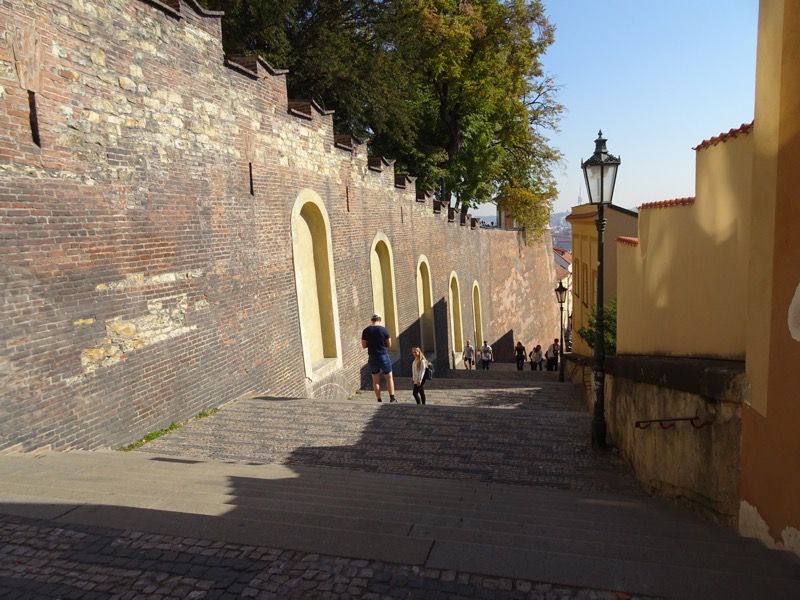 The Lesser Town was once a cluster of noble houses and small palaces that eventually formed into the city’s administrative and mercantile centre. Some of the famous landmarks here are the picturesque burger buildings of Nerudova Street and St Nicholas’ Church.
The Lesser Town was once a cluster of noble houses and small palaces that eventually formed into the city’s administrative and mercantile centre. Some of the famous landmarks here are the picturesque burger buildings of Nerudova Street and St Nicholas’ Church.
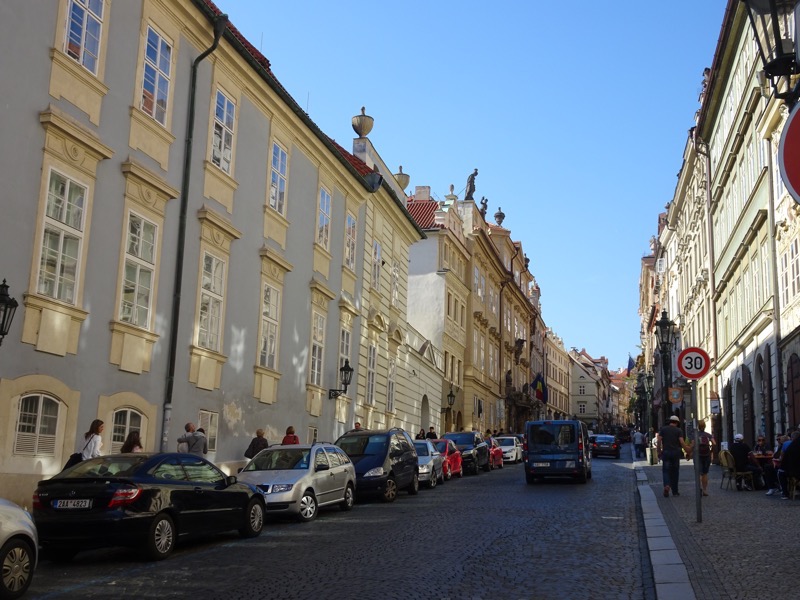
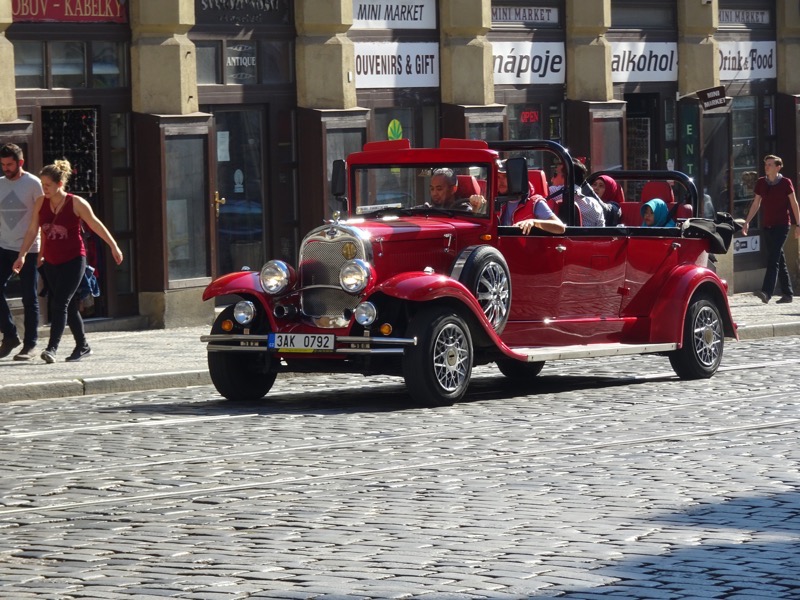 St. Nicholas Church (Kostel svateho Mikulase) was built in 1703-1755, on the site of an earlier Gothic church dating back to 1283. It is at the centre of the Lesser Town and is the largest Jesuit church founded in Prague.
St. Nicholas Church (Kostel svateho Mikulase) was built in 1703-1755, on the site of an earlier Gothic church dating back to 1283. It is at the centre of the Lesser Town and is the largest Jesuit church founded in Prague.
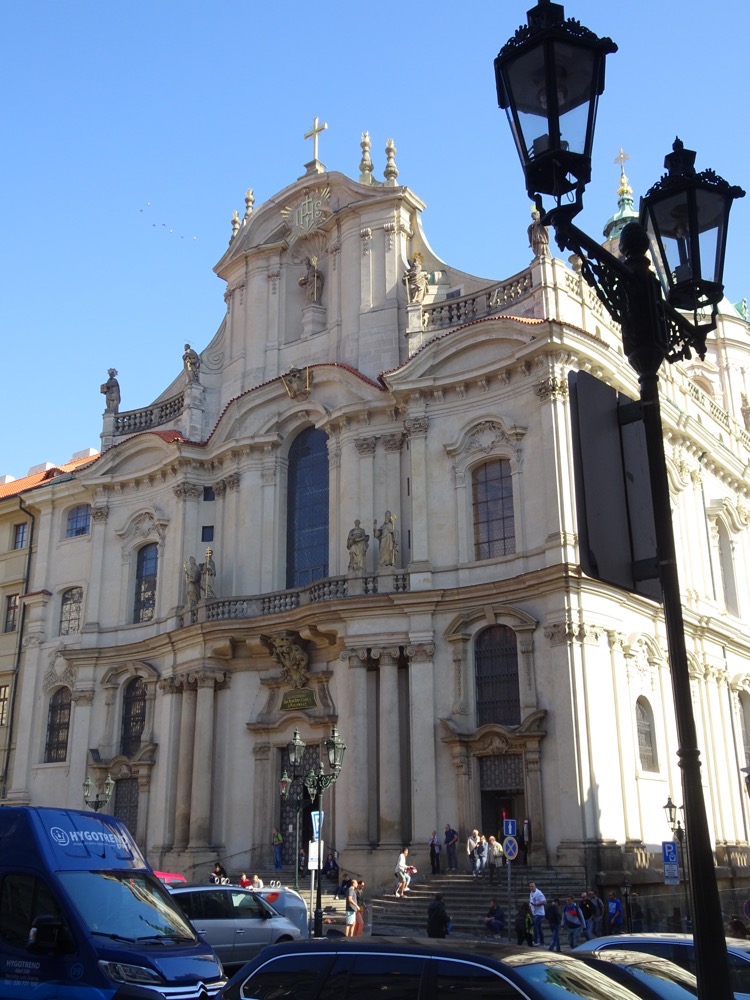
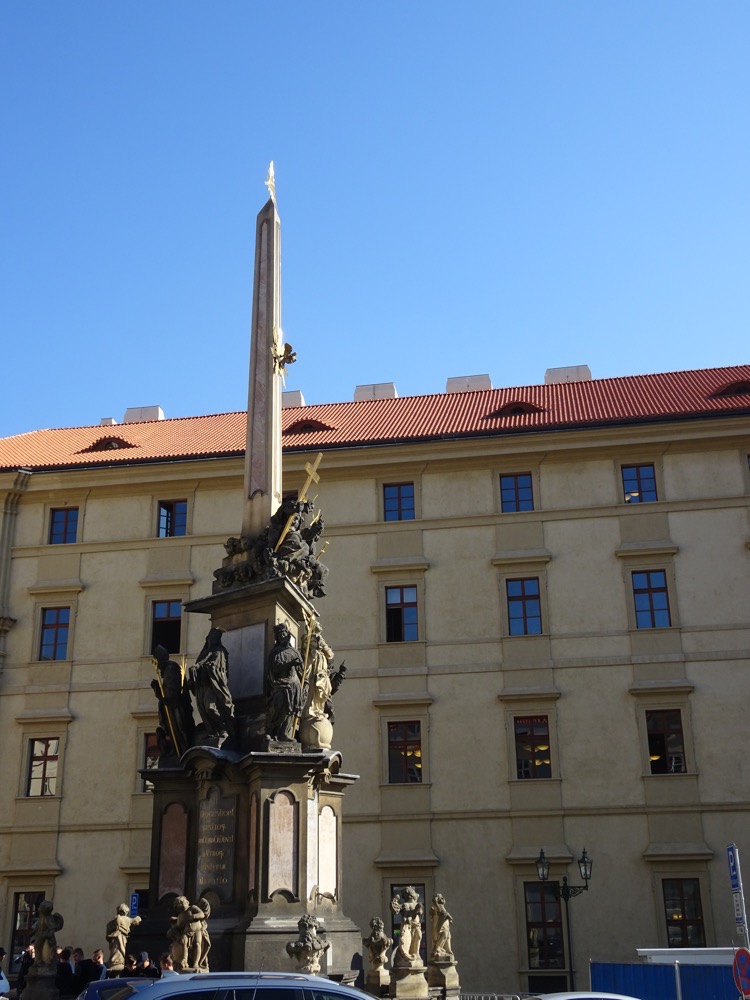 Not far down the road, you can find what our guide told us was the ‘Church of the Infant Jesus of Prague, but what is actually the Discalced Carmelite Church of Our Lady Victorious… *inside* is a statue of the Baby Jesus of Prague which legend claims once belonged to Saint Teresa of Avila.
Not far down the road, you can find what our guide told us was the ‘Church of the Infant Jesus of Prague, but what is actually the Discalced Carmelite Church of Our Lady Victorious… *inside* is a statue of the Baby Jesus of Prague which legend claims once belonged to Saint Teresa of Avila.
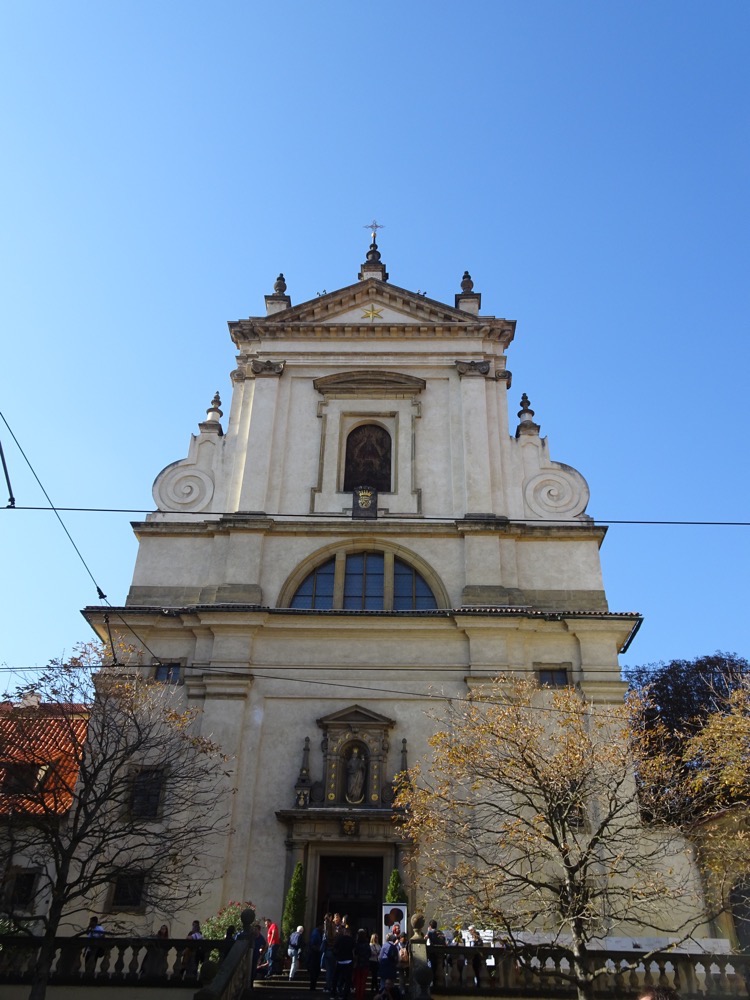
The statue is routinely dressed by the Carmelite nuns in luxurious fabrics, imperial regalia and wearing an elaborate crown. In 1639, the Swedish had begun a siege on Prague and alarmed residents rushed to the Baby Jesus statue praying for safety. As luck would have it, the army withdrew and the ‘miracle’ was attributed to the Infant Jesus and that’s how that became a ‘thing’. The Baby Jesus of Prague has a feast and a procession each year and everything. You can buy one in nearby shops – presumably to protect your home from invading Swedes.
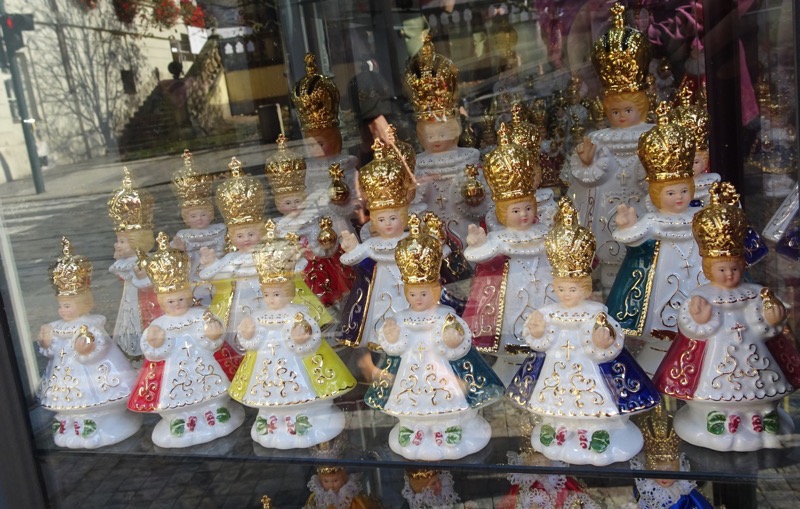 Next we scurried past the Knights of Malta
Next we scurried past the Knights of Malta
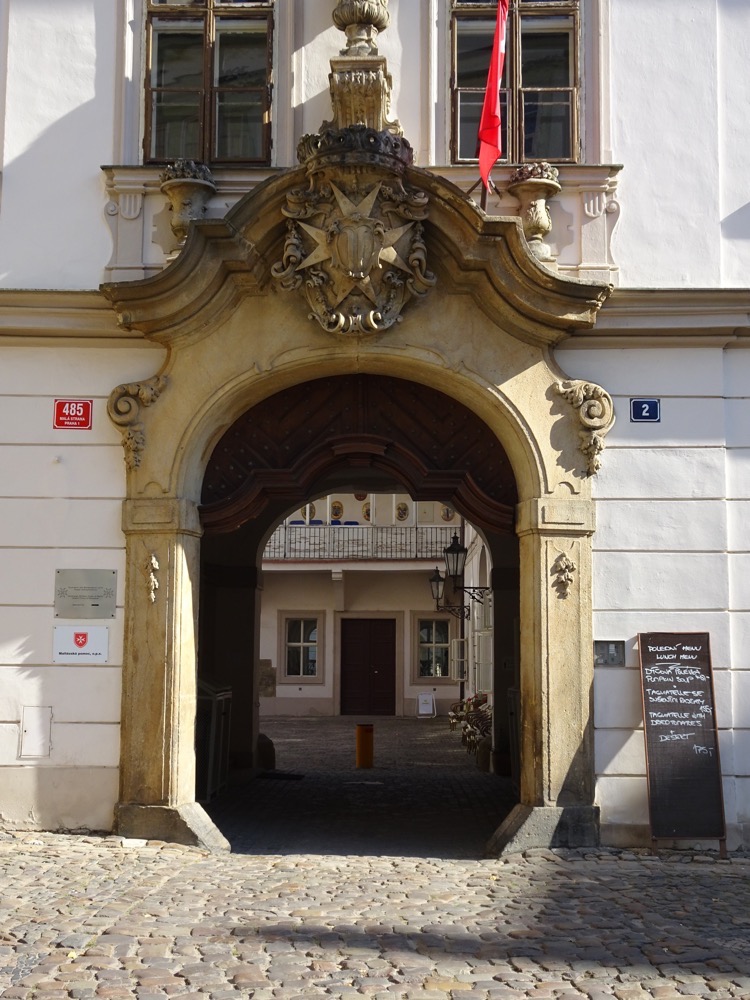 The John Lennon Wall is just a normal wall in a small square across from the French Embassy, however, since the 1980s it has been covered with John Lennon inspired graffiti and pieces of lyrics from Beatles’ songs. People started decorating the wall just after the 1980 assassination of the famous Beatle when an unknown artist painted a single portrait of John Lennon. Since then many people have contributed Lennon-esque images and texts to the wall. The original portrait is long gone under layers and layers of paint now, and once the authorities tried to clean up the wall, but within days the Lennon tributes were all back – so now it is tacitly condoned by the city.
The John Lennon Wall is just a normal wall in a small square across from the French Embassy, however, since the 1980s it has been covered with John Lennon inspired graffiti and pieces of lyrics from Beatles’ songs. People started decorating the wall just after the 1980 assassination of the famous Beatle when an unknown artist painted a single portrait of John Lennon. Since then many people have contributed Lennon-esque images and texts to the wall. The original portrait is long gone under layers and layers of paint now, and once the authorities tried to clean up the wall, but within days the Lennon tributes were all back – so now it is tacitly condoned by the city.
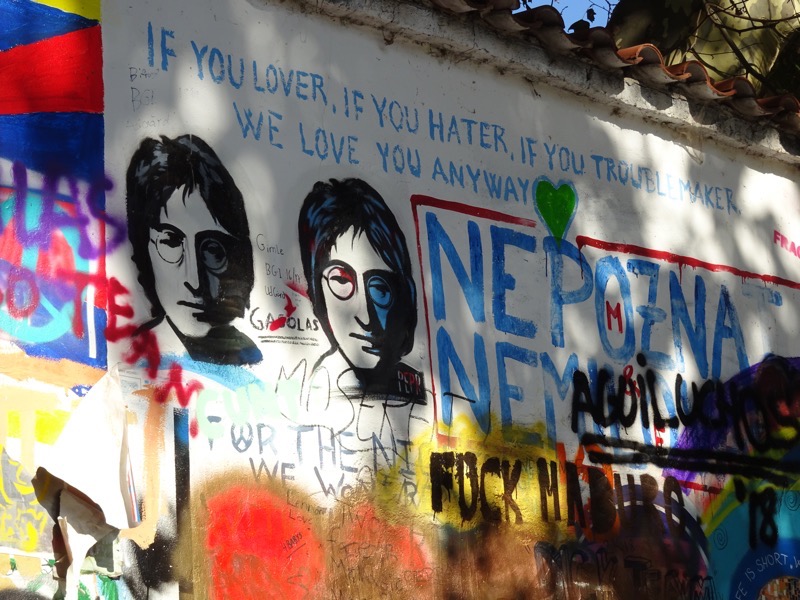
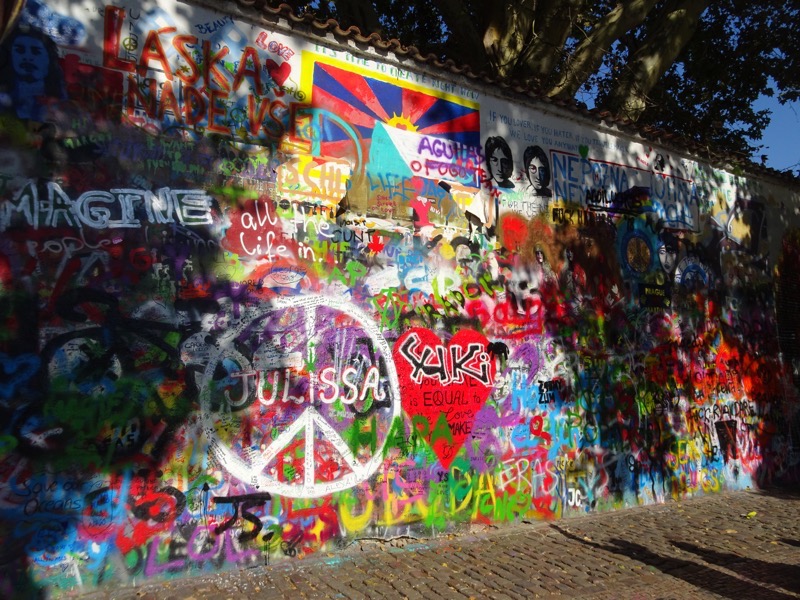
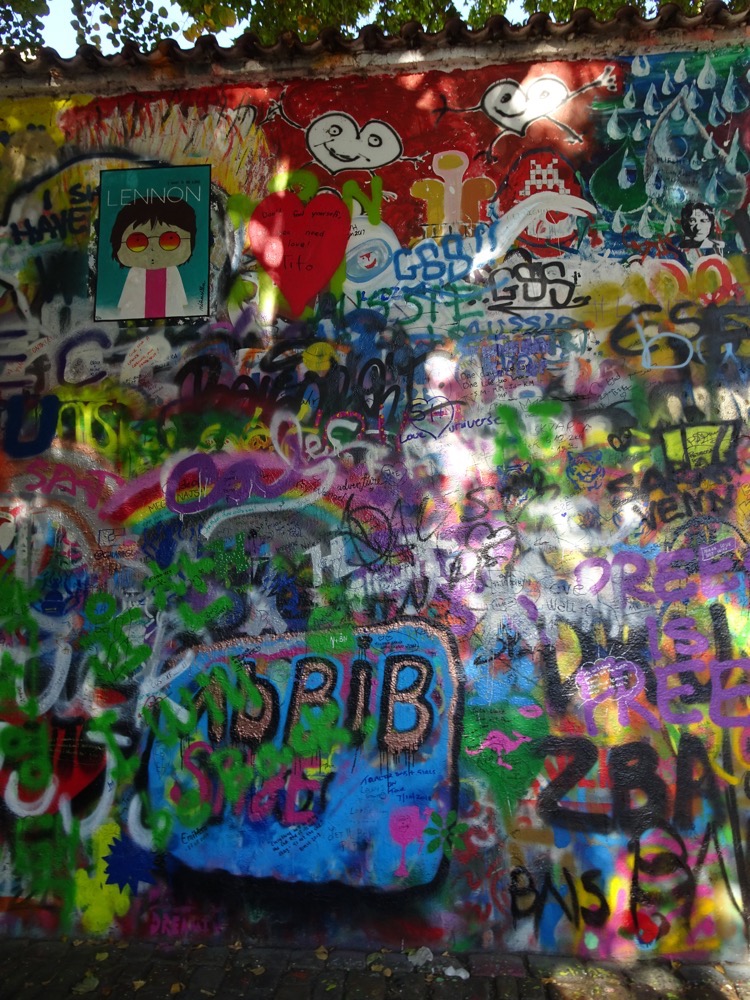
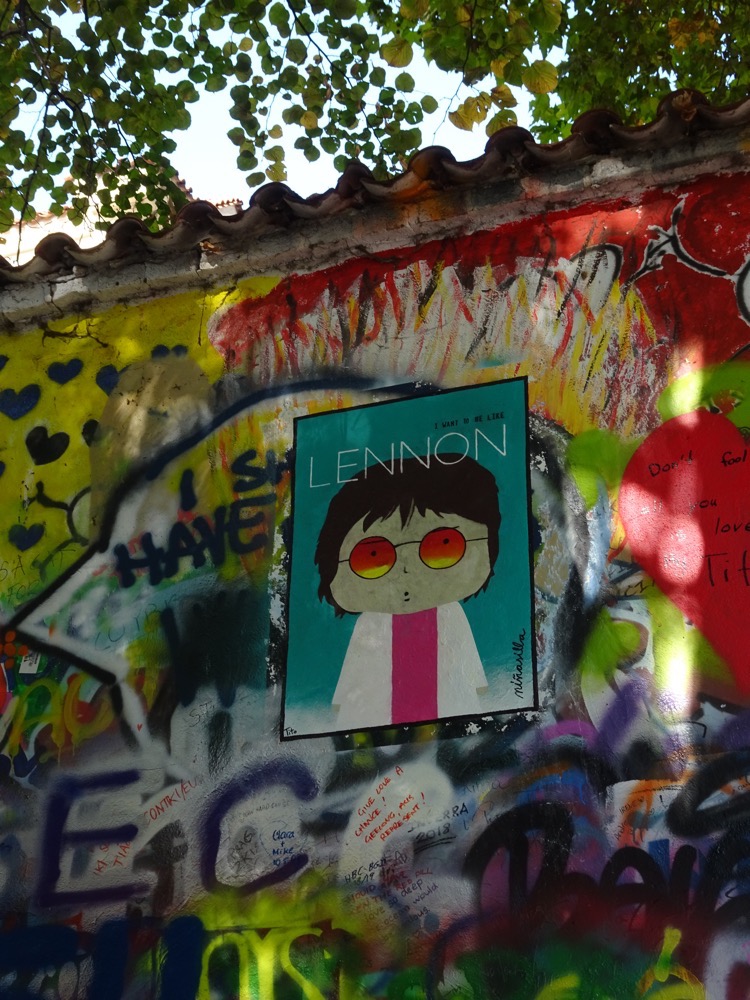
Certovka Canal, or Devil’s Canal was likely built by the Knights of Malta in the 12th century. The canal redirects water 750m from the Vitava river through several medieval mills, which were located along the course of the canal, before redirecting the water back to the River. The canal artificially created the island of Kampa. Lovers like to put locks on this bridge and to throw the keys into the canal, as a symbol of how enduring their love is – bound together forever as solid as these locks… it turns out local authorities tend to leave them a couple of months and then come along with bolt cutters and remove them all. Which is very generous considering that any locks that get attached to the Charles Bridge get removed every Tuesday.
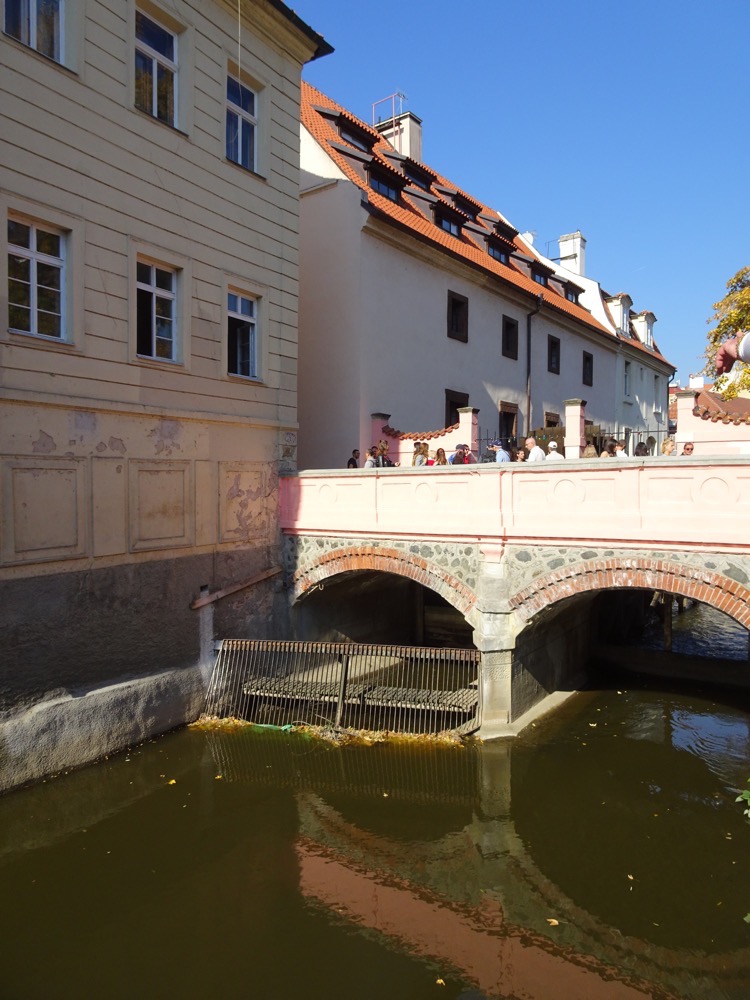
Kampa Island was named as the ‘campus’ by Spanish soldiers who camped here during the Battle of White Mountain in the 17th century (Swedes? Spanish? Has anyone *not* attempted to invade Prague?).
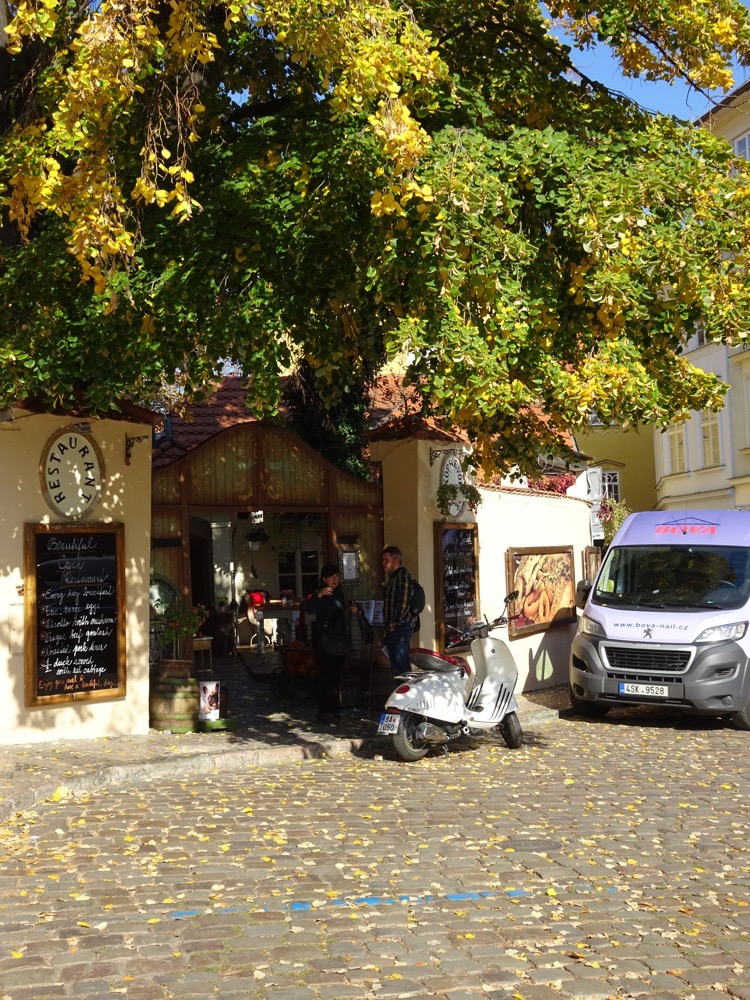
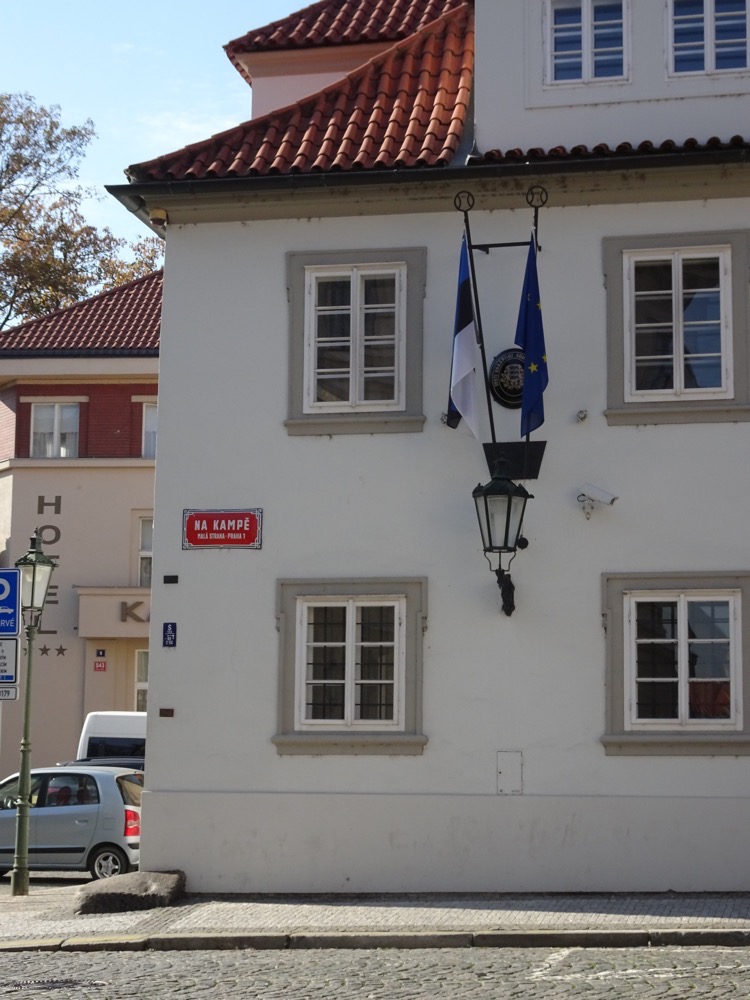 The image above shows some flood markers from the 2002 floods (black mark just under the red street sign) and the earlier floods of 1890. It isn’t really apparent from this photograph, but that top marker is a full 7.0m above the level of the bank of the river. The floods were devastating to the old buildings in the area. Many of the cheaper properties were never restored as Kampa was once some of the poorer real estate available on this side of the city, but now of course with all the heritage buildings retained and the undesirable dwellings replaced, it has become quite an expensive location – about 5,000 per square metre (though compared to say, Tokyo, that is still cheap as chips!). Apparently, AirBnB is also contributing to the rapidly rising housing prices in Prague, which is lament heard nearly everywhere these days.
The image above shows some flood markers from the 2002 floods (black mark just under the red street sign) and the earlier floods of 1890. It isn’t really apparent from this photograph, but that top marker is a full 7.0m above the level of the bank of the river. The floods were devastating to the old buildings in the area. Many of the cheaper properties were never restored as Kampa was once some of the poorer real estate available on this side of the city, but now of course with all the heritage buildings retained and the undesirable dwellings replaced, it has become quite an expensive location – about 5,000 per square metre (though compared to say, Tokyo, that is still cheap as chips!). Apparently, AirBnB is also contributing to the rapidly rising housing prices in Prague, which is lament heard nearly everywhere these days. 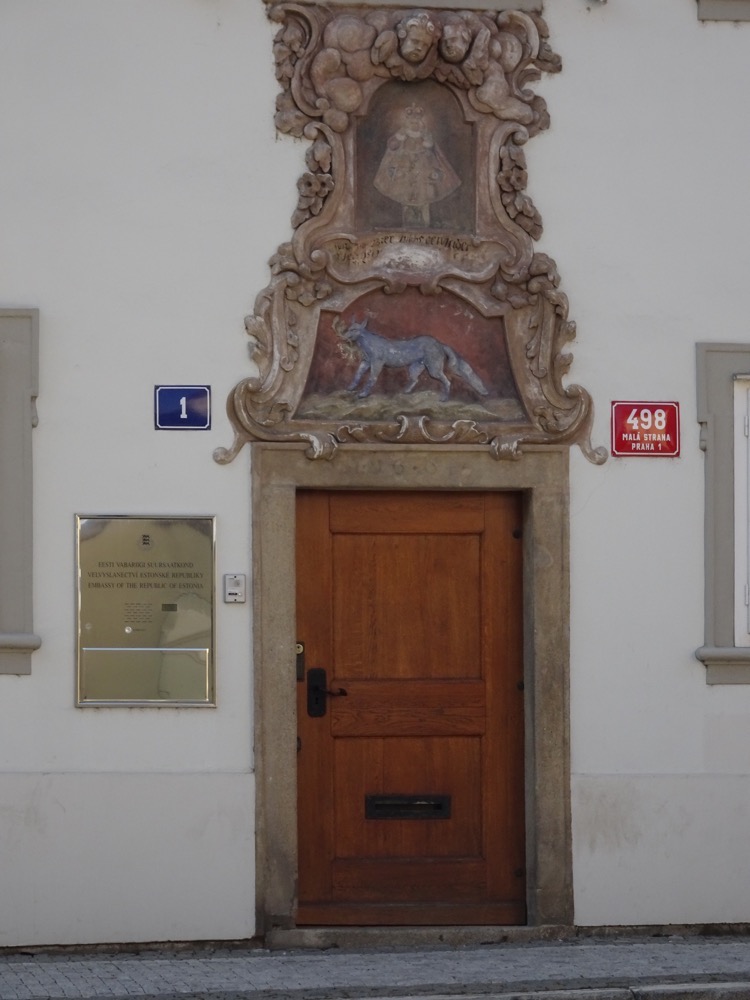 This building would once have been known as the Blue Fox, and in this part of town, there would only have one blue fox building, one red fox building, one green fox building etc. Prior to universal education being introduced in the 20th century, much of Prague was illiterate and so no formal system of numbers and names existed for street addresses. To send something to this house you would have addressed it merely to Blue Fox House, Kampa Island.
This building would once have been known as the Blue Fox, and in this part of town, there would only have one blue fox building, one red fox building, one green fox building etc. Prior to universal education being introduced in the 20th century, much of Prague was illiterate and so no formal system of numbers and names existed for street addresses. To send something to this house you would have addressed it merely to Blue Fox House, Kampa Island. 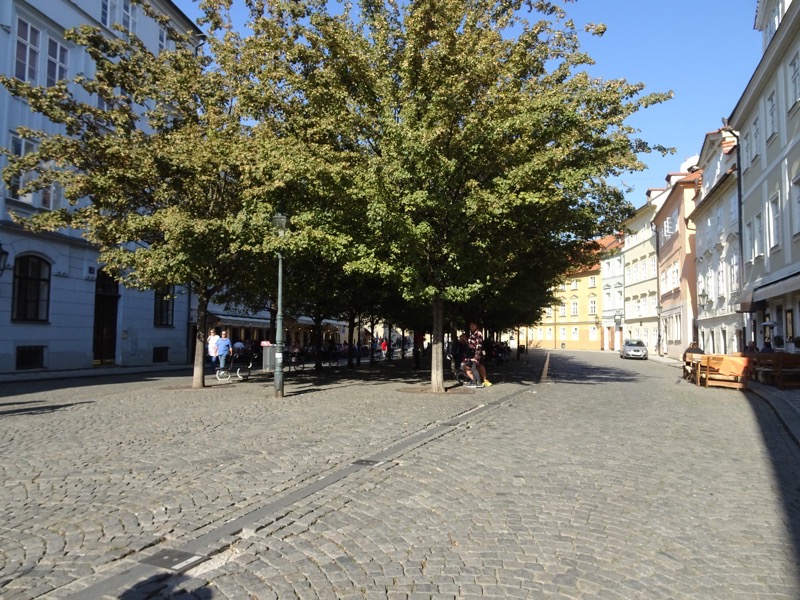 As a result of the devastating floods, a system of flood protection has been implemented on the river banks of the Vitava. These steel tracks allow for a 7-metre high fence to be erected to protect the city against future catastrophic flooding incidents. Every three years, the barriers are tested and constructed. It takes only 3 hours from alarms being sounded to the flood barriers being in place. This is the second line of defence flood barriers as there is another row like this directly beside the river bank.
As a result of the devastating floods, a system of flood protection has been implemented on the river banks of the Vitava. These steel tracks allow for a 7-metre high fence to be erected to protect the city against future catastrophic flooding incidents. Every three years, the barriers are tested and constructed. It takes only 3 hours from alarms being sounded to the flood barriers being in place. This is the second line of defence flood barriers as there is another row like this directly beside the river bank.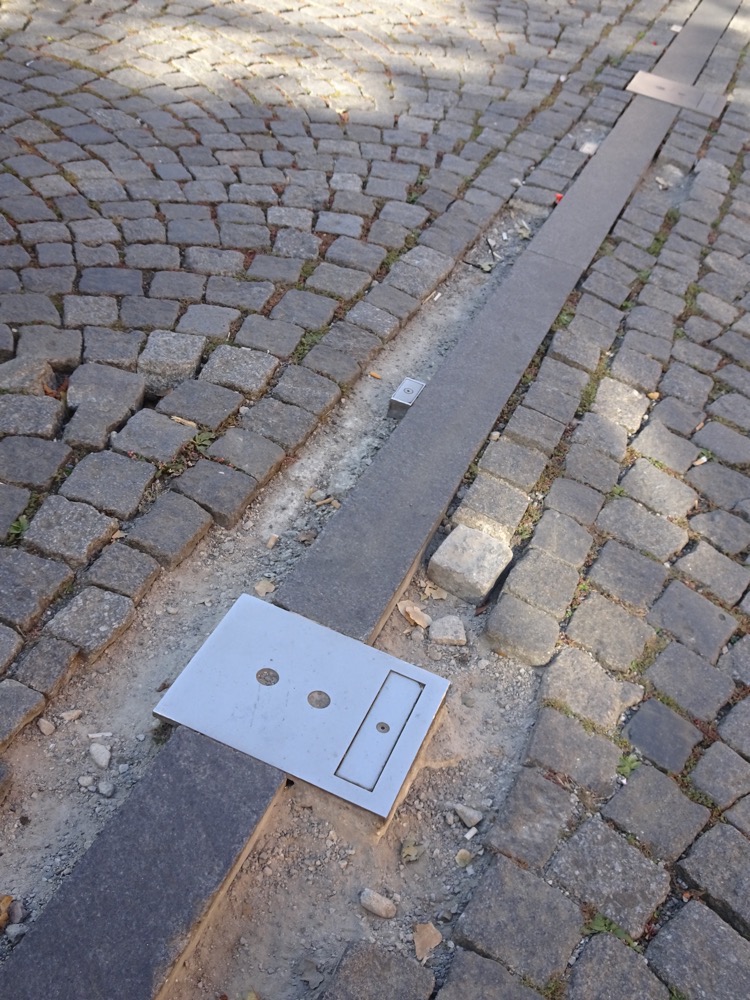 By now we had been walking on the harsh cobblestones for about three hours, and even though yale and I were the youngest in our small group tour of fourteen, we were feeling really weary from navigating the uneven surfaces. Our guide was wearing sturdy boots and trudged on relentlessly, but some of our fellow tourists were wearing seemingly sensible walking shoes, but not really cut out for this sort of thing. Thankfully, the program had a cruise on the Vitava planned for us next, and we were all shepherded onto a long low riverboat for a 45 minute rest break and some views of the city from the river.
By now we had been walking on the harsh cobblestones for about three hours, and even though yale and I were the youngest in our small group tour of fourteen, we were feeling really weary from navigating the uneven surfaces. Our guide was wearing sturdy boots and trudged on relentlessly, but some of our fellow tourists were wearing seemingly sensible walking shoes, but not really cut out for this sort of thing. Thankfully, the program had a cruise on the Vitava planned for us next, and we were all shepherded onto a long low riverboat for a 45 minute rest break and some views of the city from the river.
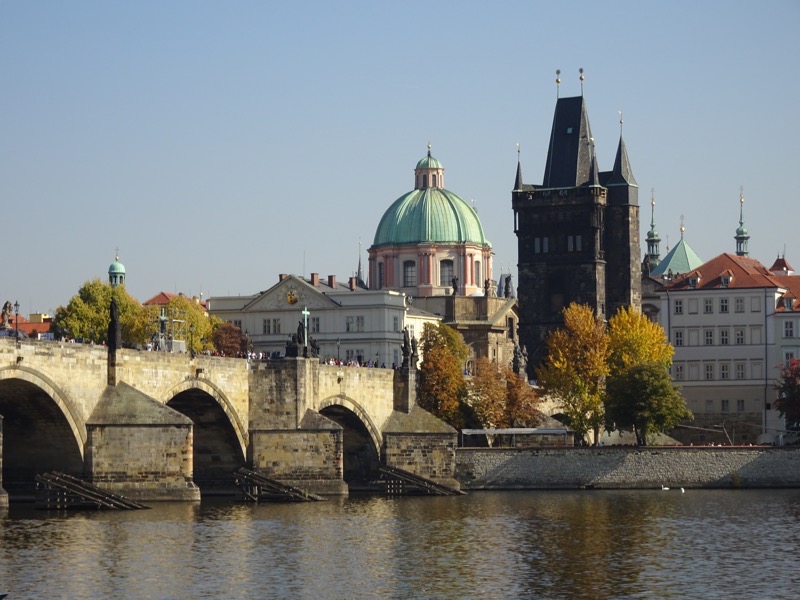
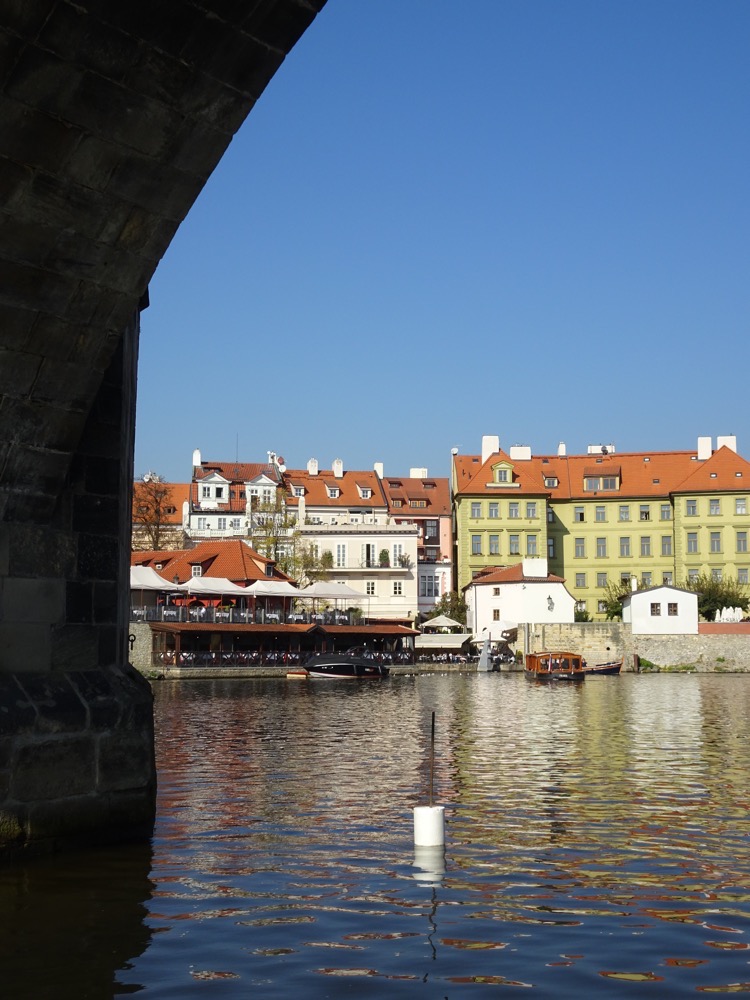
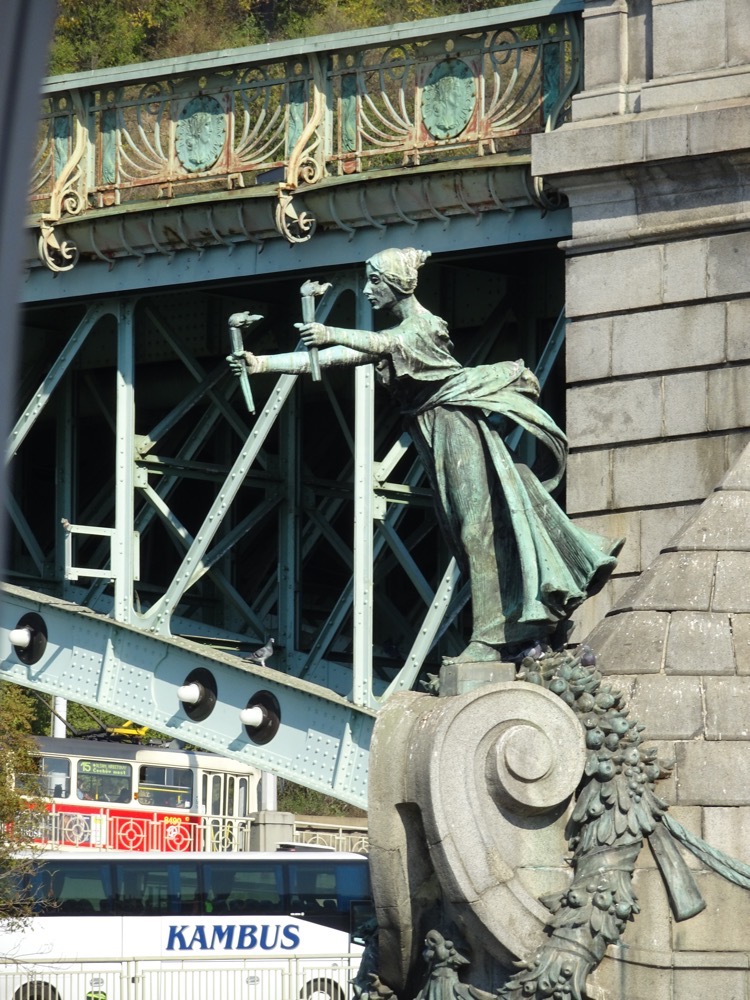
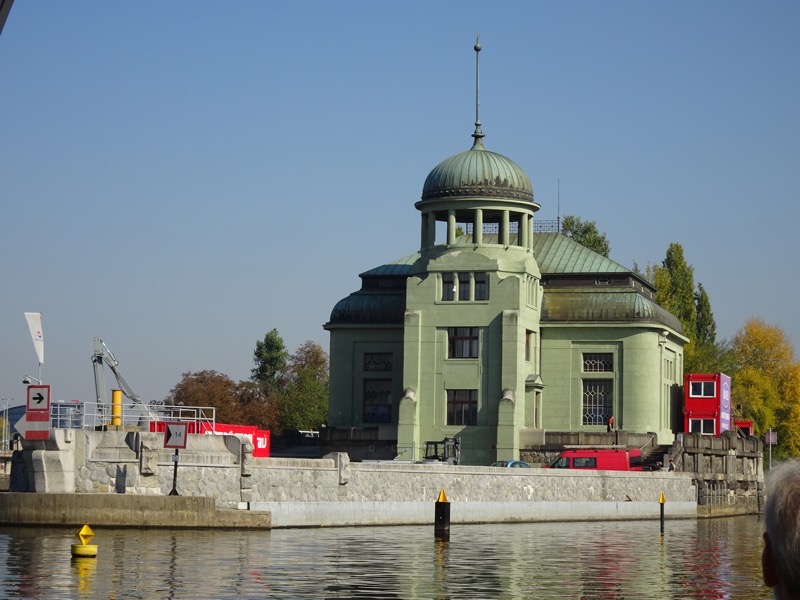
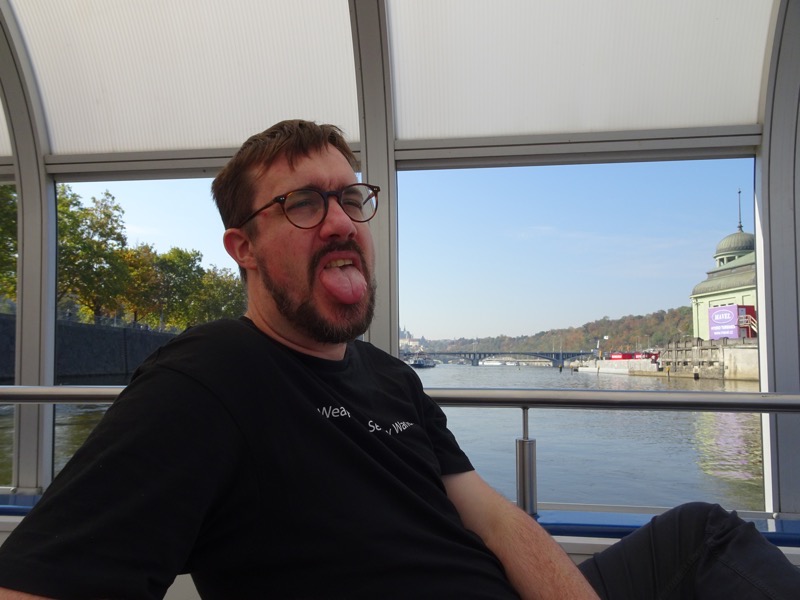
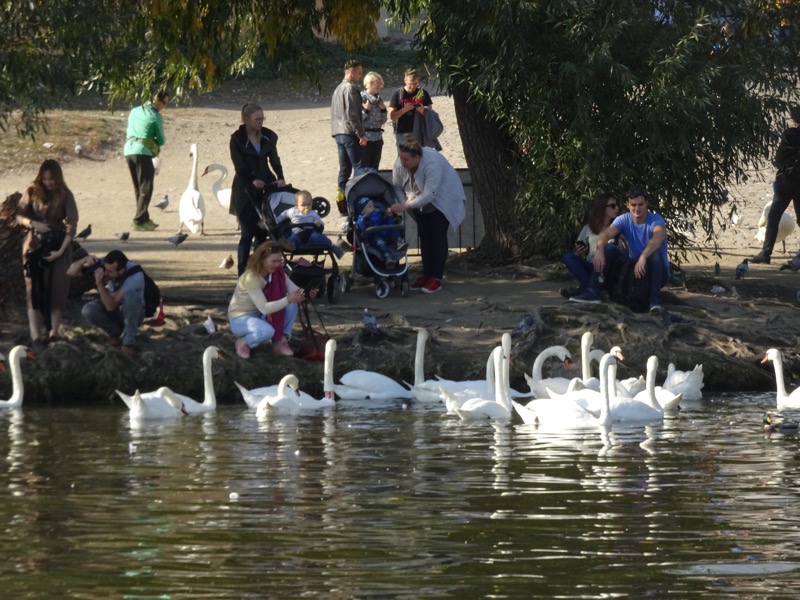
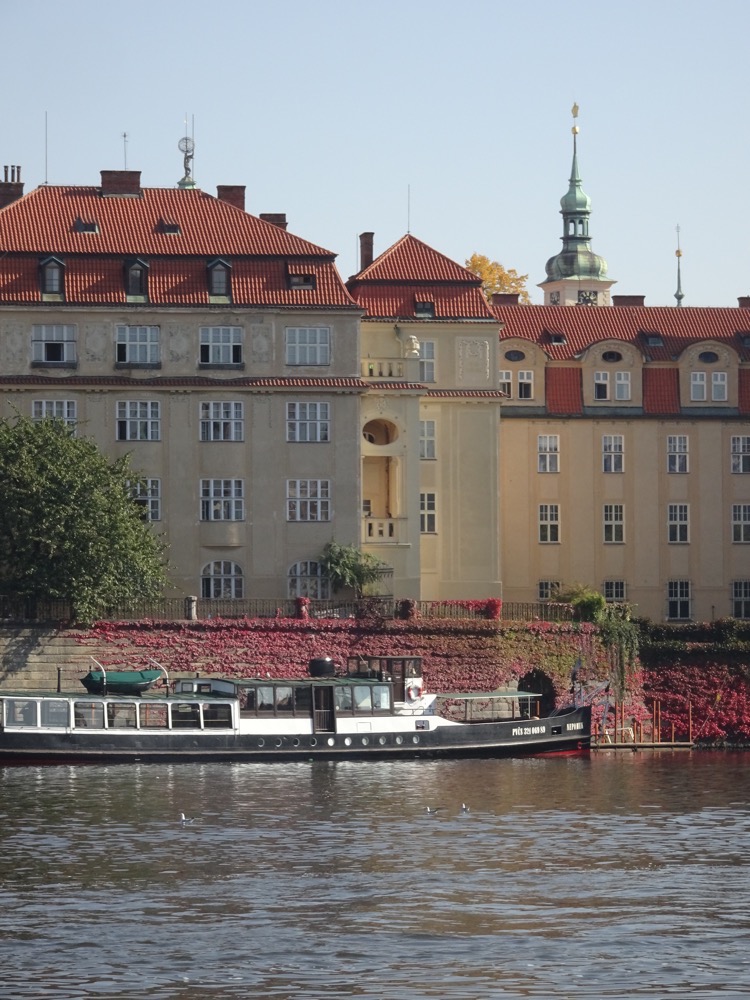
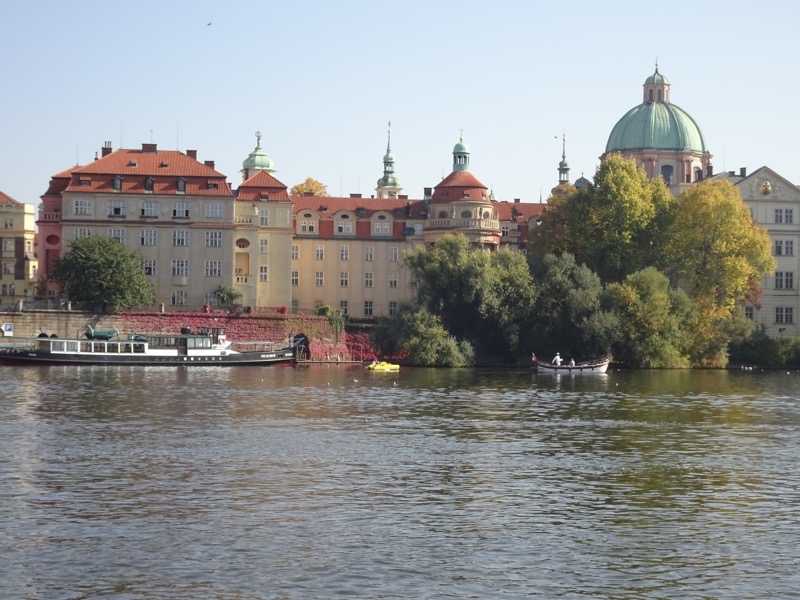 The Charles Bridge is probably the most famous bridge over the Vitava River. It is also the only pedestrian-only bridge crossing between the Prague Castle Complex to the Prague Old Town. Construction on the Charles Bridge began in 1357 under the direction of King Charles IV and was not finished until the beginning of the 15th century. At that time it was the only means of crossing the river and so it became an important trading connection not only between the Prague Old Town and the Caste Complex but it benefited the trade routes between Eastern and Western Europe in the middle ages.
The Charles Bridge is probably the most famous bridge over the Vitava River. It is also the only pedestrian-only bridge crossing between the Prague Castle Complex to the Prague Old Town. Construction on the Charles Bridge began in 1357 under the direction of King Charles IV and was not finished until the beginning of the 15th century. At that time it was the only means of crossing the river and so it became an important trading connection not only between the Prague Old Town and the Caste Complex but it benefited the trade routes between Eastern and Western Europe in the middle ages.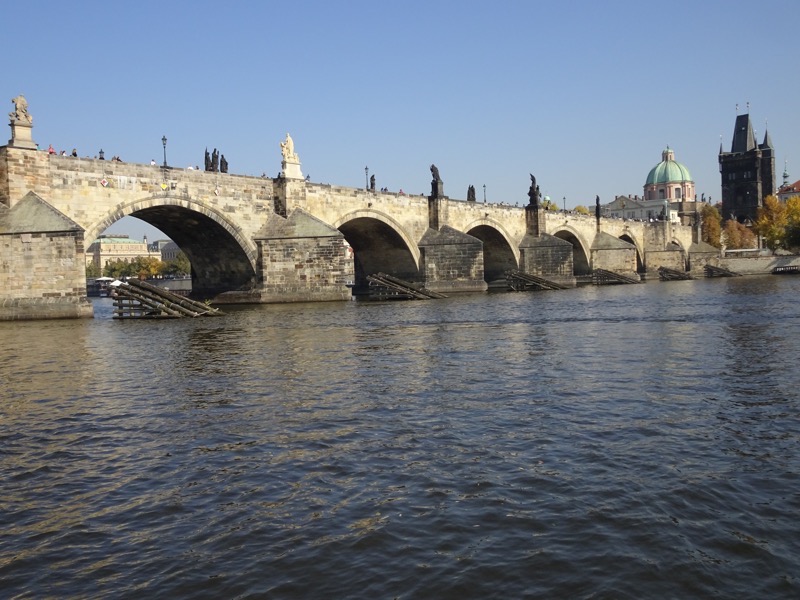 The long-bow style bridge has 16 archways and is 621m long and roughly 10m wide. Each of the pylons of the arches is protected by timber ice guards to protect the pylons from ice in the winter time. However, these are largely decorative now. Since a hydroelectric plant was built upriver in the 1950s, the water temperature never gets cold enough to actually freeze anymore, which means no more large chunks of ice crashing into the bridge pylons. Apparently in winter when the ambient temperature can reach as low as -15C, the river at its coldest will only see a low of about 3C meaning the water keeps flowing and never freezes over – you can apparently see steam rising from the 3C water as it is such a contrast with the air temperature it appears ‘warm’.
The long-bow style bridge has 16 archways and is 621m long and roughly 10m wide. Each of the pylons of the arches is protected by timber ice guards to protect the pylons from ice in the winter time. However, these are largely decorative now. Since a hydroelectric plant was built upriver in the 1950s, the water temperature never gets cold enough to actually freeze anymore, which means no more large chunks of ice crashing into the bridge pylons. Apparently in winter when the ambient temperature can reach as low as -15C, the river at its coldest will only see a low of about 3C meaning the water keeps flowing and never freezes over – you can apparently see steam rising from the 3C water as it is such a contrast with the air temperature it appears ‘warm’.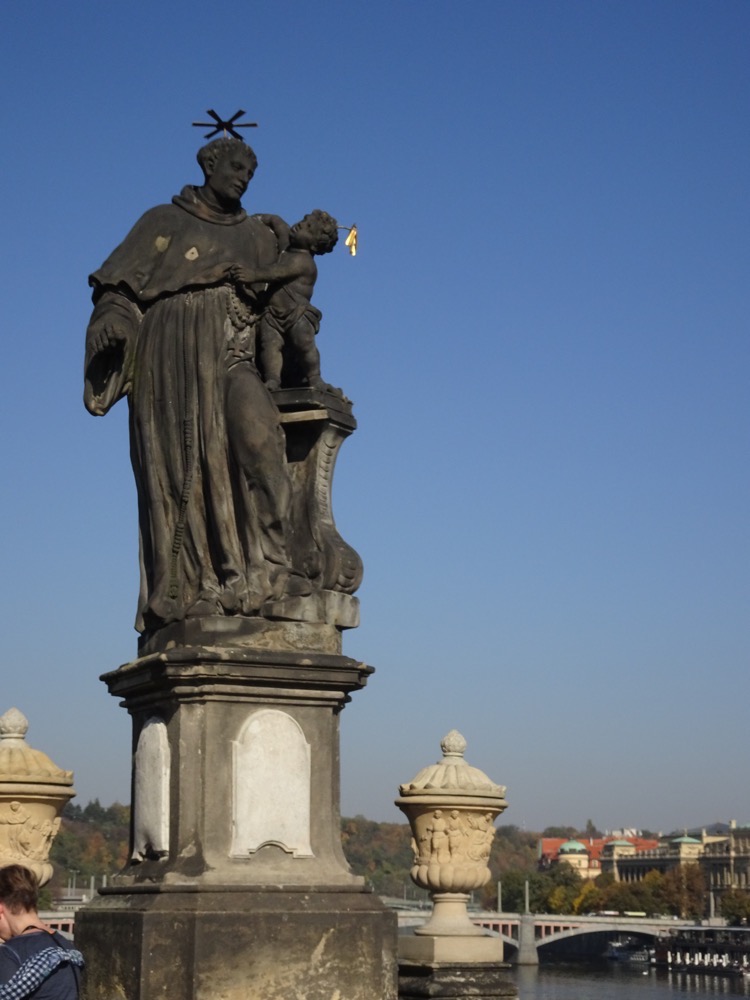 The bridge is decorated on both sides by the ‘largest outdoor sculpture gallery in Europe’, with a continuous alley of 30 baroque statues, (I tend to disagree with Martin here – I have been to Vigeland Park in Oslo, and it blows this away for sheer size and on number of exhibits). Most of the statues were erected in 1700 but have nearly all been replaced by modern replicas now as the sandstone oxidises over time and wears away. Statue of St. John of Nepomuk…
The bridge is decorated on both sides by the ‘largest outdoor sculpture gallery in Europe’, with a continuous alley of 30 baroque statues, (I tend to disagree with Martin here – I have been to Vigeland Park in Oslo, and it blows this away for sheer size and on number of exhibits). Most of the statues were erected in 1700 but have nearly all been replaced by modern replicas now as the sandstone oxidises over time and wears away. Statue of St. John of Nepomuk…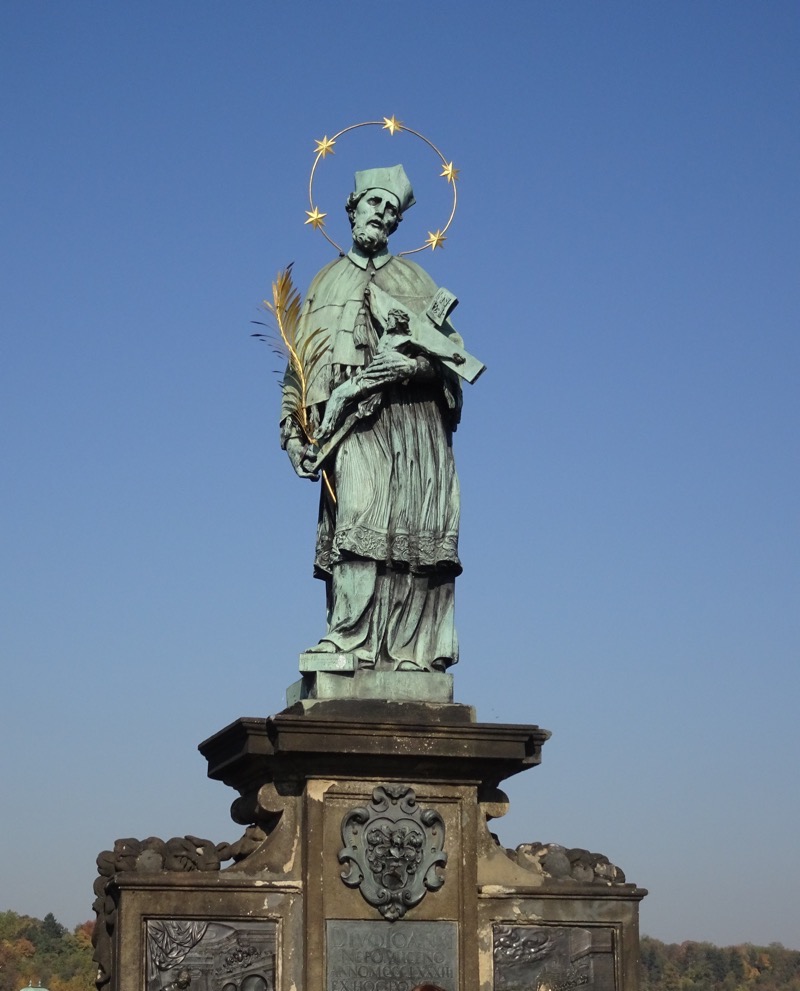 John of Nepomuk was a priest in Prague around the time of King Wenceslas IV (son of the aforementioned, Charles IV). He was also the Queen’s personal confessor. Unfortunately for Father John, the King was a rather suspicious man and he demanded of John of Nepomuk to know all the Queen’s secrets. True to the sanctity of the confessional, the priest would now reveal the Queen’s confessions, so Wenceslas had Nepomuk executed by being thrown into the Vltava River from the bridge, whereupon he drowned.
John of Nepomuk was a priest in Prague around the time of King Wenceslas IV (son of the aforementioned, Charles IV). He was also the Queen’s personal confessor. Unfortunately for Father John, the King was a rather suspicious man and he demanded of John of Nepomuk to know all the Queen’s secrets. True to the sanctity of the confessional, the priest would now reveal the Queen’s confessions, so Wenceslas had Nepomuk executed by being thrown into the Vltava River from the bridge, whereupon he drowned.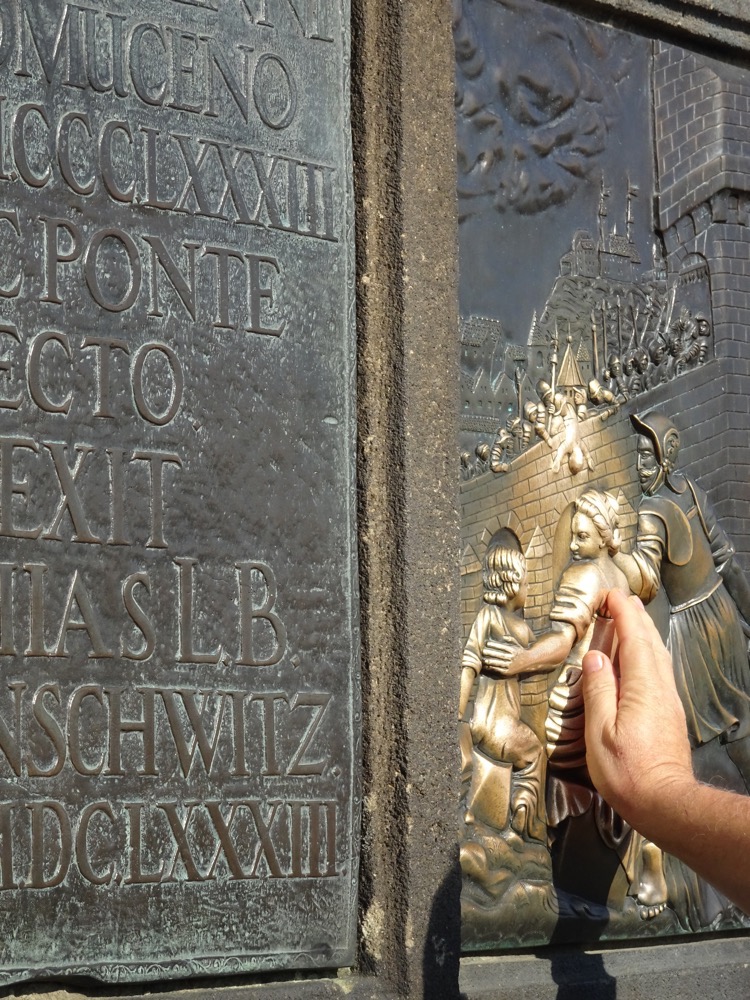 Today visitors come to touch the image of the falling priest on the plaque, which is supposed to bring good luck and ensure that you will return to Prague one day. Others have taken to touching the puppy in the adjoining plaque which is supposed to bring good luck with the ladies.
Today visitors come to touch the image of the falling priest on the plaque, which is supposed to bring good luck and ensure that you will return to Prague one day. Others have taken to touching the puppy in the adjoining plaque which is supposed to bring good luck with the ladies.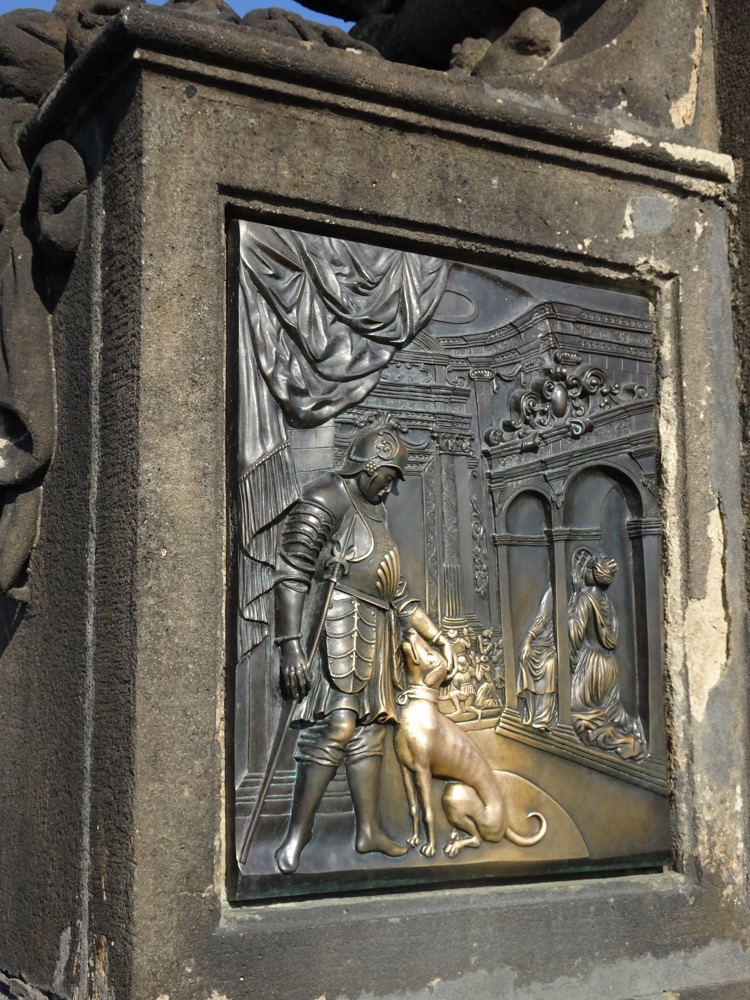 Further down the bridge is a ‘Touch The Cross And Make A Wish point! All it is missing is a coin slot. It is said that your wish will come true within a year and one day if you touch this almost rubbed smooth wishing spot.
Further down the bridge is a ‘Touch The Cross And Make A Wish point! All it is missing is a coin slot. It is said that your wish will come true within a year and one day if you touch this almost rubbed smooth wishing spot.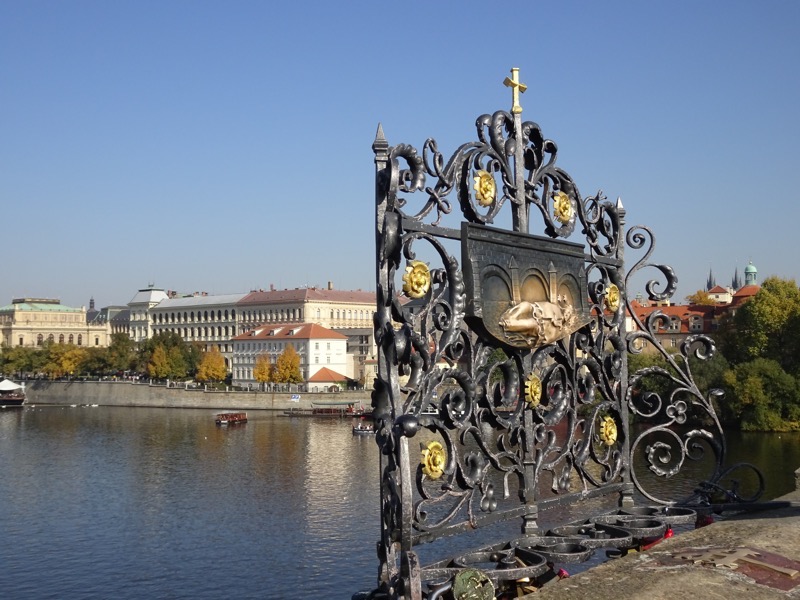
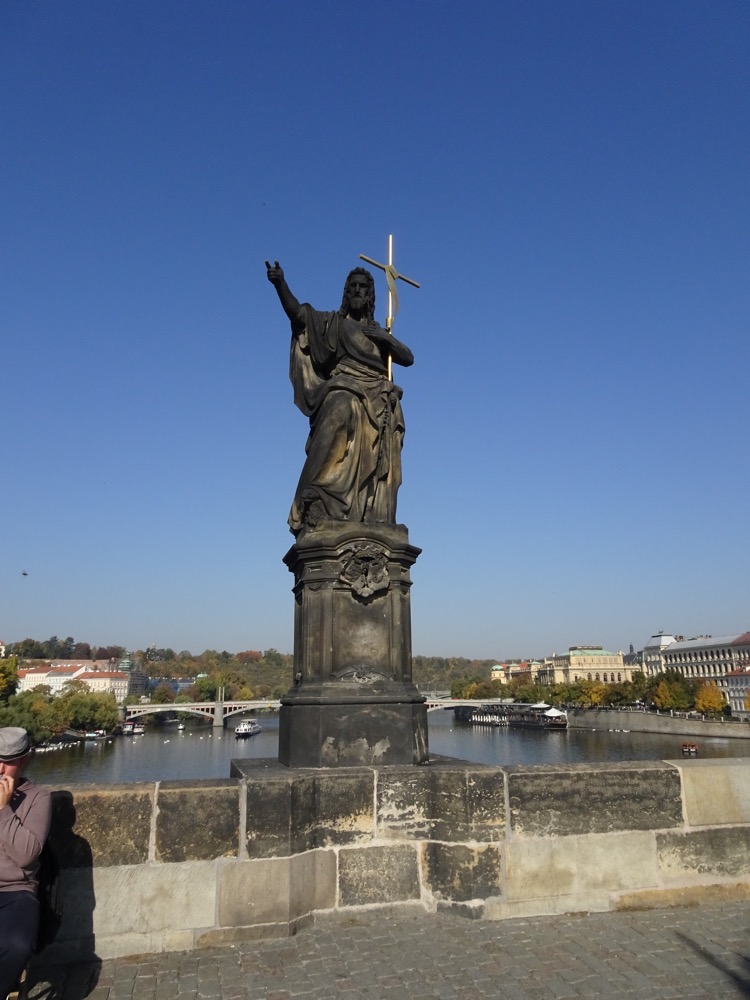
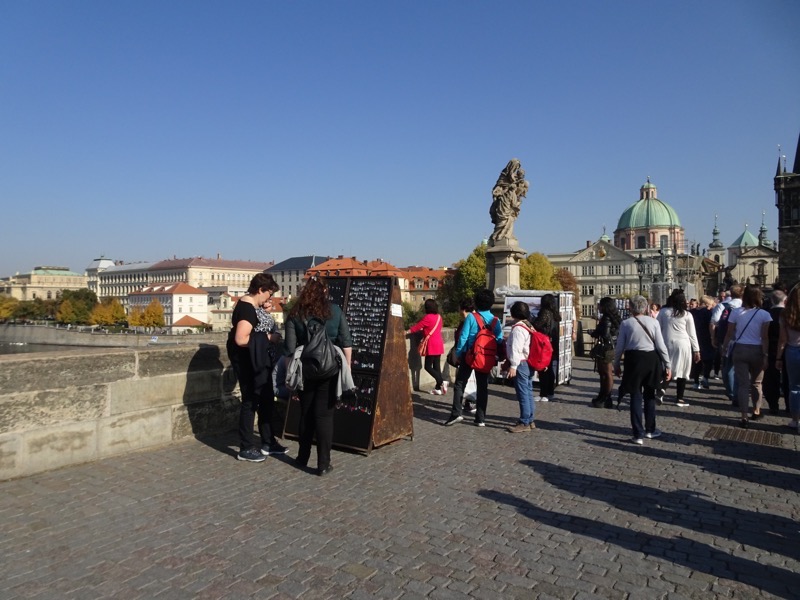 Old Town Bridge Tower It was built in the late 14th century, also during the rule of the Emperor Charles IV.
Old Town Bridge Tower It was built in the late 14th century, also during the rule of the Emperor Charles IV. 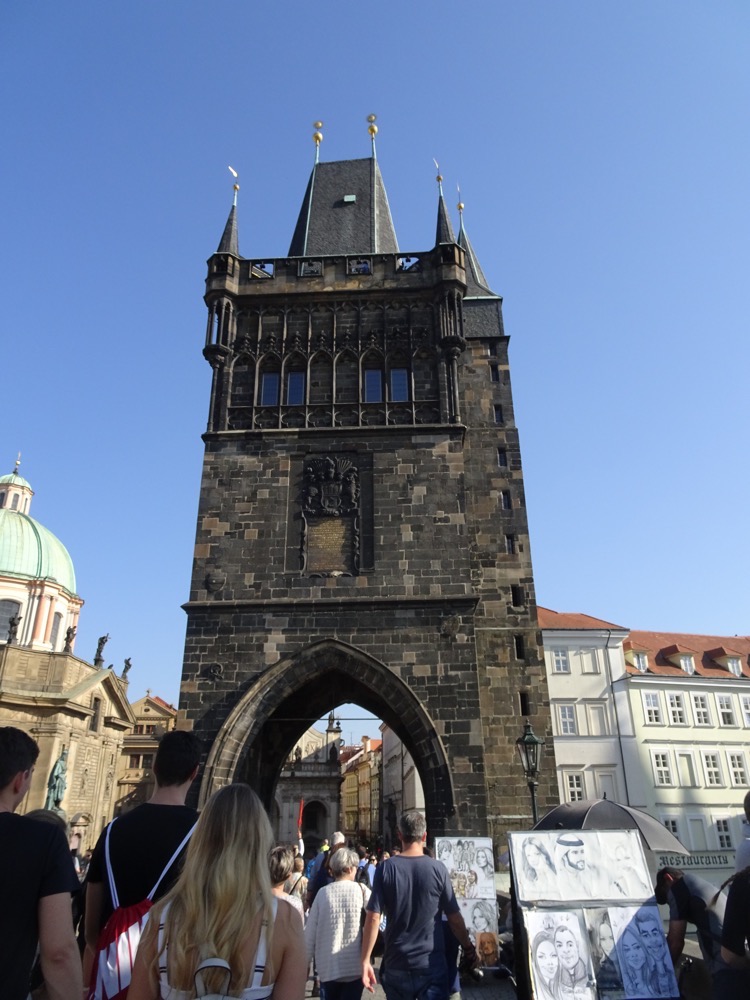
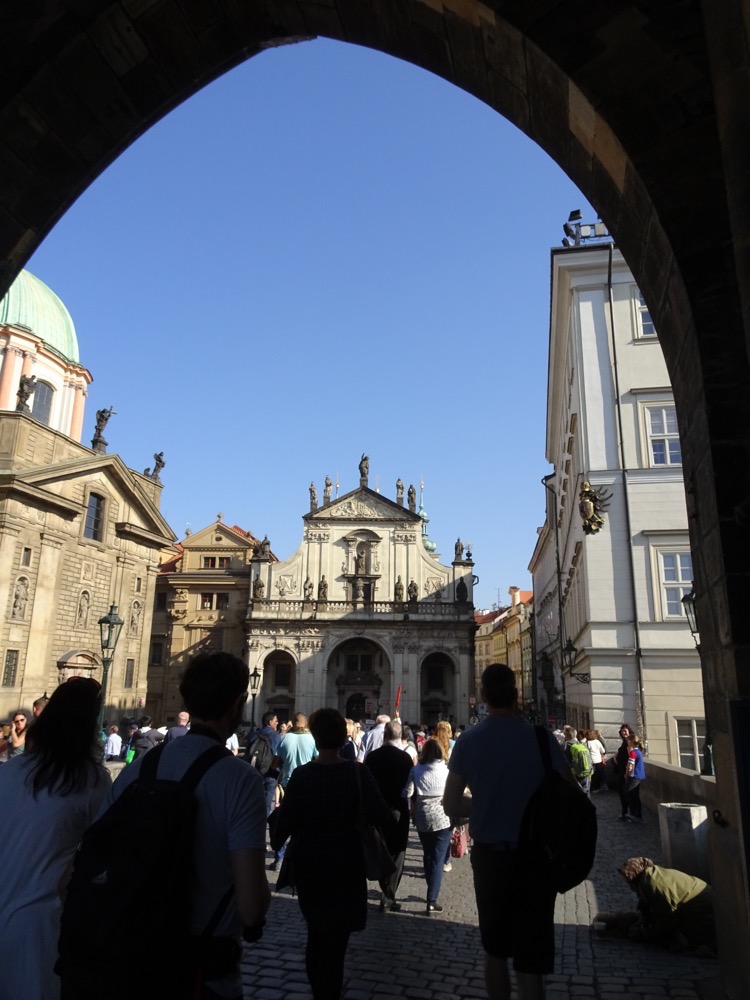 Directly ahead of us as we exited under the Old Town Bridge Tower is a chapel that was dedicated to Saint Clement in the 11th century. A Dominican monastery was founded here in the medieval period, which was transformed in 1556 to a Jesuit college. In 1622, the Jesuits transferred the library of Charles University to the Klementinum, and the college was merged with the University in 1654. The Jesuits remained here until 1773, when the Klementinum was established primarily as an observatory, library, and university by the Empress Maria Theresa of Austria (Ah, I remember her well – the Empress Maria Theresia and the Emperor Franz Josef from whom nearly all Europe’s royalty descended).
Directly ahead of us as we exited under the Old Town Bridge Tower is a chapel that was dedicated to Saint Clement in the 11th century. A Dominican monastery was founded here in the medieval period, which was transformed in 1556 to a Jesuit college. In 1622, the Jesuits transferred the library of Charles University to the Klementinum, and the college was merged with the University in 1654. The Jesuits remained here until 1773, when the Klementinum was established primarily as an observatory, library, and university by the Empress Maria Theresa of Austria (Ah, I remember her well – the Empress Maria Theresia and the Emperor Franz Josef from whom nearly all Europe’s royalty descended).
Anyway, back to the Clementium – beautiful building, hosts plenty of classical music concerts now, with professional musicians and Mozart may or may not have played here (depending on whether or not Martin is as reliable as he is supposed to be).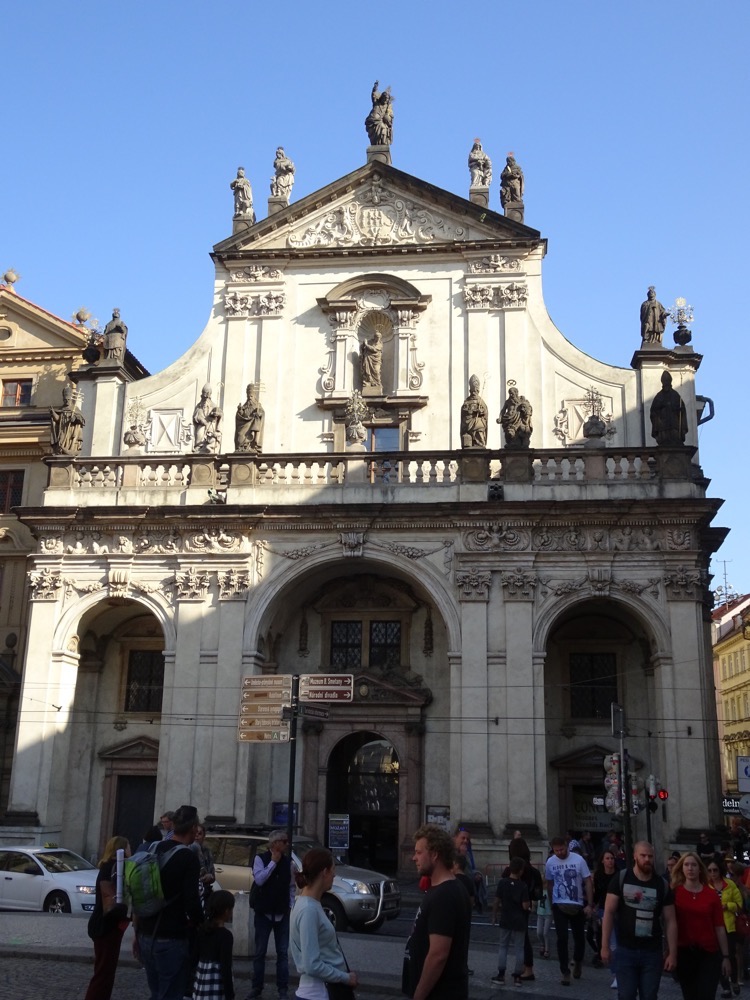 So finally, we reach the Old Town area which has the real jewel of Prague in it – the famous Pražský Orloj, or Prague Astronomical Clock. I am so taken with this incredible artwork and it’s long historythat I chose our hotel directly across the Old Town Square so we could see it from our windows. Having stayed in Rome with a view of the Trevi Fountain, I have come to the realisation that paying a little extra for a couple of nights accommodation in that one special place can leave a lasting impression. On this trip, it was here – at the clock so we could enjoy it at various times of the day and from above the melee of the tourists that mill about from 8am to past midnight.
So finally, we reach the Old Town area which has the real jewel of Prague in it – the famous Pražský Orloj, or Prague Astronomical Clock. I am so taken with this incredible artwork and it’s long historythat I chose our hotel directly across the Old Town Square so we could see it from our windows. Having stayed in Rome with a view of the Trevi Fountain, I have come to the realisation that paying a little extra for a couple of nights accommodation in that one special place can leave a lasting impression. On this trip, it was here – at the clock so we could enjoy it at various times of the day and from above the melee of the tourists that mill about from 8am to past midnight.
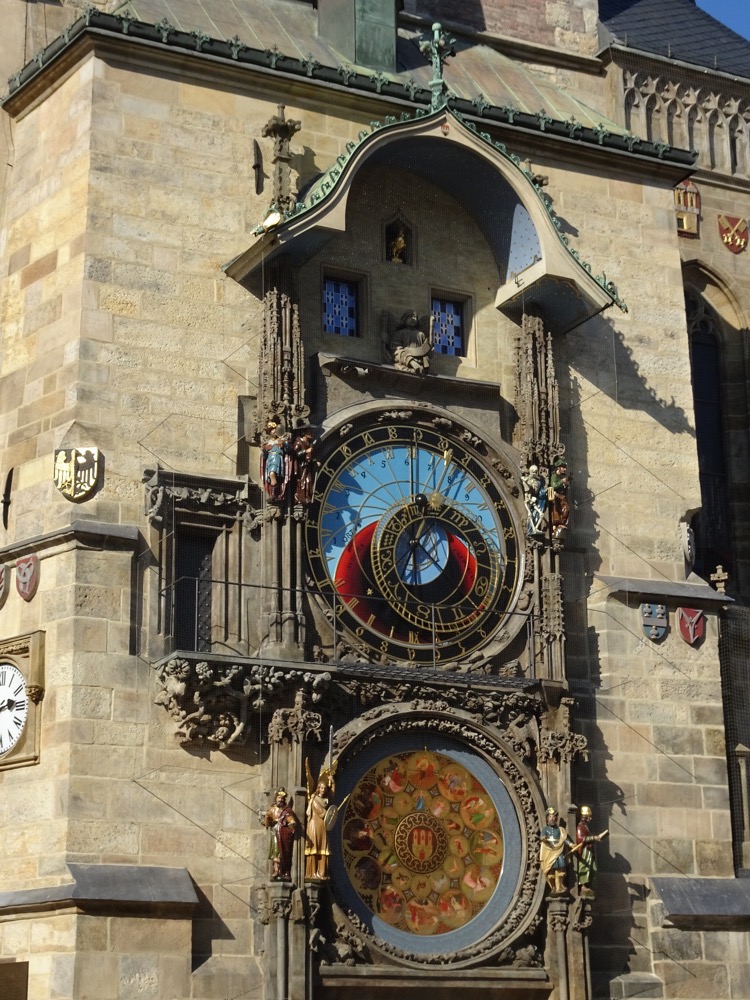 The Prague astronomical clock has literally only just come back on display after being under scaffold from for most of the year. It resumed operations barely two weeks ago at 6pm local time on 28 September 2018.
The Prague astronomical clock has literally only just come back on display after being under scaffold from for most of the year. It resumed operations barely two weeks ago at 6pm local time on 28 September 2018.
The oldest part of the Orloj, the mechanical clock and astronomical dial, dates back to 1410 when it was made by clockmaker Mikuláš of Kadaň and Jan Šindel. The first recorded mention of the just the clock itself was on 9 October 1410. Several decades later, around 1490, the calendar dial was added and the clock was decorated with gothic sculptures.
Originally it was believed that the Prague astronomical clock was made at that time in 1490 by a clockmaster named Jan Růže (also called Hanuš). There is now evidence that demonstrations this is historically inaccurate… the legend that was recounted to use when we visited Prague in 1995 was that the clockmaker Hanuš was blinded on the orders of the Councillors of Prague so that he could not repeat his amazing work for any neighbouring cities. The story went that Hanuš threw himself into the mechanisms of the clock, effectively disabling it and it remained unrepaired and inaccurate for over one hundred years… but it turns out this is more fable than fact.
It was 1552 before it was fully restored to function by Jan Taborský (ca 1500–1572), a master clockmaker who wrote a report mentioning Hanuš as the original maker of this clock. The clock has stopped working many times in the centuries since the mid 1550s 1552, and as such has been restored and repaired many times.
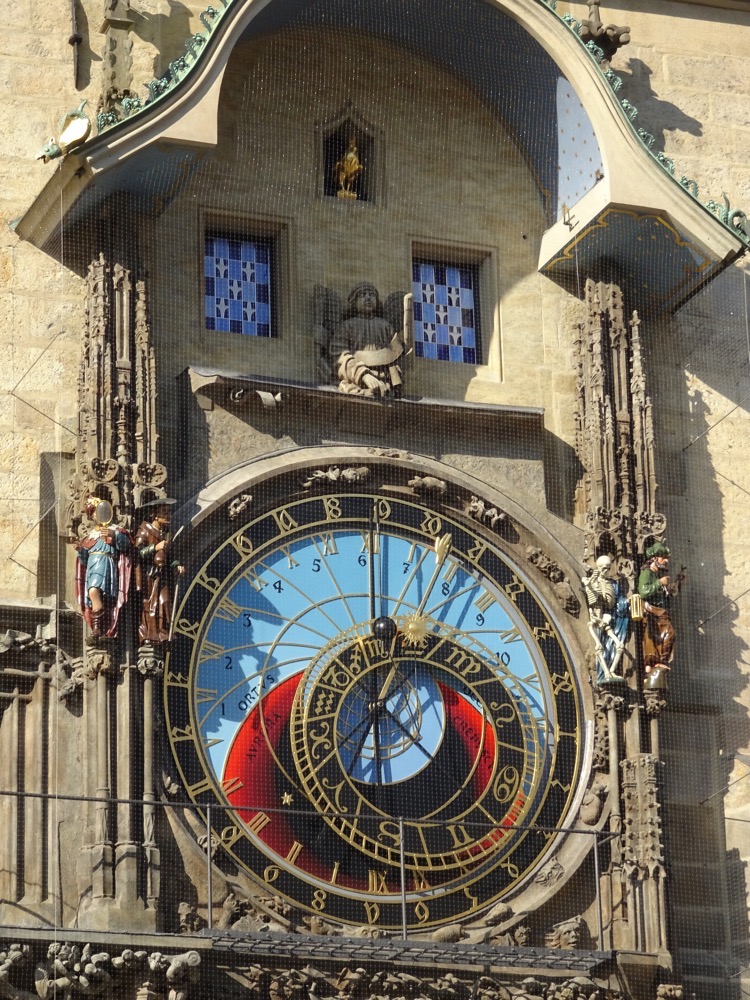 In 1629 to 1659 there were wooden statues added to the clock and some figures of the Apostles were later additions after yet another major repair in 1787–1791. The next major repair occurred in 1865–1866 and the craftsmen at that time added a golden crowing rooster to the decorations.
In 1629 to 1659 there were wooden statues added to the clock and some figures of the Apostles were later additions after yet another major repair in 1787–1791. The next major repair occurred in 1865–1866 and the craftsmen at that time added a golden crowing rooster to the decorations.
During WWII, the clock suffered heavy damage in 1945, during the Prague Uprising, – Nazis had fired on the Old Town Square from armoured vehicles in an attempt to destroy the uprising, unsuccessfully. The main hall and several nearby buildings were burned along with many of the wooden sculptures on the clock and the calendar dial face. Huge efforts were required to fix the machinery and recreate the wooden sculptures and the clock was once again back in commission in late 1948.
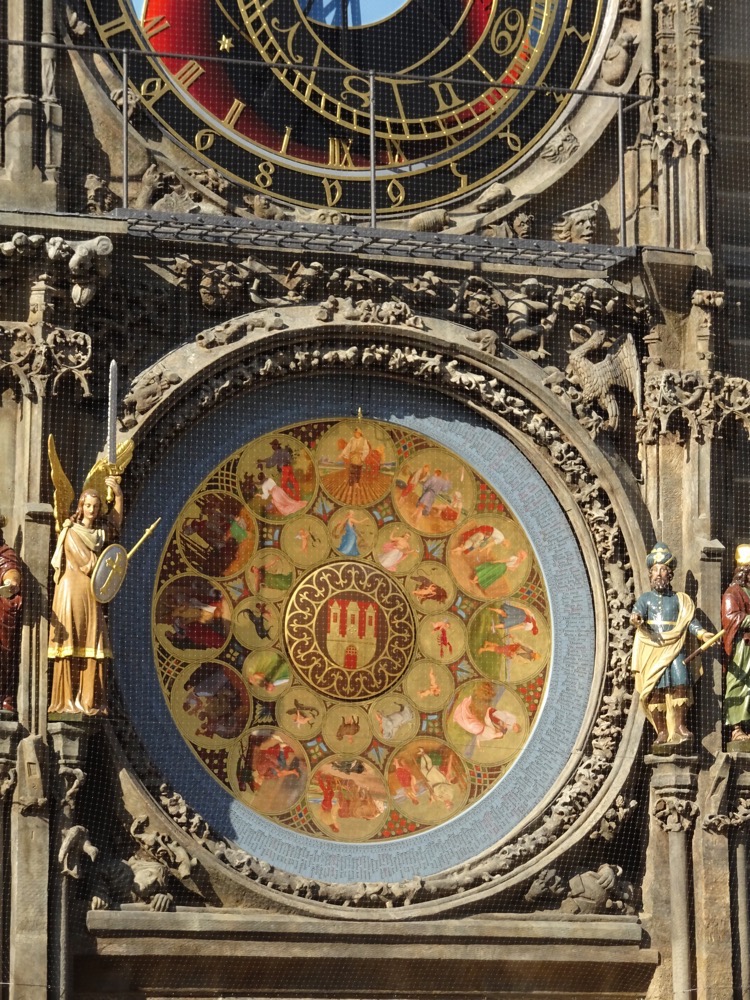 The Orloj was renovated in autumn 2005, when the statues and the lower calendar ring were restored. The wooden statues were covered with a net to keep pigeons away… nowadays I think they need to invest in a net to keep the crazies away. Like a cell phone jammer ought to do it.
The Orloj was renovated in autumn 2005, when the statues and the lower calendar ring were restored. The wooden statues were covered with a net to keep pigeons away… nowadays I think they need to invest in a net to keep the crazies away. Like a cell phone jammer ought to do it.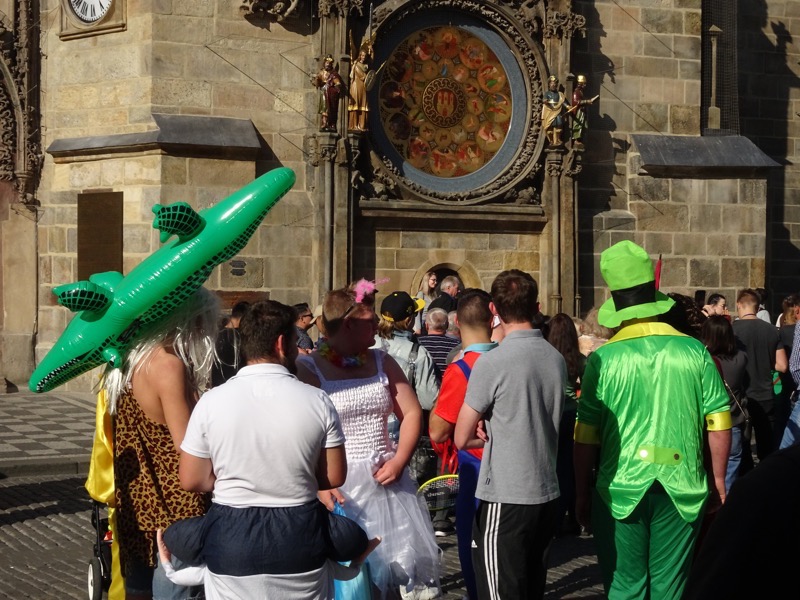
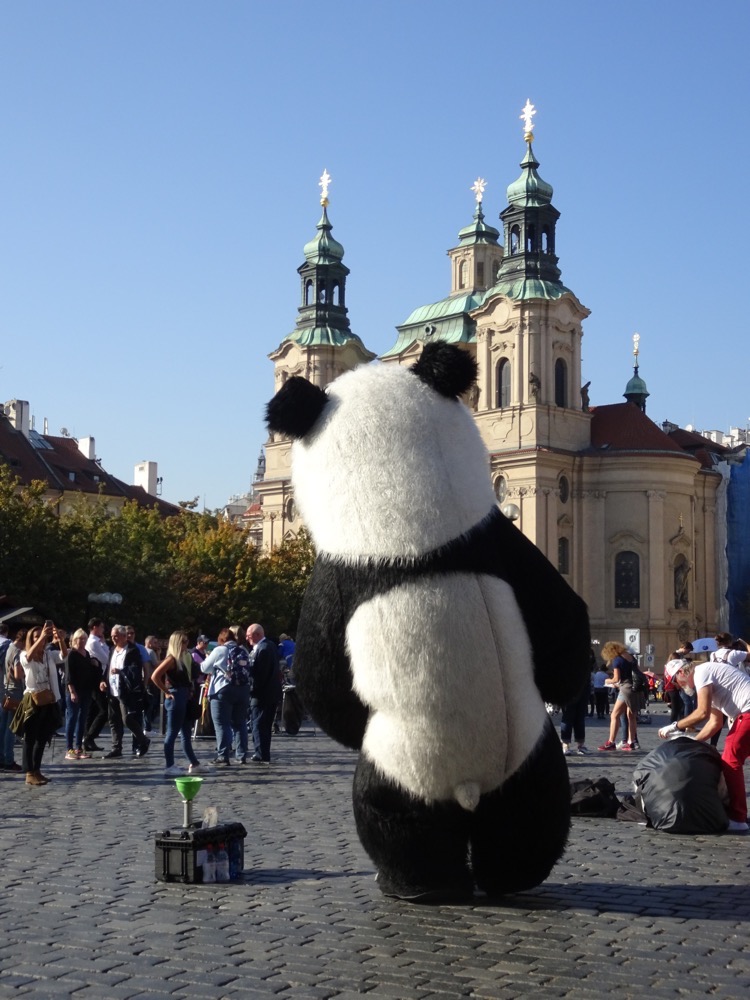 The Old Town Square is a bit of a zoo, to be honest – and it’s not just the tourists contributing to the atmosphere.
The Old Town Square is a bit of a zoo, to be honest – and it’s not just the tourists contributing to the atmosphere.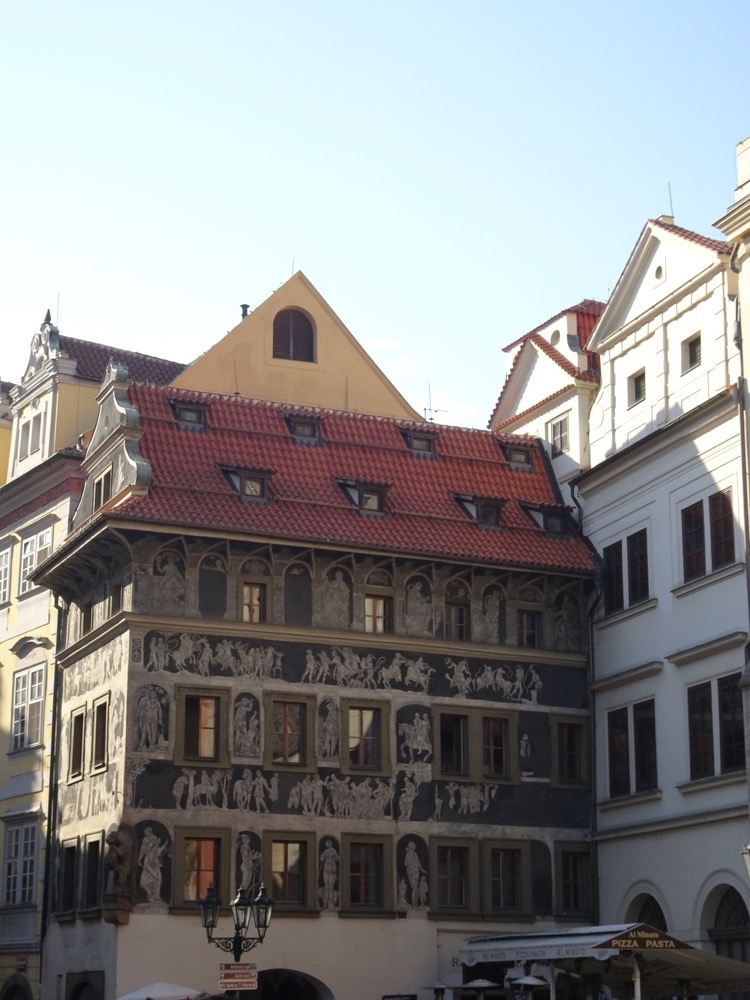 Still… so many gorgeous Renaissance buildings. Love it! <3
Still… so many gorgeous Renaissance buildings. Love it! <3 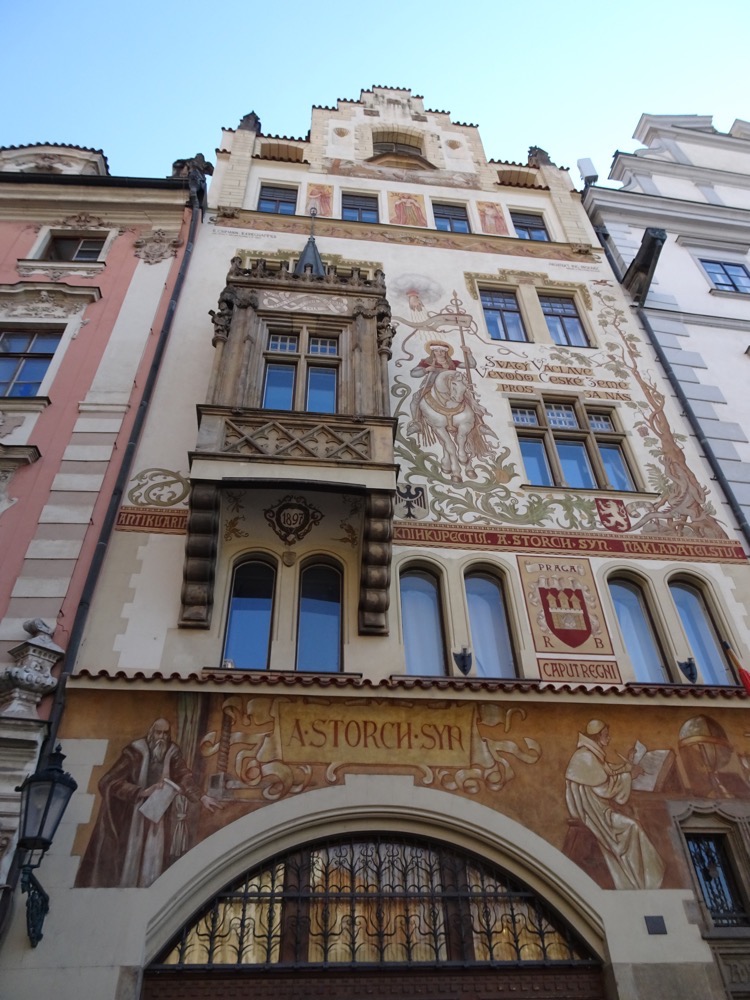
Next, we moved towards the Týn Church aka The Gothic Church of Our Lady which was built in 14th century to replace an earlier 11th century Romanesque church that had been built for the merchant classes living in the area. This is another long-term building project of Prague, as it was not completed until 1511.
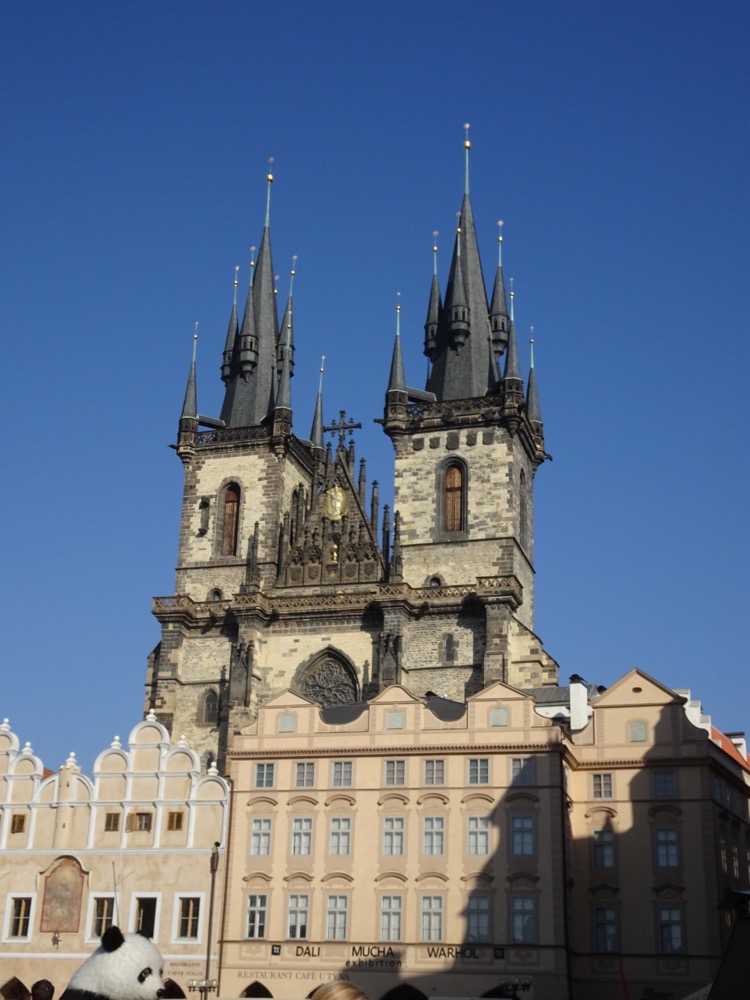 I got a better photograph of it as we were heading towards the Jewish Quarters a bit later…
I got a better photograph of it as we were heading towards the Jewish Quarters a bit later…
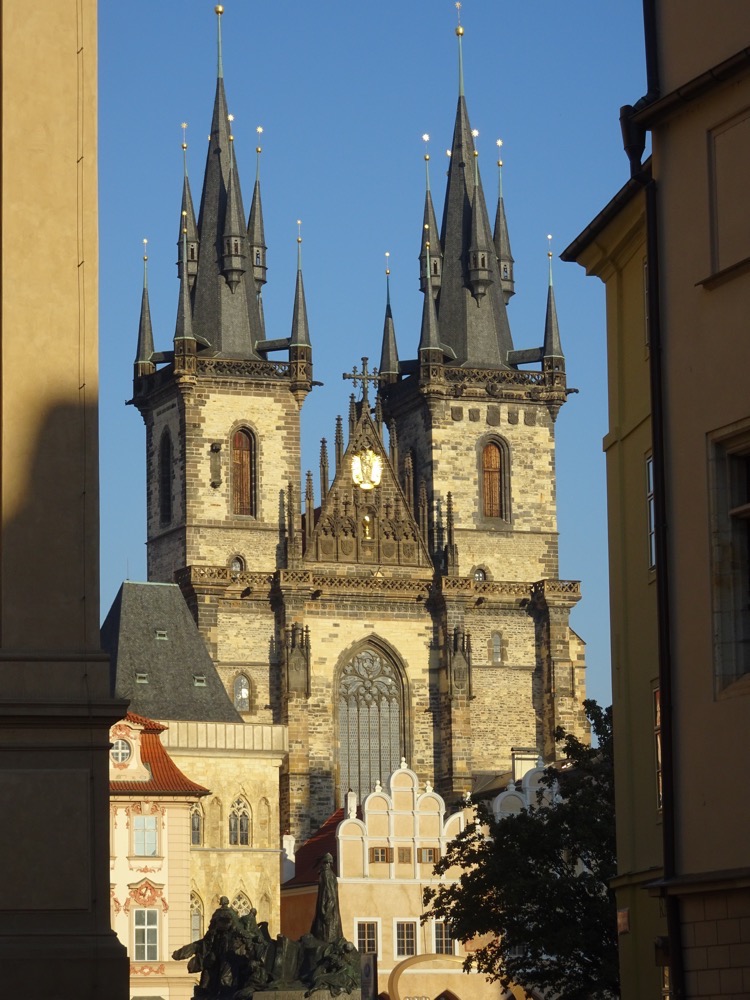
We then stopped for an uneventful lunch in the most touristy of touristy tourist restaurants in Prague. Set in a ‘medieval’ underground tavern, they served up the most typical of Czech fare – goulash, schnitzels and beer. It was okay – but there are far better places in town to eat.
JEWISH QUARTER
After lunch, we headed into the Jewish Quarter which used to house the ghetto and slum areas of the city. Nowadays, however, much of the Jewish Quarter was completely destroyed in the floods of 1890, so was rebuilt in fabulous style, and has become *the* fanciest real estate in town. Walking the shopping streets in the Jewish Quarter feels like wandering down the Champs Elysee – Loius Vuitton, Cartier, Bulgari, Burberry, Rolex, Tiffany & Co. You name the big brand they are here. Ironic seeing as it used to be slums and ghettos. :/
The history of the Jewish pogroms and persecution go back centuries and is as convoluted and extensive as you might expect. Martin kinda overloaded us with the history of treatment of the Jewish community in Prague from the 11th century right up until the 20th century World Wars and it was one helluva a 20-minute lecture that I couldn’t even pretend to adequately summarise here.
We went past the Old New Synagogue or Altneuschul situated in Josefov. It is Europe’s oldest active synagogue. Completed in 1270 in gothic style, it is the oldest surviving medieval synagogue of twin-nave design and was one of Prague’s first gothic buildings.
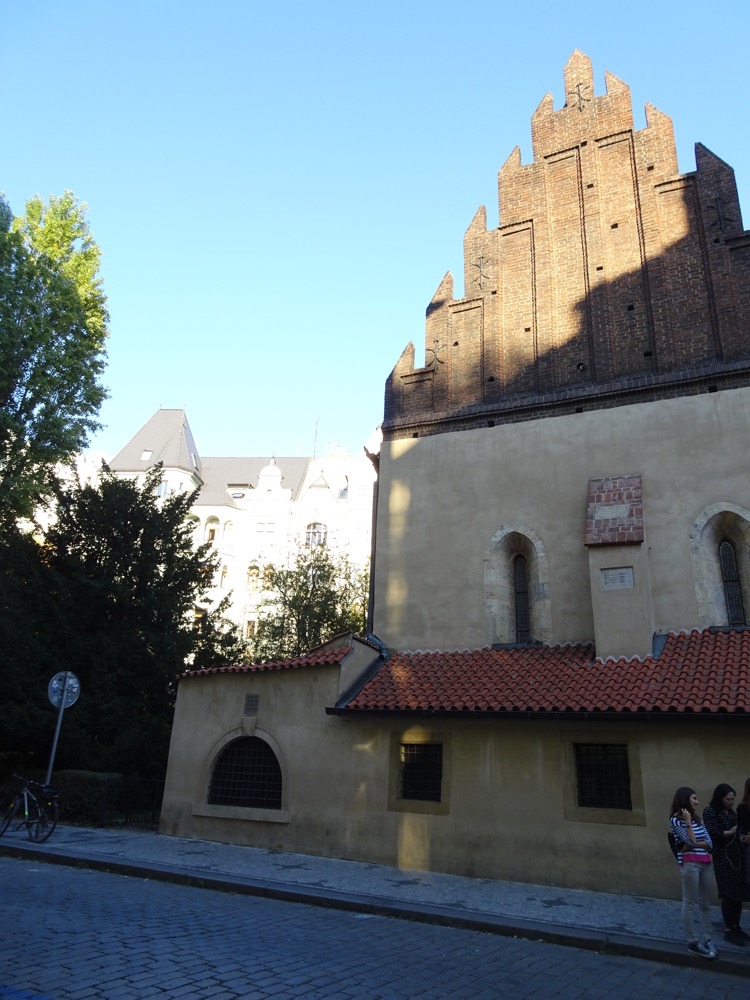 Across the corner from the Old New Synagogue is the Jewish Town Hall or Židovská Radnice which was constructed on the corner of Maiselova and Červená Ulice in 1586 in Renaissance style but in the 18th century, it acquired a Rococo facade.
Across the corner from the Old New Synagogue is the Jewish Town Hall or Židovská Radnice which was constructed on the corner of Maiselova and Červená Ulice in 1586 in Renaissance style but in the 18th century, it acquired a Rococo facade.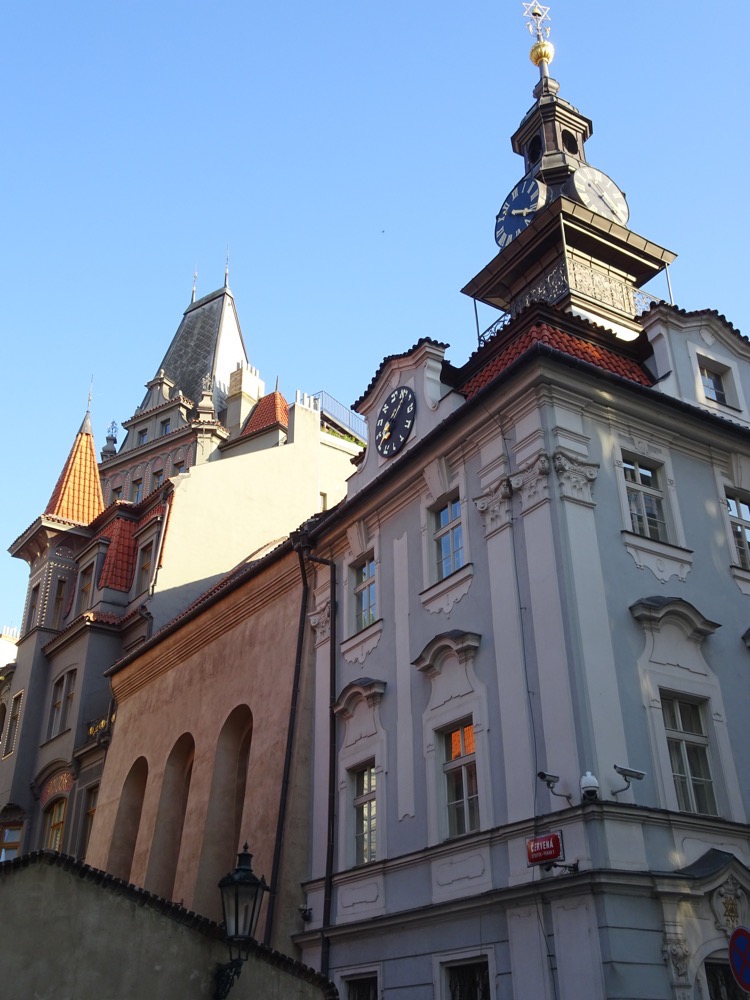 The Jewish Town Hall also contains a most famous Hebrew clock… which has the numbers running anti-clockwise around the clock face and it runs backwards. The concept behind the clock is to encourage the Jewish community to never forget and to think back on their past… apparently – I can’t back that up anywhere. I think it maybe just that all Hebrew is ‘backwards’.
The Jewish Town Hall also contains a most famous Hebrew clock… which has the numbers running anti-clockwise around the clock face and it runs backwards. The concept behind the clock is to encourage the Jewish community to never forget and to think back on their past… apparently – I can’t back that up anywhere. I think it maybe just that all Hebrew is ‘backwards’.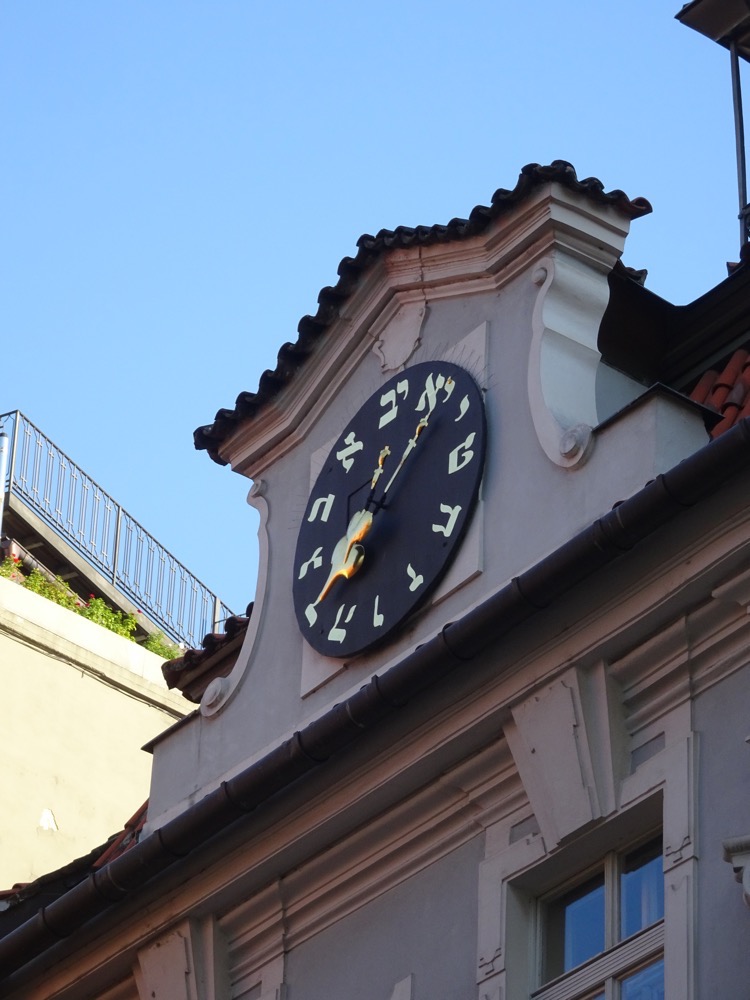 Maisel Synagogue is one of the historical monuments of the former Prague Jewish quarter. It was built at the end of the 16th century which is considered to be the golden age of the ghetto. Since then its appearance has changed several times, its actual style is neo-gothic.
Maisel Synagogue is one of the historical monuments of the former Prague Jewish quarter. It was built at the end of the 16th century which is considered to be the golden age of the ghetto. Since then its appearance has changed several times, its actual style is neo-gothic.
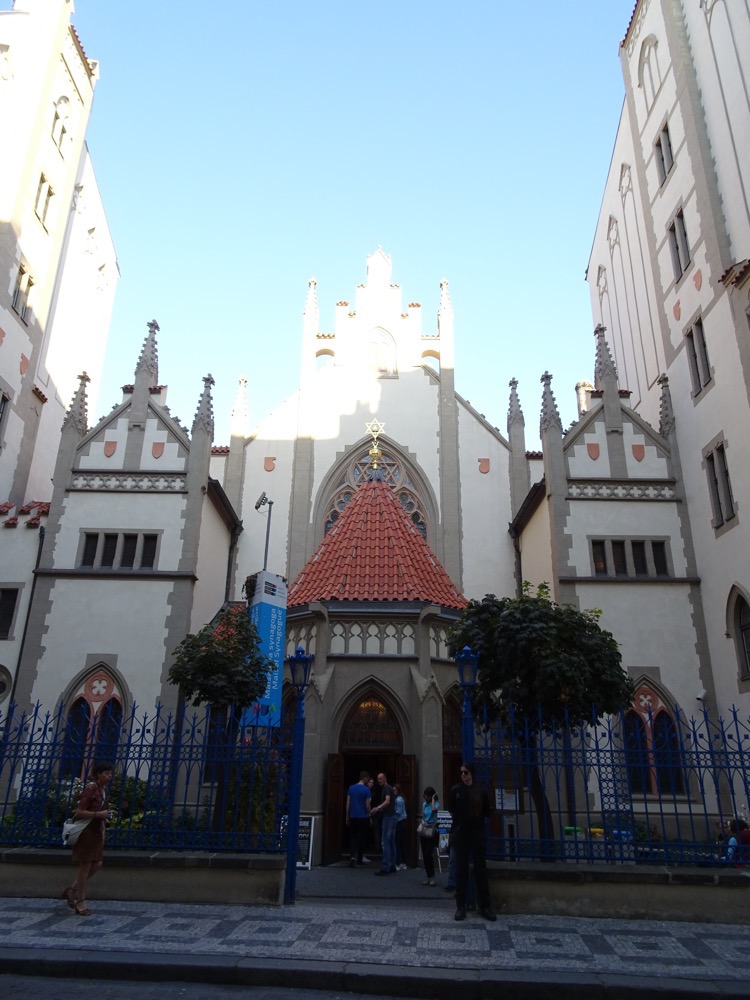 And our last stop – the Franz Kafka Museum, where we had a five minute Jeopardy style, ‘Who is Franz Kafka?’ speech for the Americans on our small tour. 😀
And our last stop – the Franz Kafka Museum, where we had a five minute Jeopardy style, ‘Who is Franz Kafka?’ speech for the Americans on our small tour. 😀
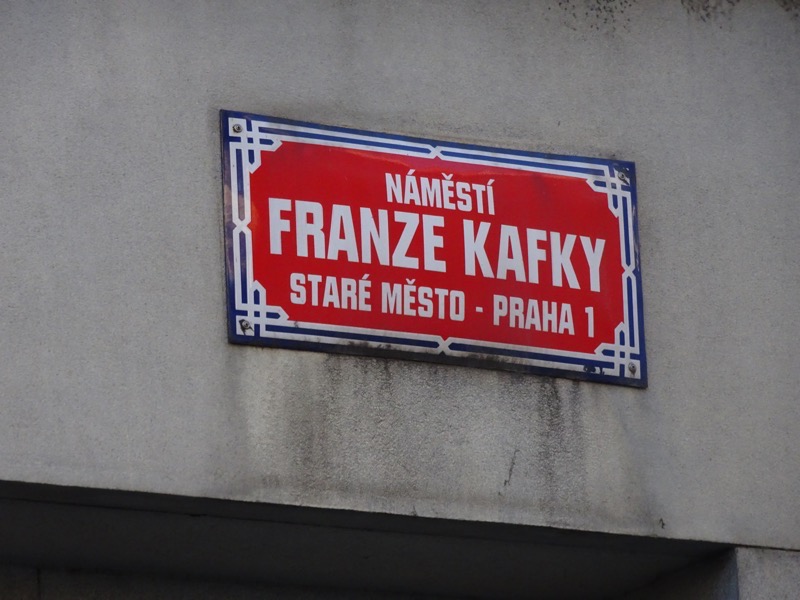
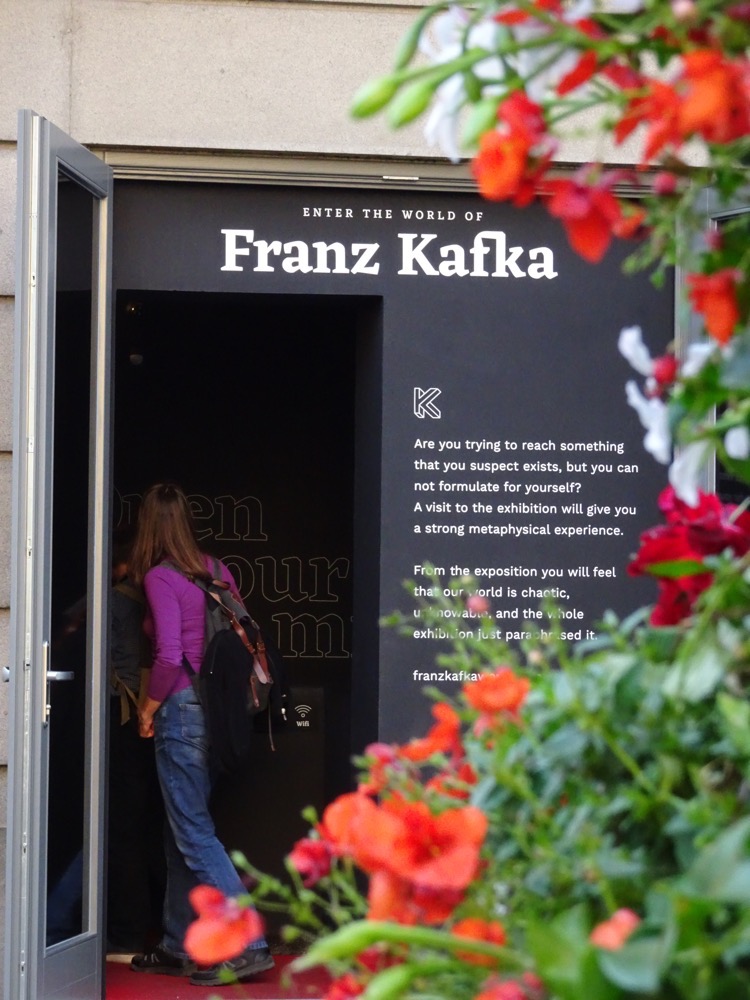 Woo! What a huge day. And it was not yet 5pm. So yale and I went a wandering back over some of the winding little streets we had passed hoping to get a better look at a few places in the Old Town.
Woo! What a huge day. And it was not yet 5pm. So yale and I went a wandering back over some of the winding little streets we had passed hoping to get a better look at a few places in the Old Town.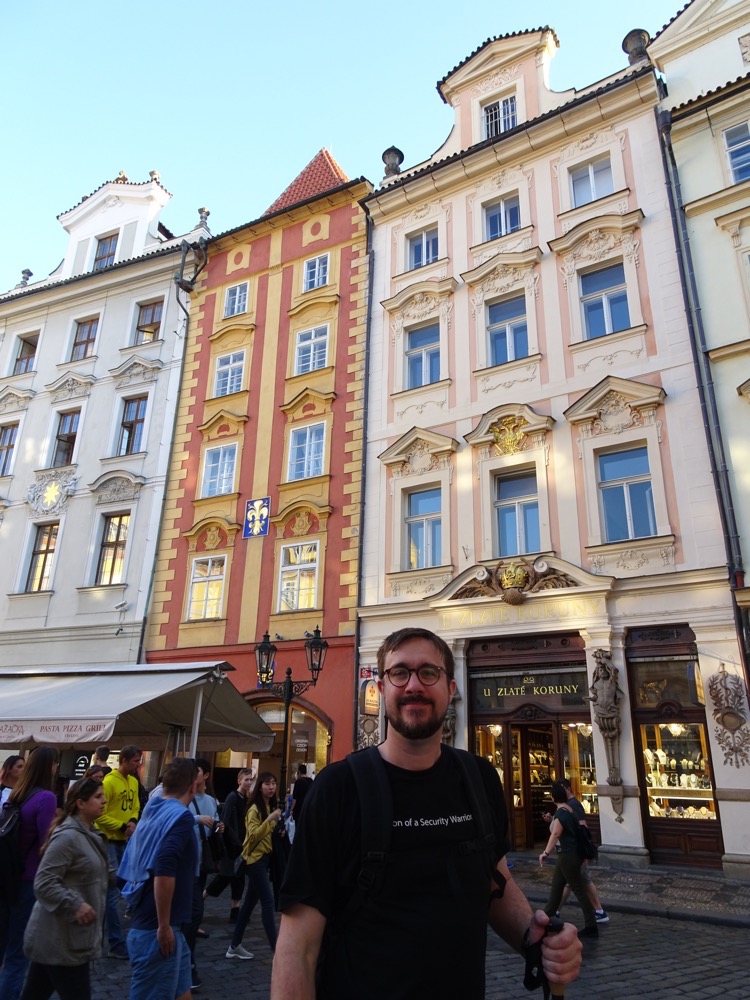
First things first – we had seen the Trdelník (or Chimney Cake) everywhere. It is a kind of spit cake made from rolled dough that is wrapped around a stick, then grilled and topped with sugar and walnuts and whatever you might want. yale said ‘he had to buy one’.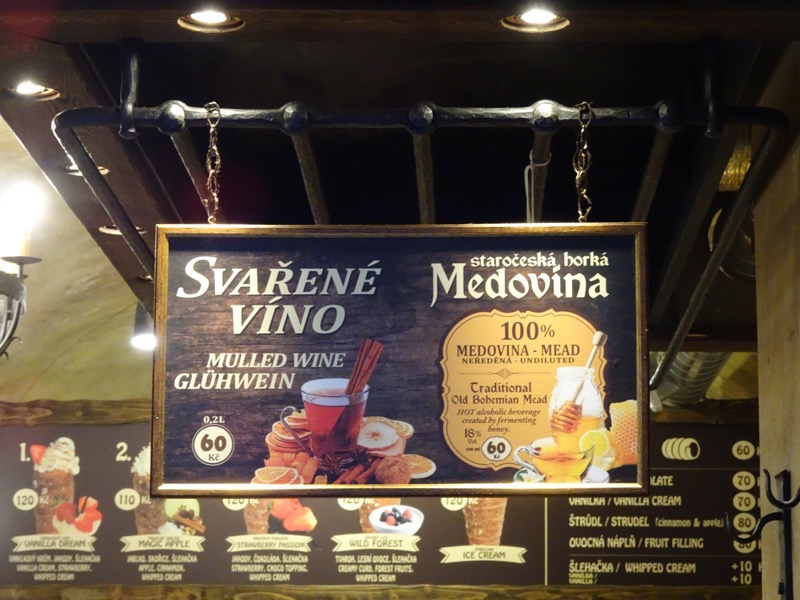
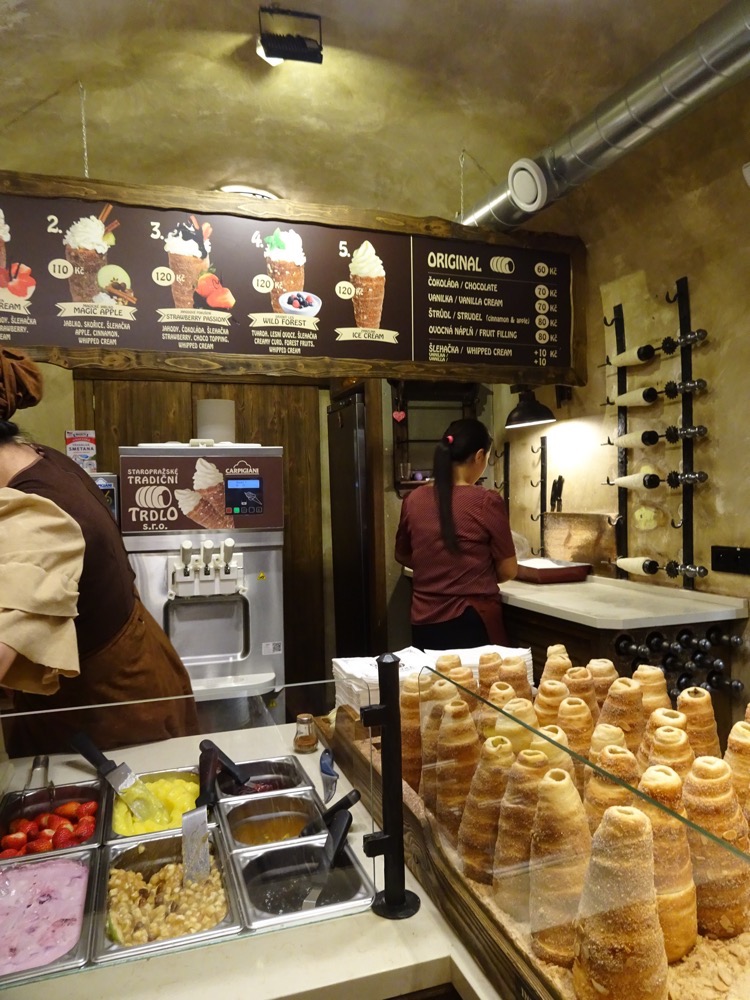
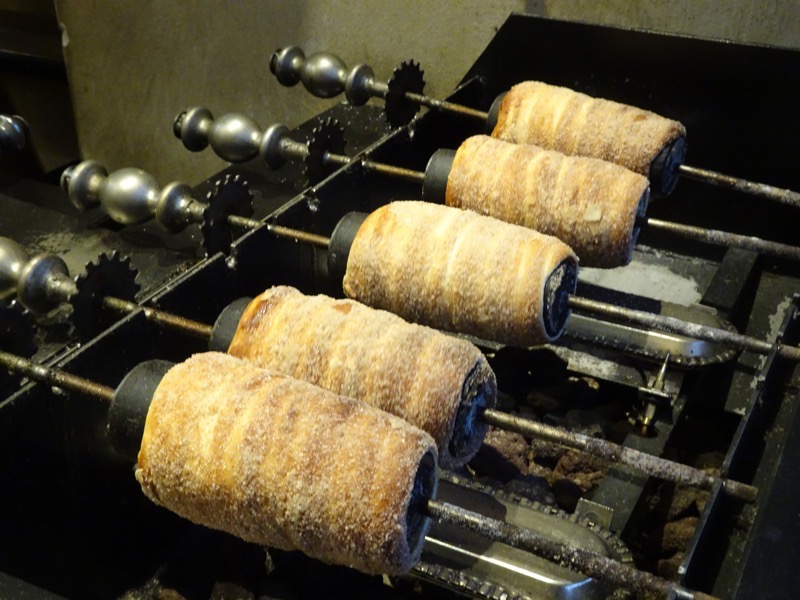
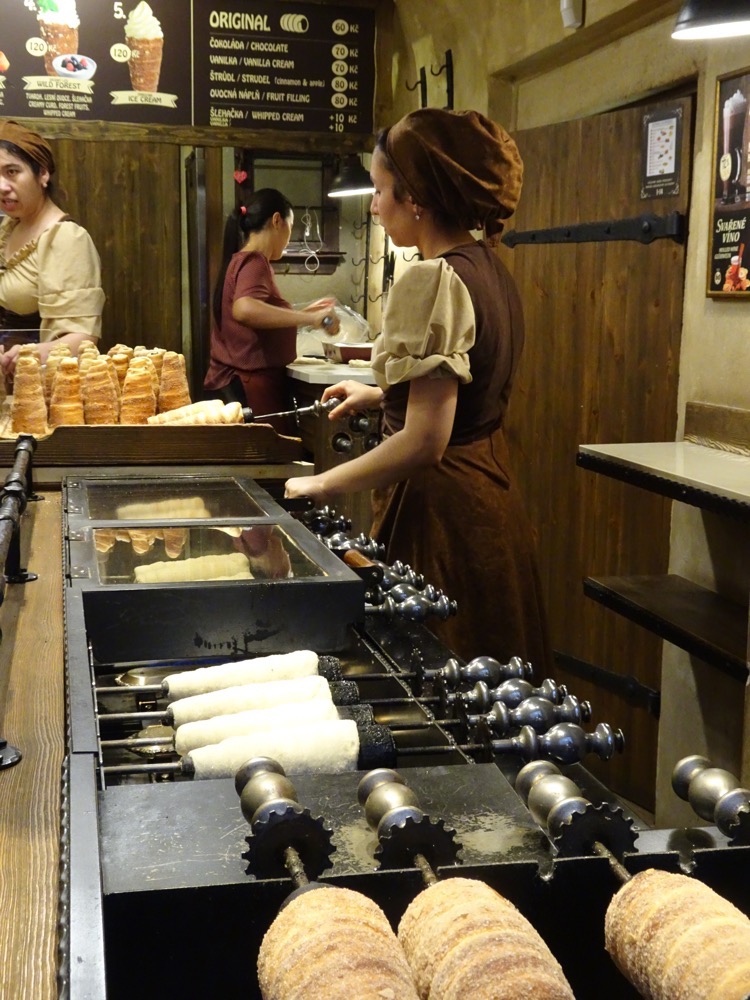
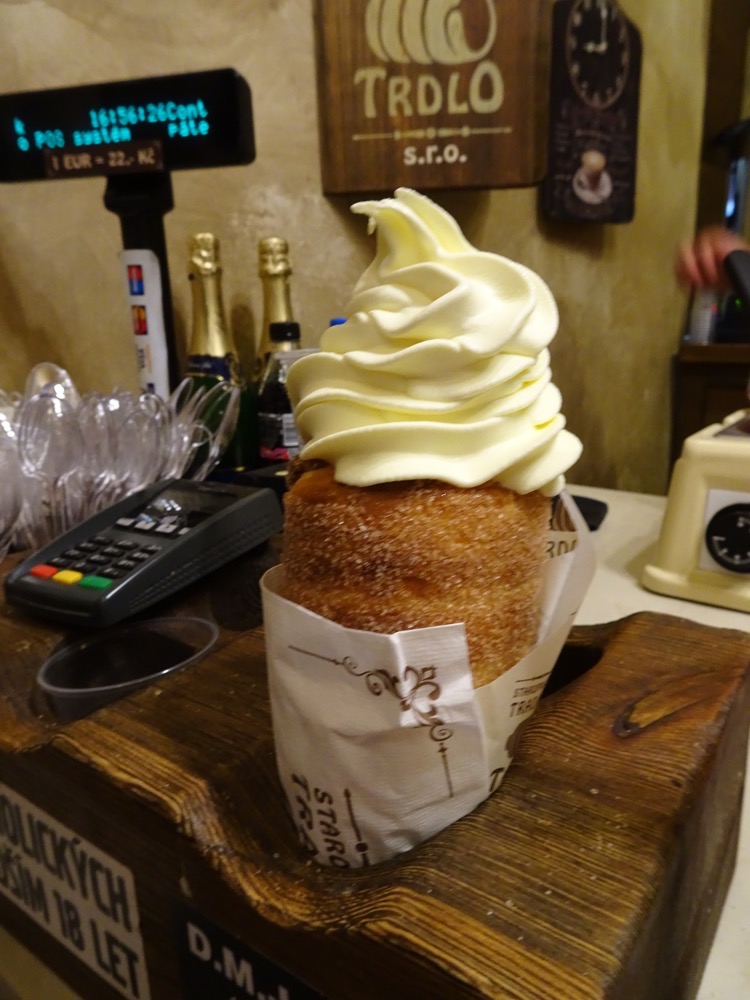 After watching yale not quite making it through an entire Trdelník, I did a bit of shopping before going back to the hotel for a well-earned soak in the tub. My poor little feets! I have totally forgotten how hard it is walking all day on the cobblestones is – 10.38kms of it.
After watching yale not quite making it through an entire Trdelník, I did a bit of shopping before going back to the hotel for a well-earned soak in the tub. My poor little feets! I have totally forgotten how hard it is walking all day on the cobblestones is – 10.38kms of it.
View from our windows as we were heading out to dinner!
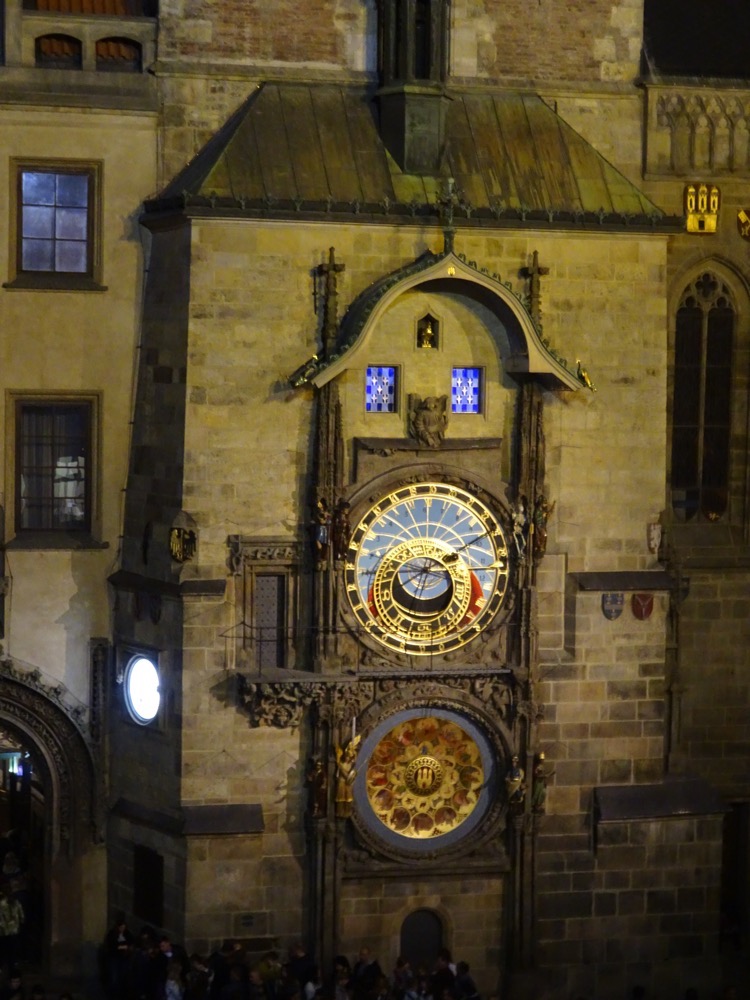 As we were wandering around looking for somewhere to have dinner – we spied a ‘Captain Candy’, I had to go in and photograph all the pretty coloured sugar.
As we were wandering around looking for somewhere to have dinner – we spied a ‘Captain Candy’, I had to go in and photograph all the pretty coloured sugar.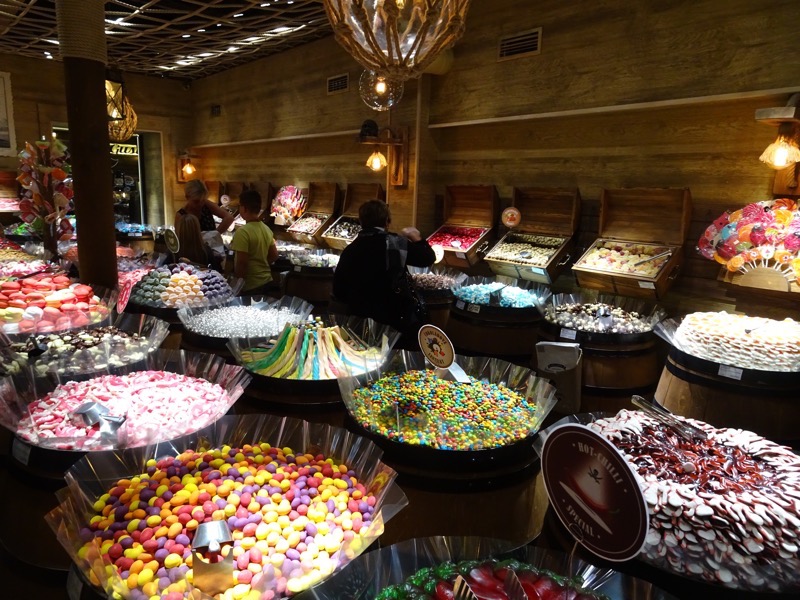
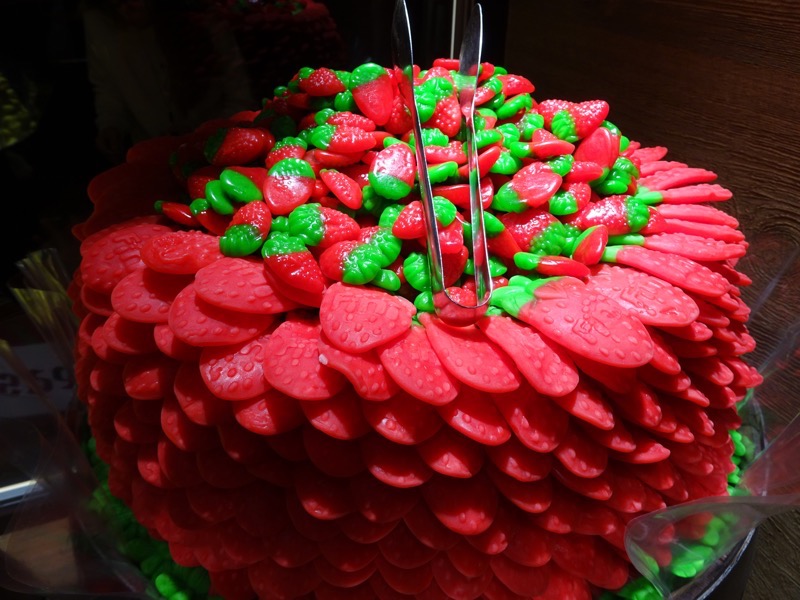
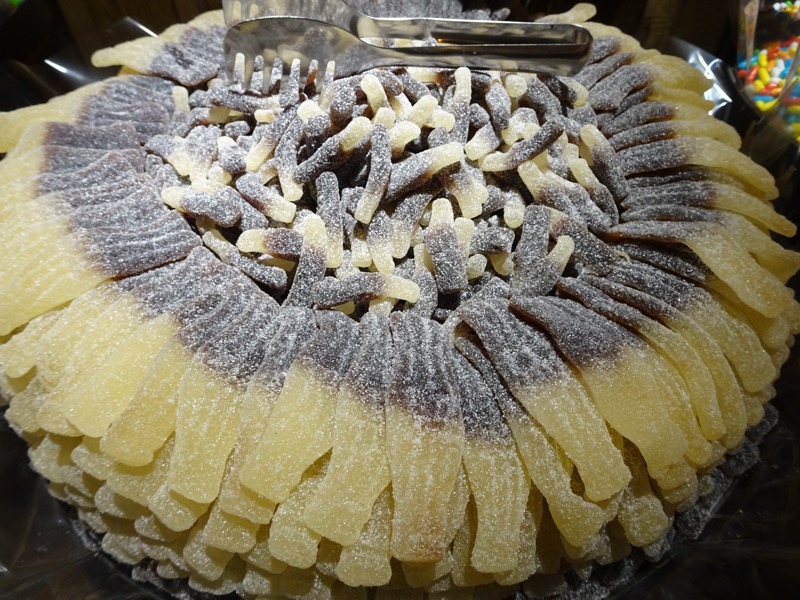 Dinner was a U Dvov Sester – a lovely little local Czech restauarnt with live music and a really nice atmosphere.
Dinner was a U Dvov Sester – a lovely little local Czech restauarnt with live music and a really nice atmosphere.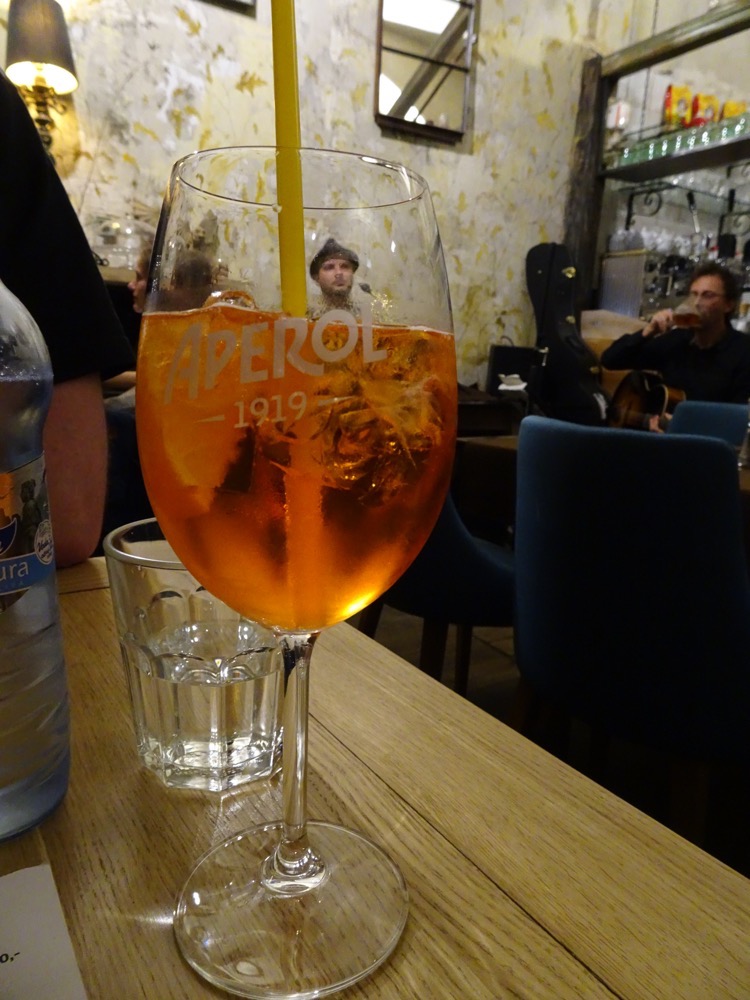 Marinated bried with onions and spices.
Marinated bried with onions and spices.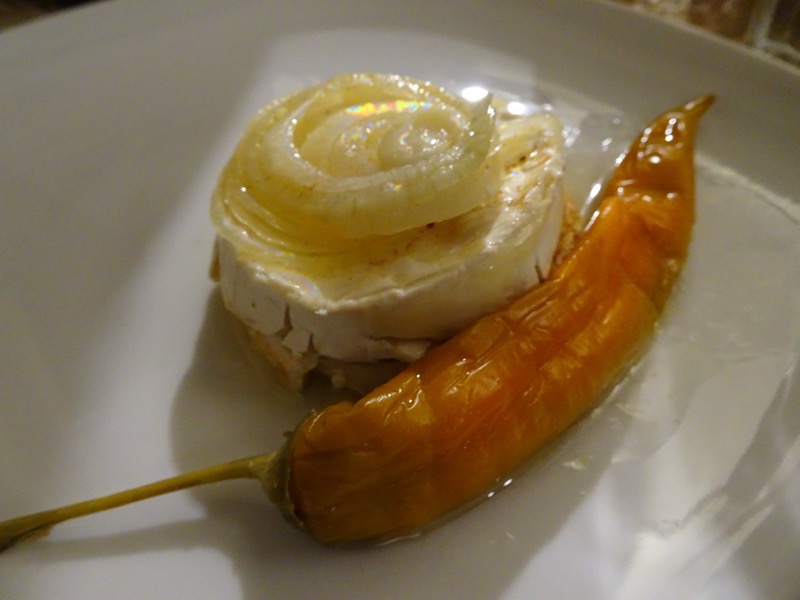 Roasted homemade sausage with moutarde and horseradish.
Roasted homemade sausage with moutarde and horseradish.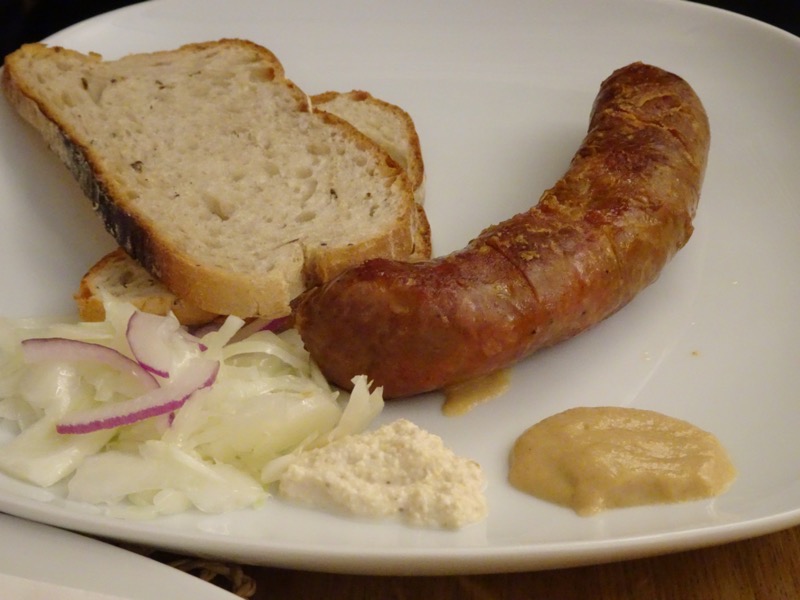 Pork knuckle of enormousness (650gms!)
Pork knuckle of enormousness (650gms!)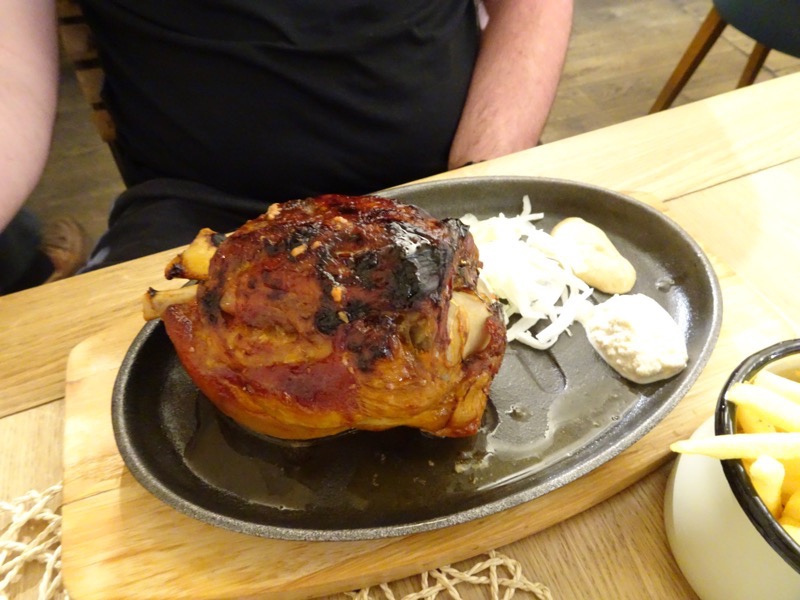 And goulash with doughboy dumplings, just like Mum used to make.
And goulash with doughboy dumplings, just like Mum used to make.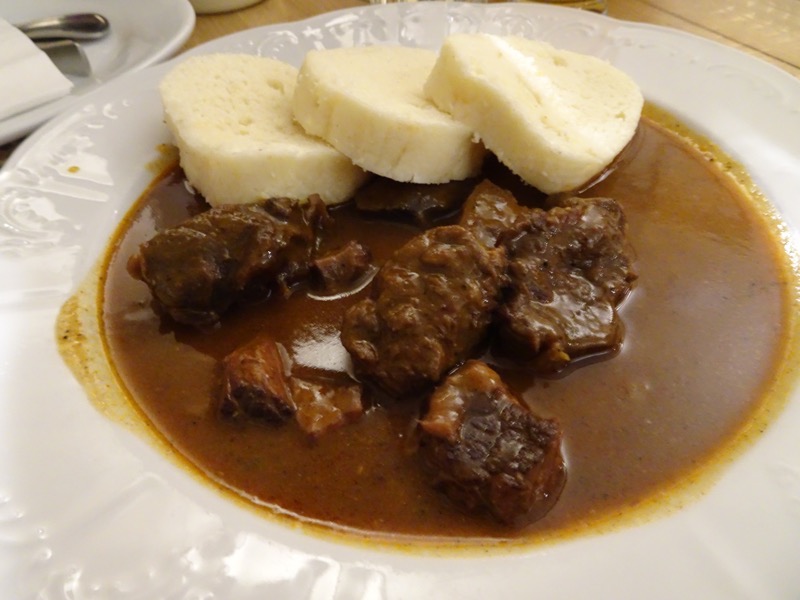
We had a huge day and I’d like to say I went to bed early – but that just wasn’t to be when I had all this to write down before I forgot it all. Didn’t get to sleep until nearly midnight at which point, I had to pull the pin and hope for wifi on the train tomorrow (today).
Places we didn’t go to at all! So they are still on my list. 🙂
St. George Basilica
Powder Gate
Old Jewish Cemetery
Carolinum
Pinkas Synagogue
Spanish Synagogue
Jewish Ceremonial Hall

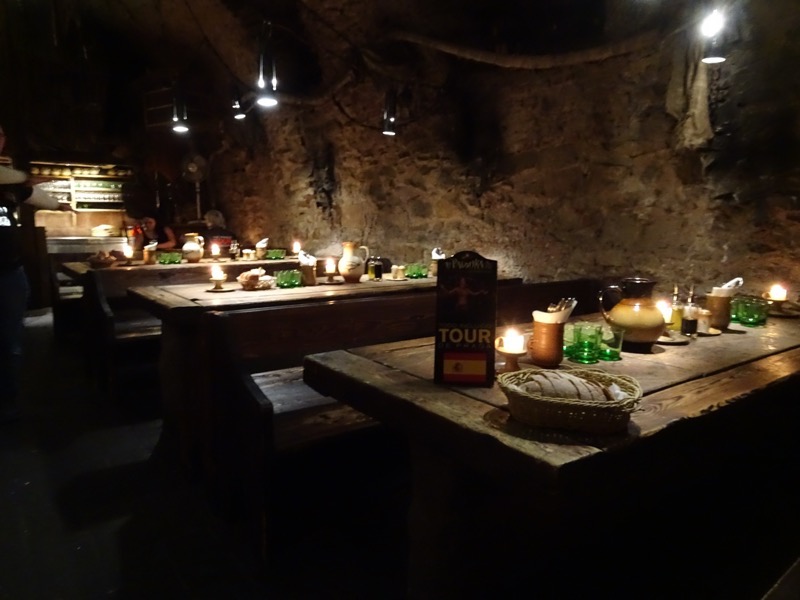
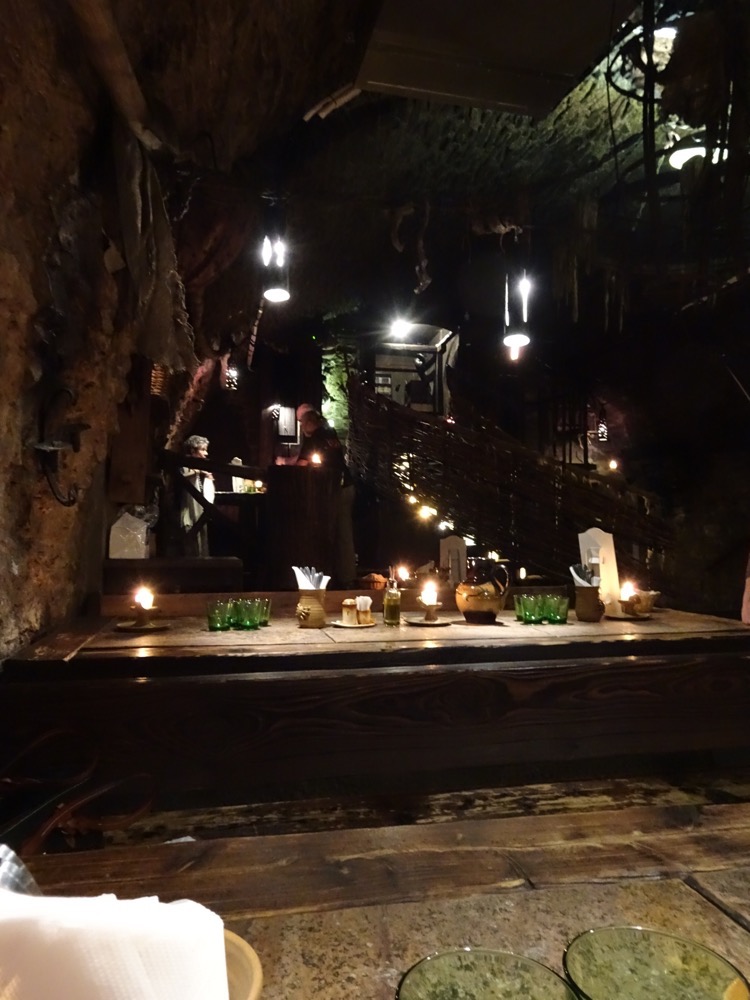
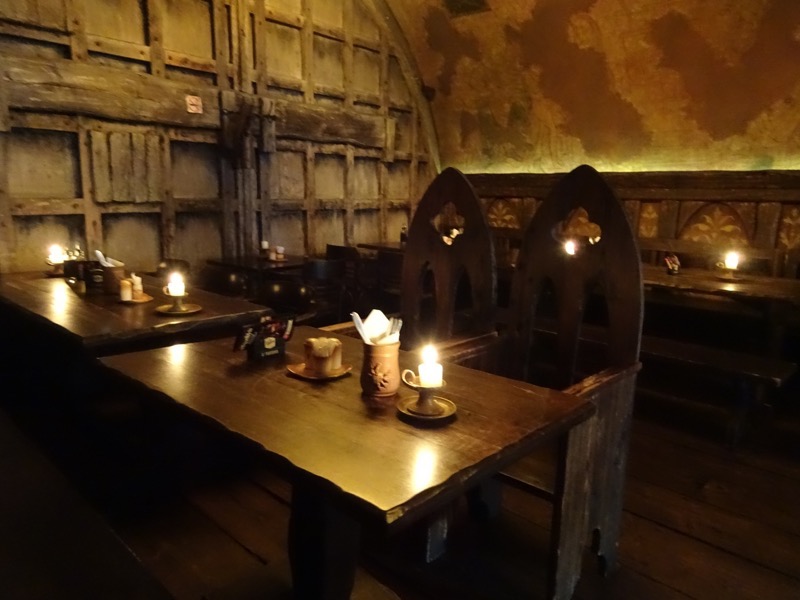
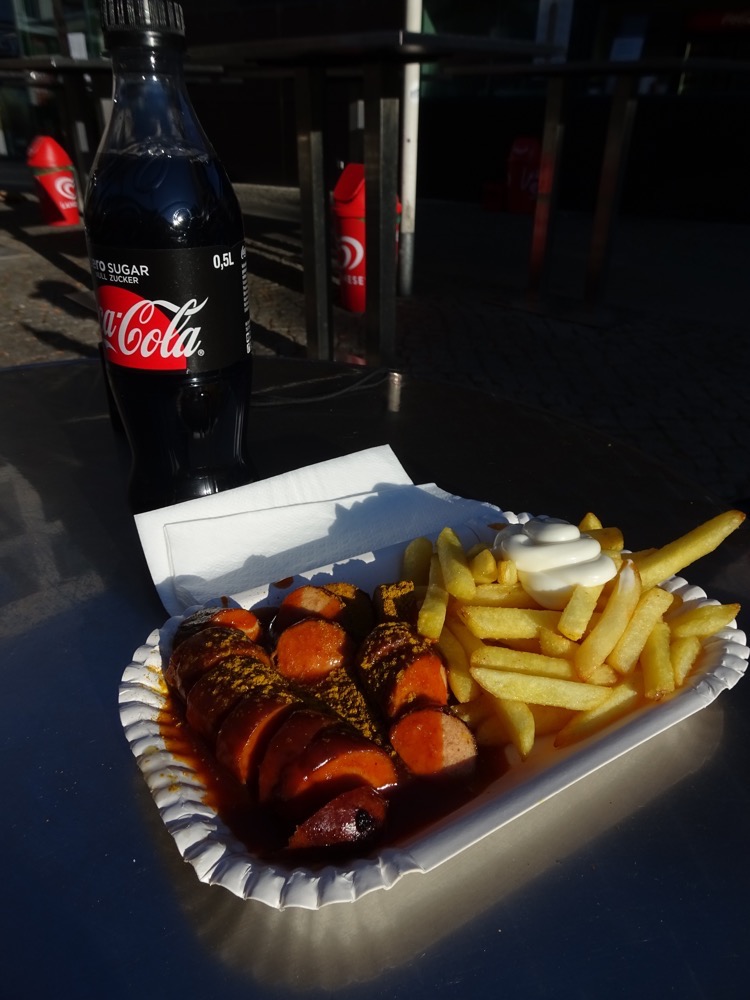 A little further down the street, I found a famous bakery called Bäckerei Möbius that has been here since 1908, so we stopped for aSchwarzer Tee and some schnecken before doing another quick turn around the city.
A little further down the street, I found a famous bakery called Bäckerei Möbius that has been here since 1908, so we stopped for aSchwarzer Tee and some schnecken before doing another quick turn around the city.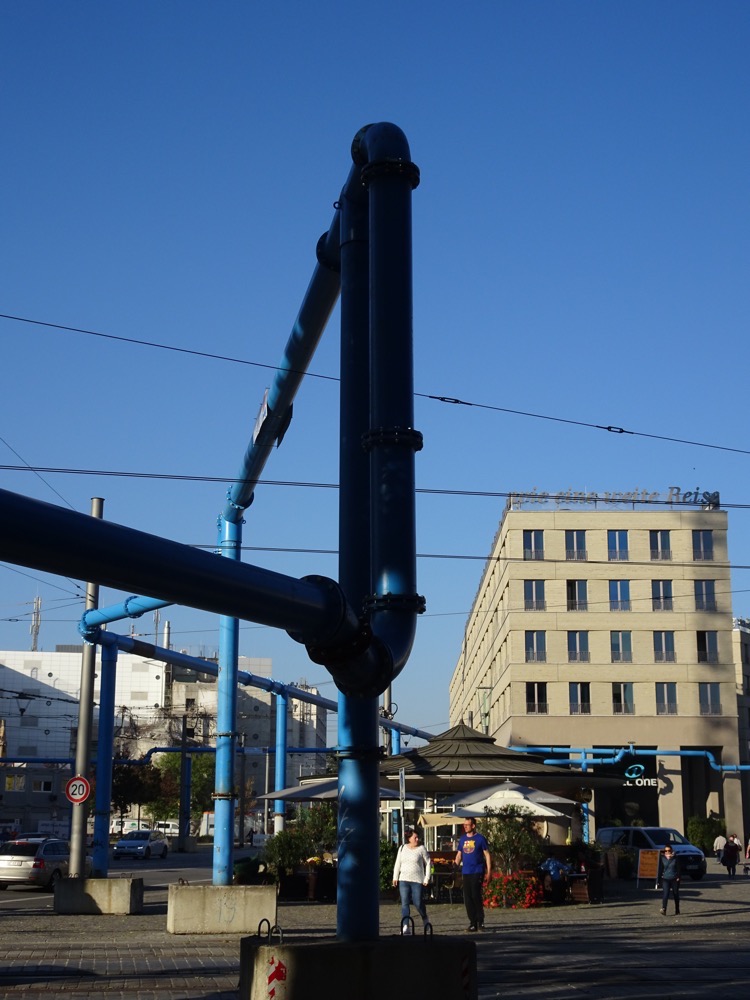 Memorial marker for a place where a medieval church had been but had been destroyed by bombing in WWII.
Memorial marker for a place where a medieval church had been but had been destroyed by bombing in WWII.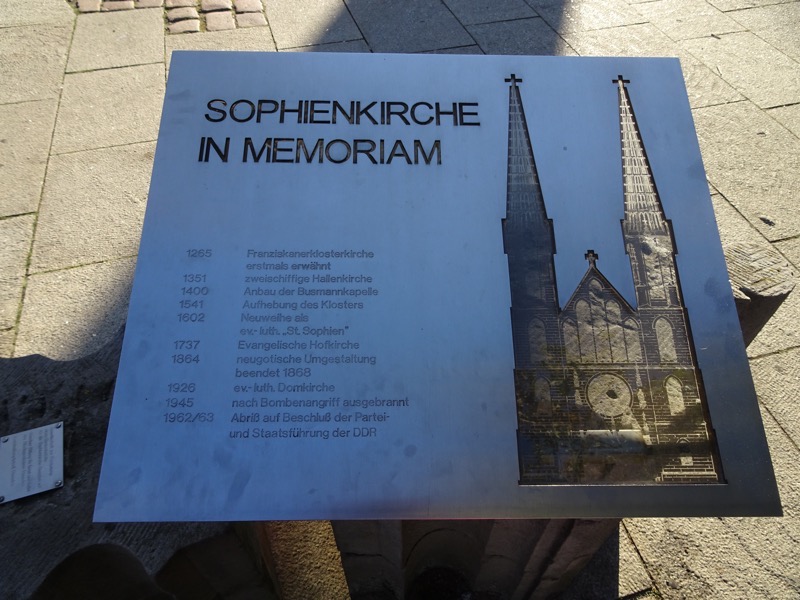 Der Cholerabrunnen – the Dresden Cholera Fountain – was constructed in the mid-1840s for Baron Eugen von Gutschmid as a celebration of the sparing of the city from a Cholera epidemic that ravaged the region in 1841/2.
Der Cholerabrunnen – the Dresden Cholera Fountain – was constructed in the mid-1840s for Baron Eugen von Gutschmid as a celebration of the sparing of the city from a Cholera epidemic that ravaged the region in 1841/2.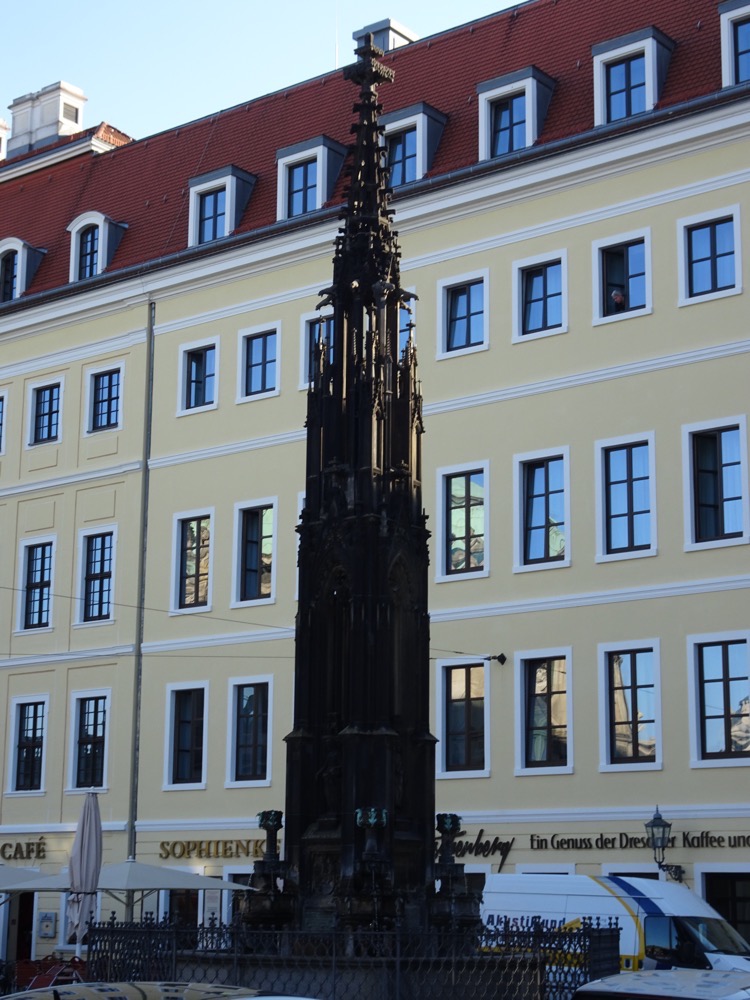 No idea why, but it is covered in lizards…
No idea why, but it is covered in lizards…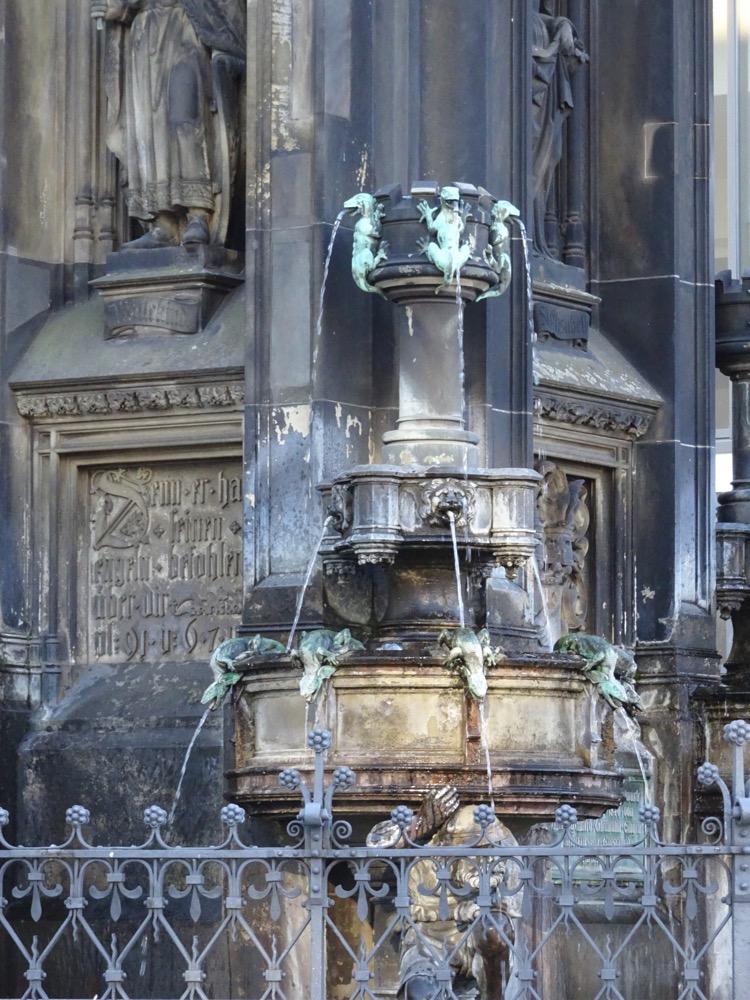 A nearby restaurant shows its ingenuity in getting around language barriers on menus.
A nearby restaurant shows its ingenuity in getting around language barriers on menus.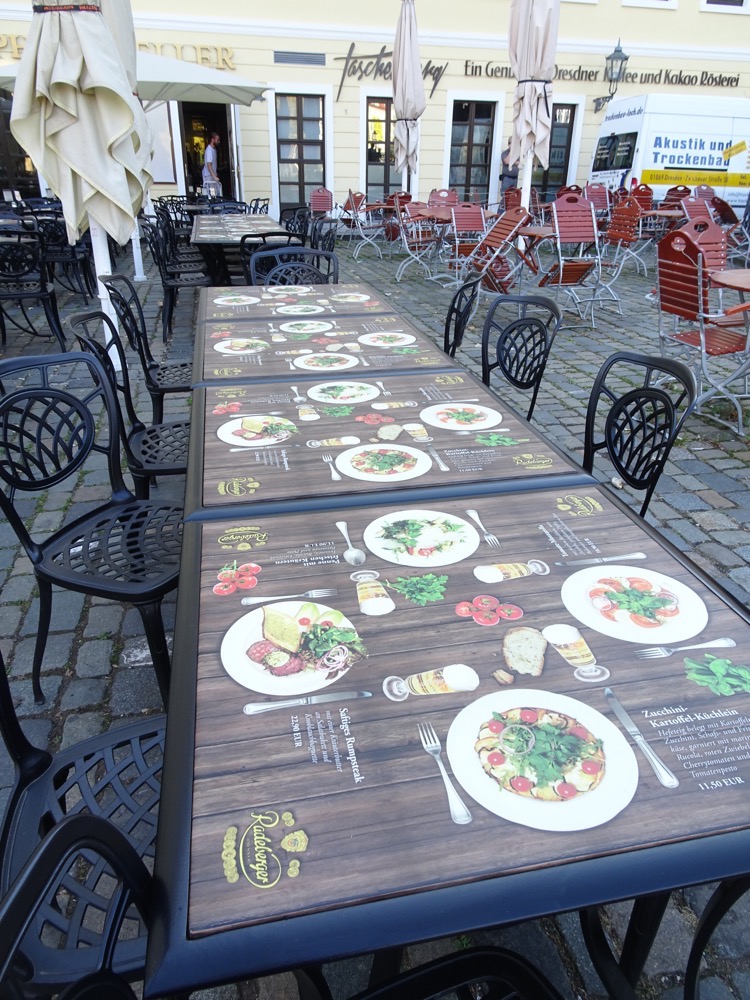 Advertising for a high-end jeweller – let’s not muck around, let’s show them we can make elaborate Rennaisance/Baroque masterpieces! Bit much for everyday wear, I think.
Advertising for a high-end jeweller – let’s not muck around, let’s show them we can make elaborate Rennaisance/Baroque masterpieces! Bit much for everyday wear, I think.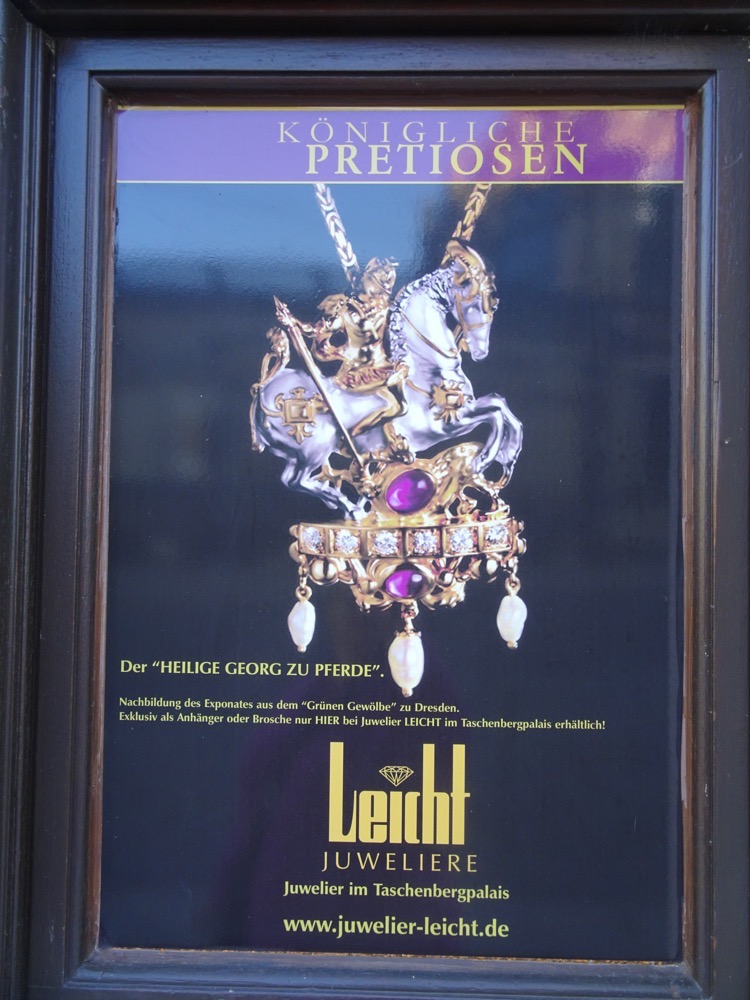
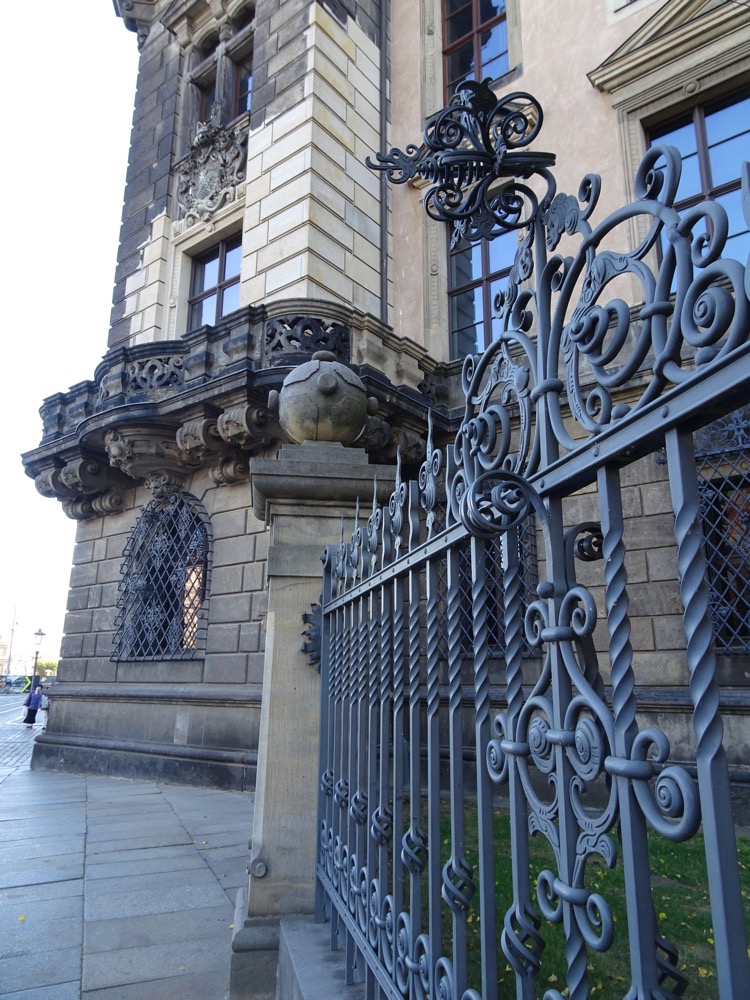
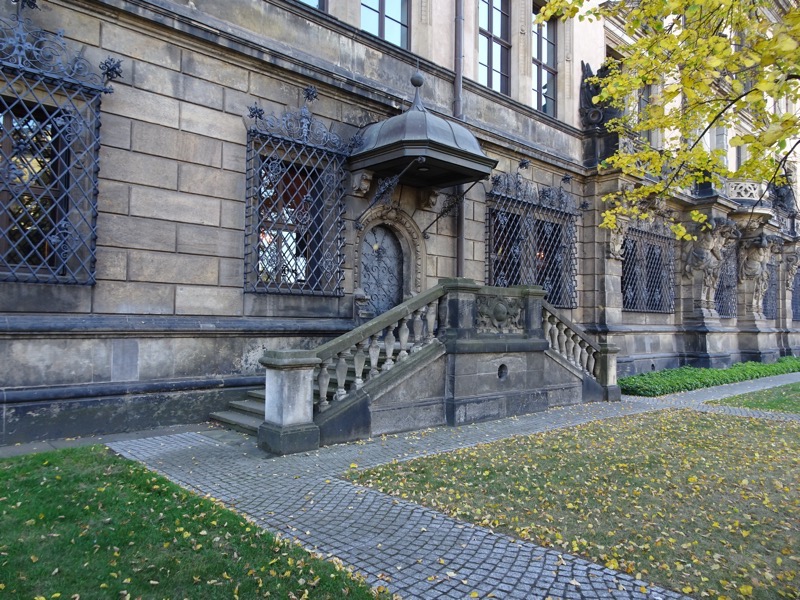 The Semperoper Dresden looking much more impressive in the morning light.
The Semperoper Dresden looking much more impressive in the morning light.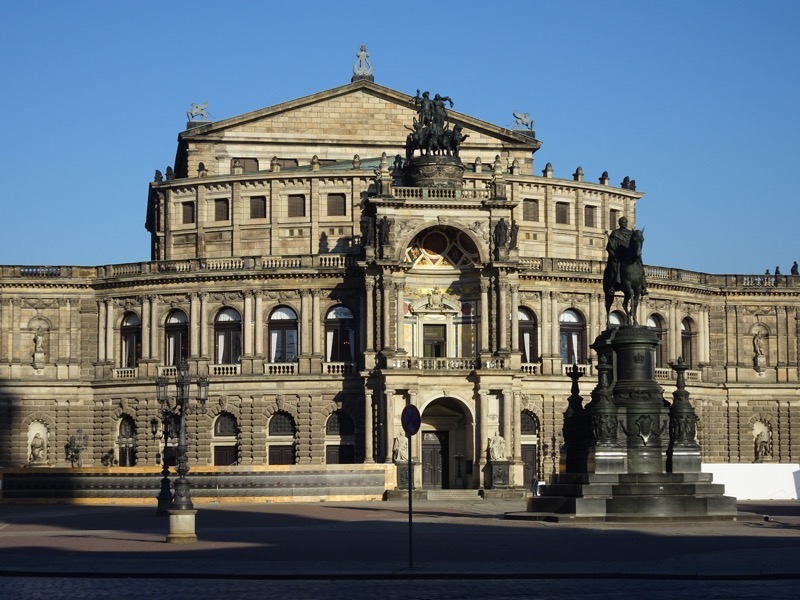
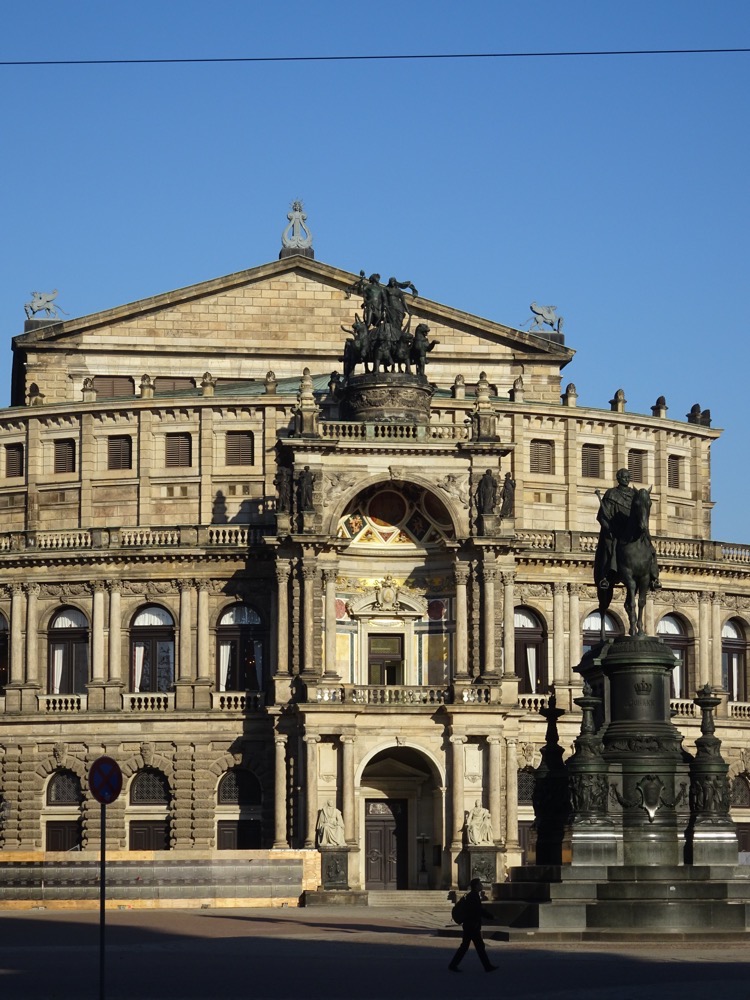 The back of the Katholische Hofkirche… needs some serious restoration work done. I think many of Dresden’s buildings could do with a bit of time under scaffold being cleaned – they appear to be wearing most of the 19th/20thC grime that most other European countries have long since cleaned up.
The back of the Katholische Hofkirche… needs some serious restoration work done. I think many of Dresden’s buildings could do with a bit of time under scaffold being cleaned – they appear to be wearing most of the 19th/20thC grime that most other European countries have long since cleaned up.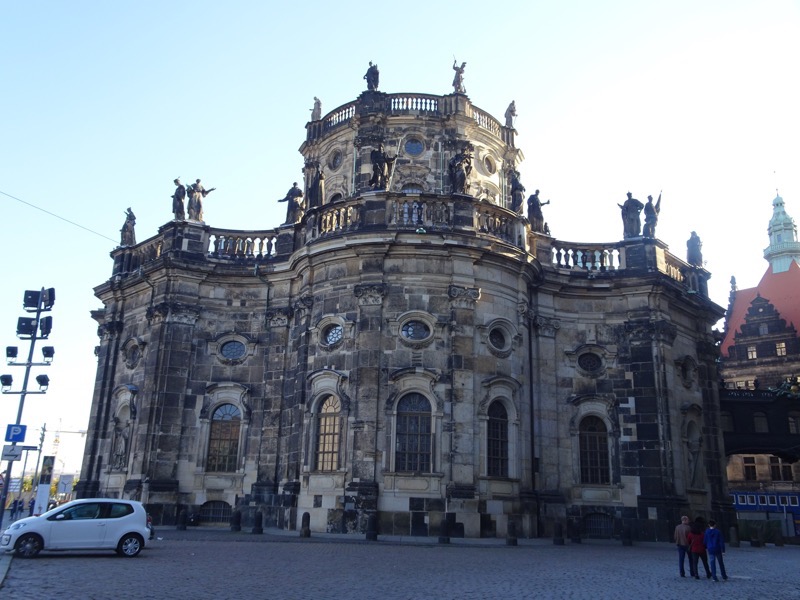
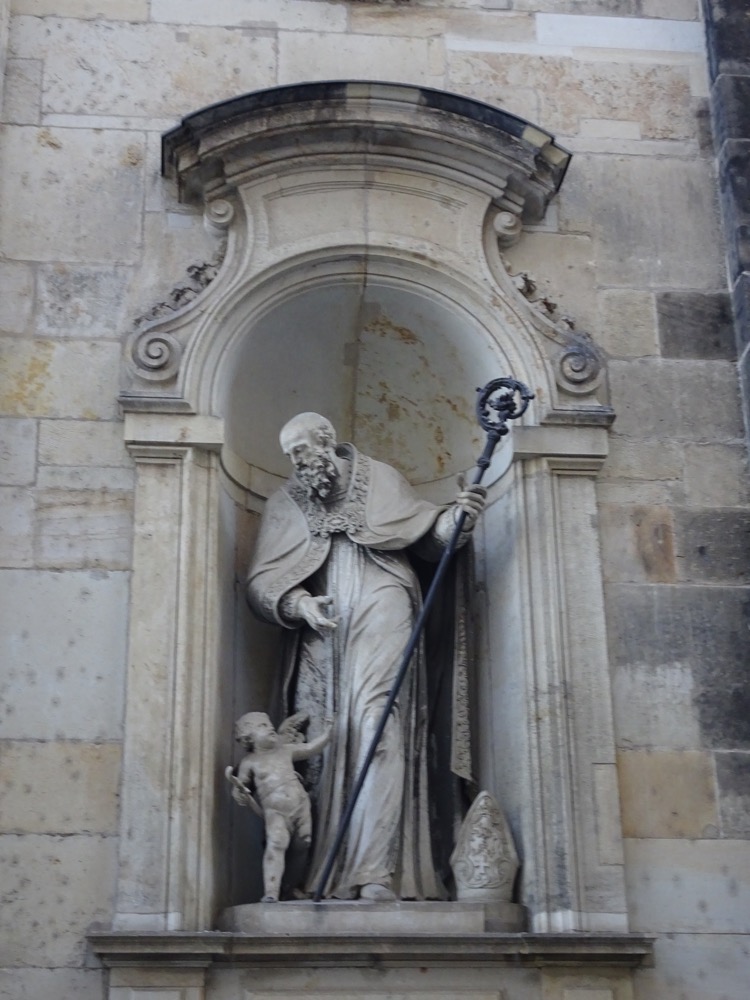
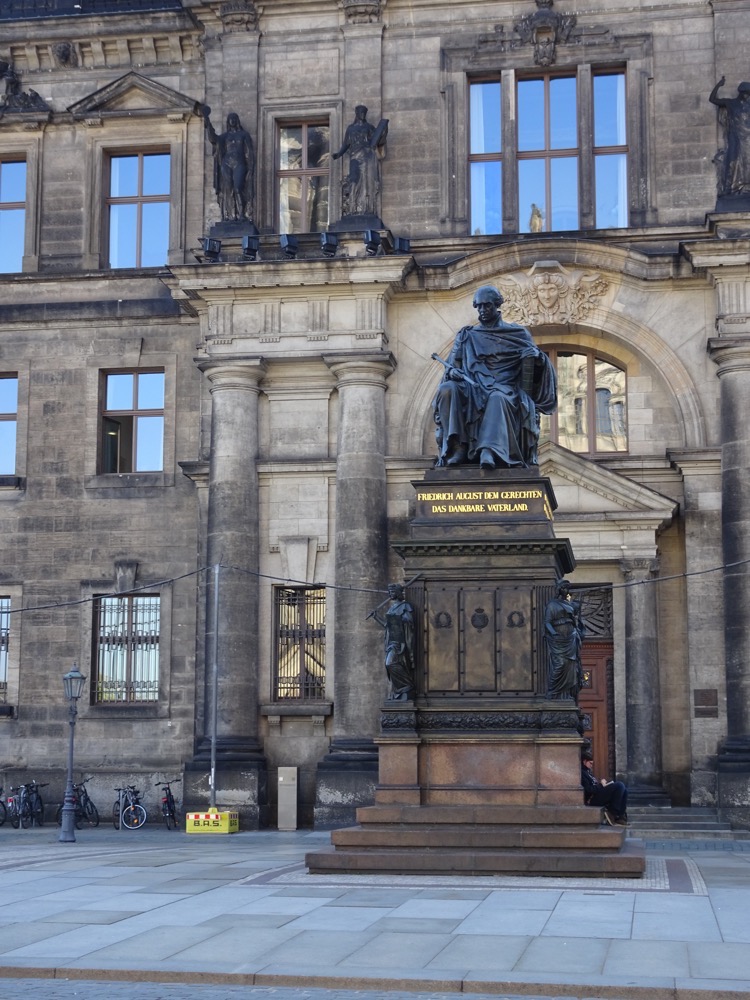
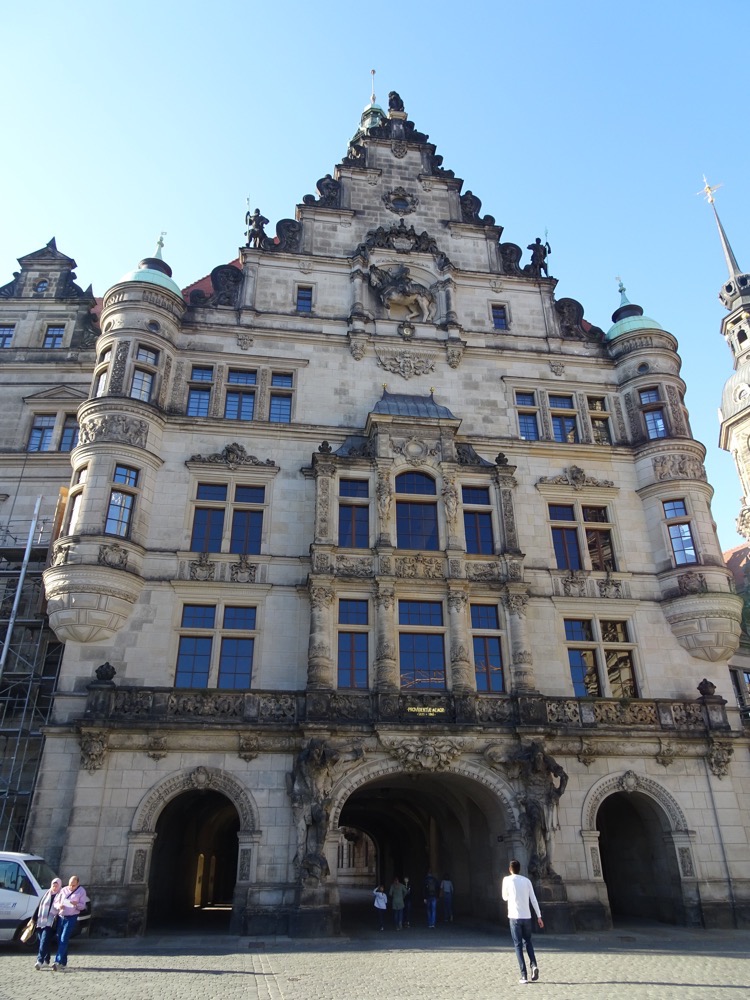
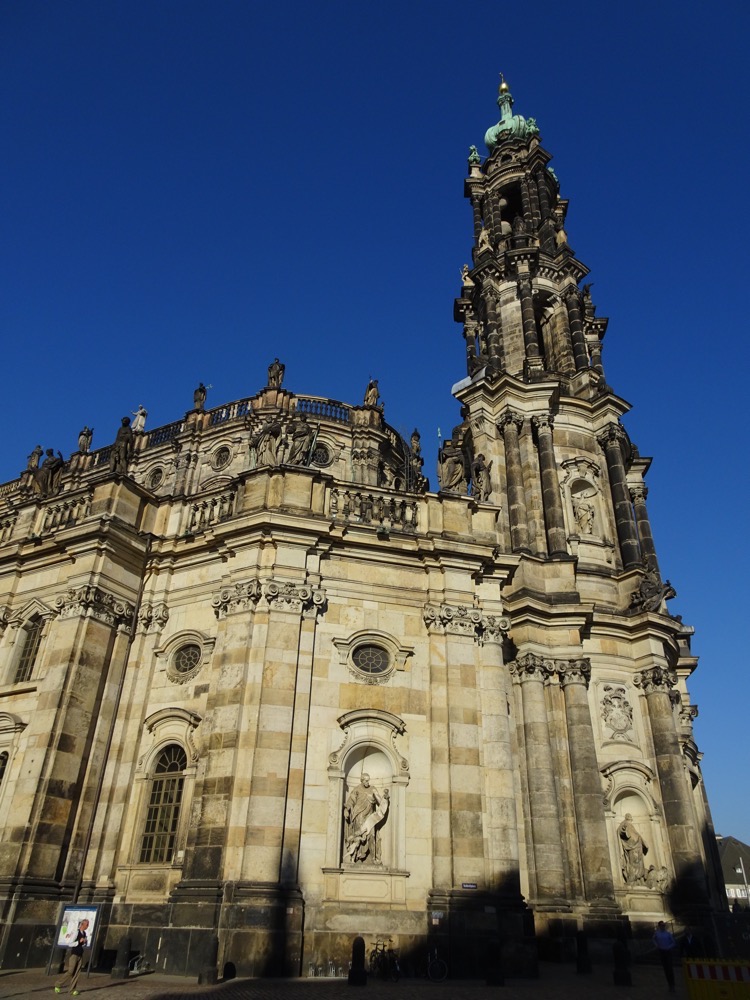
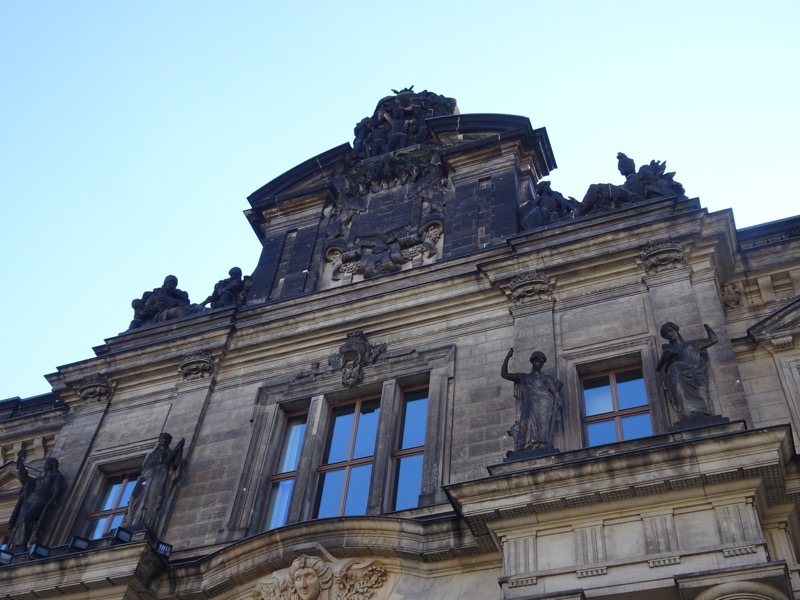
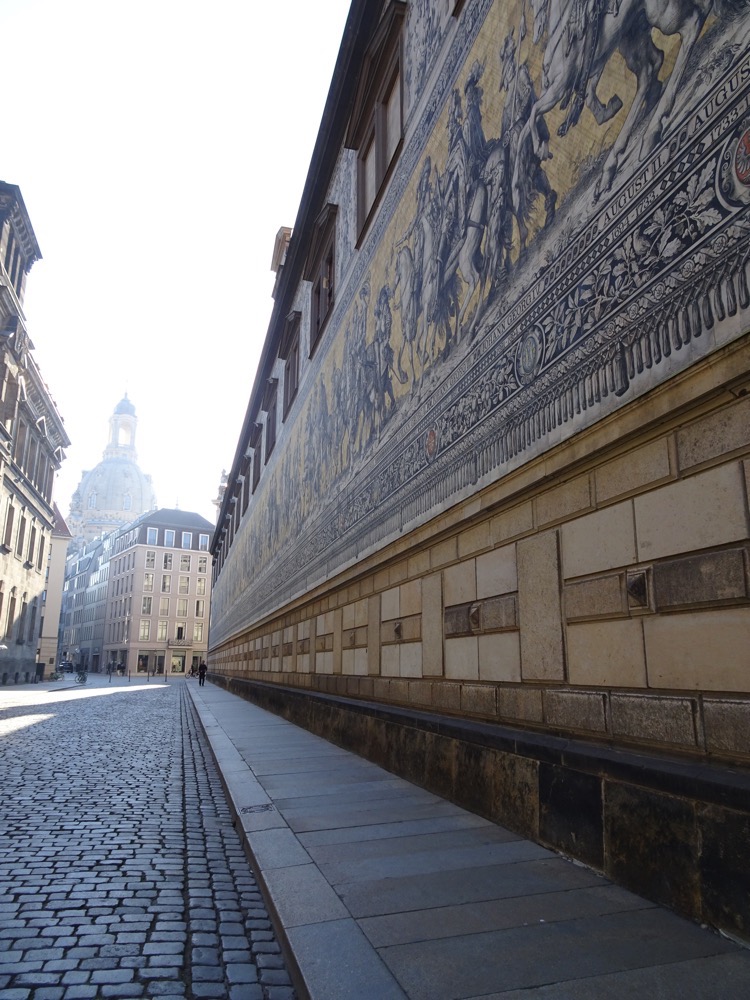 We also stumbled into some open stores – at least two of which were perennial Christmas stores! Exactly like the one we saw in Quebec in July – only with a clean, crisp, minimalist Nordic / Ikea feel to it.
We also stumbled into some open stores – at least two of which were perennial Christmas stores! Exactly like the one we saw in Quebec in July – only with a clean, crisp, minimalist Nordic / Ikea feel to it.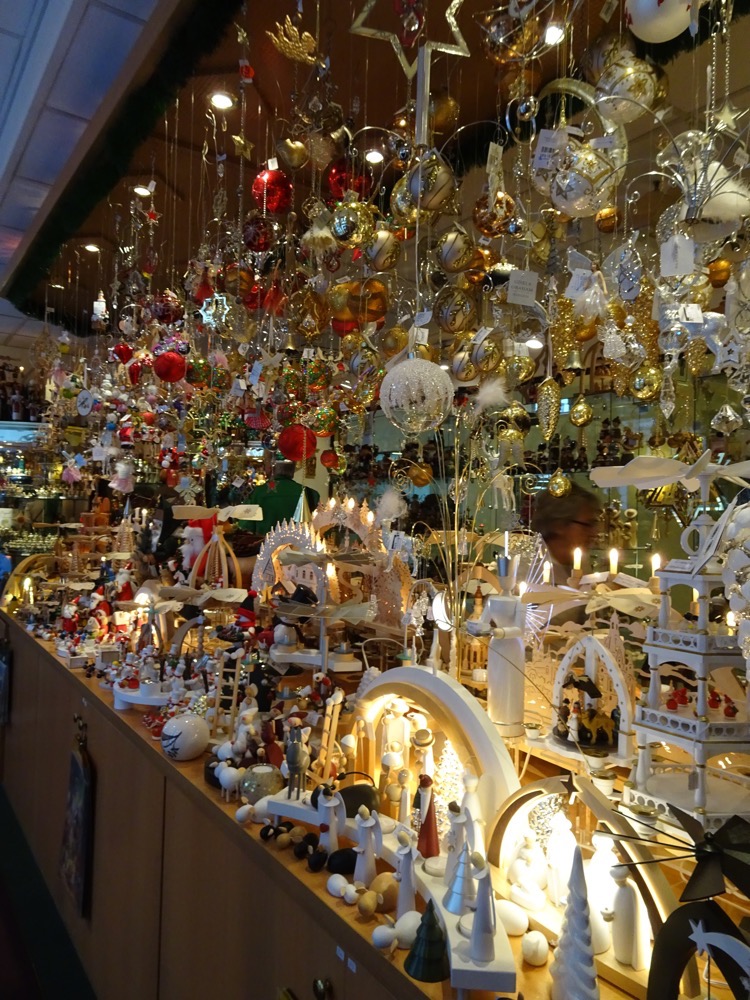
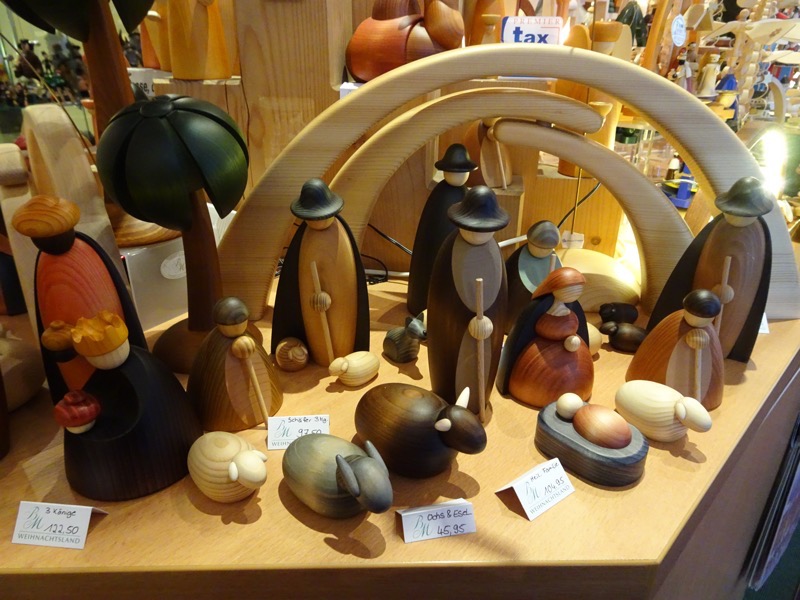
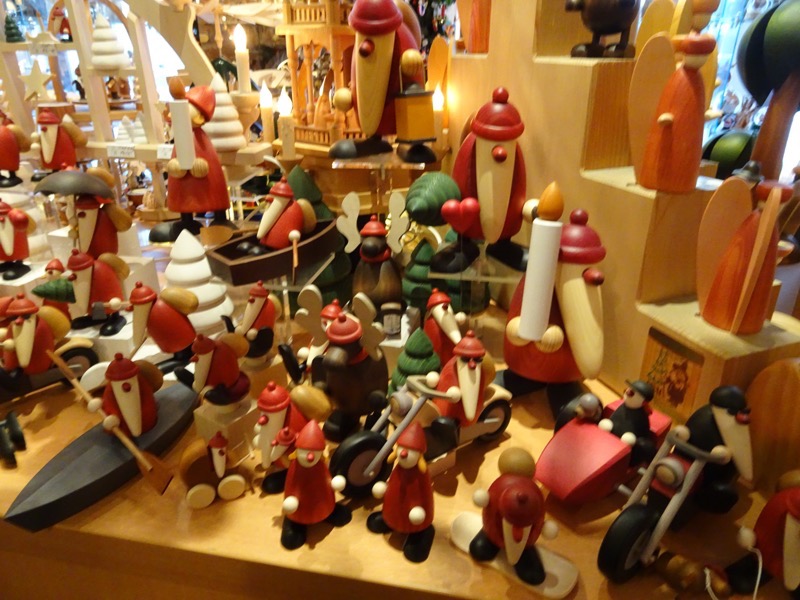 Also doubled back around on the Frauenkirche, and it was open this morning so we were able to go in and enjoy the interiors.
Also doubled back around on the Frauenkirche, and it was open this morning so we were able to go in and enjoy the interiors.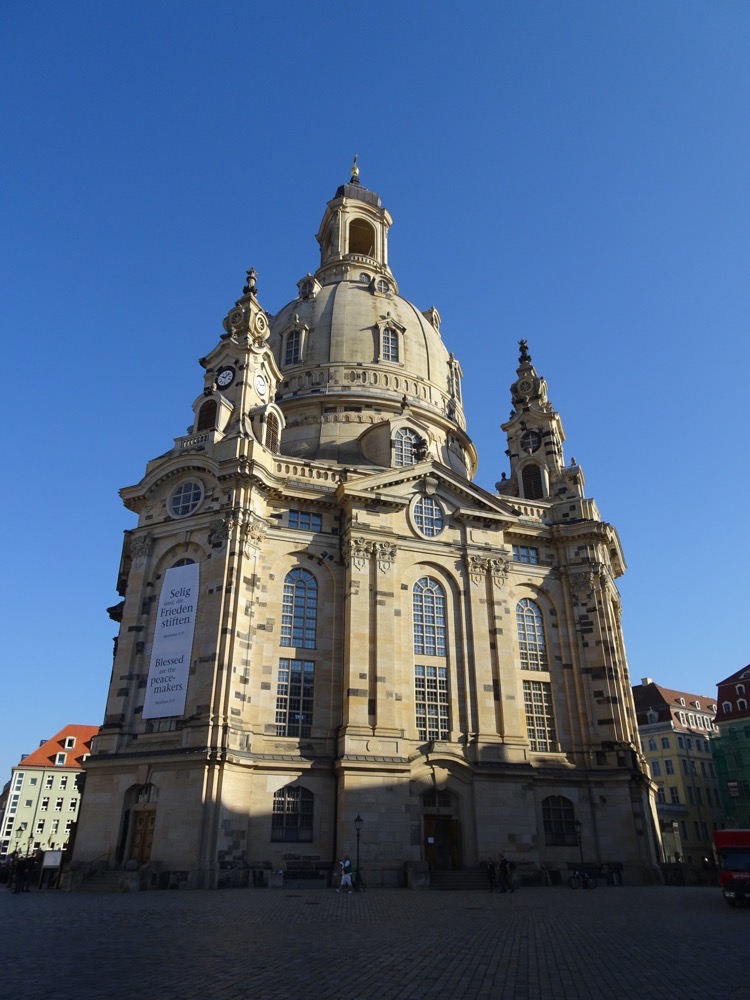
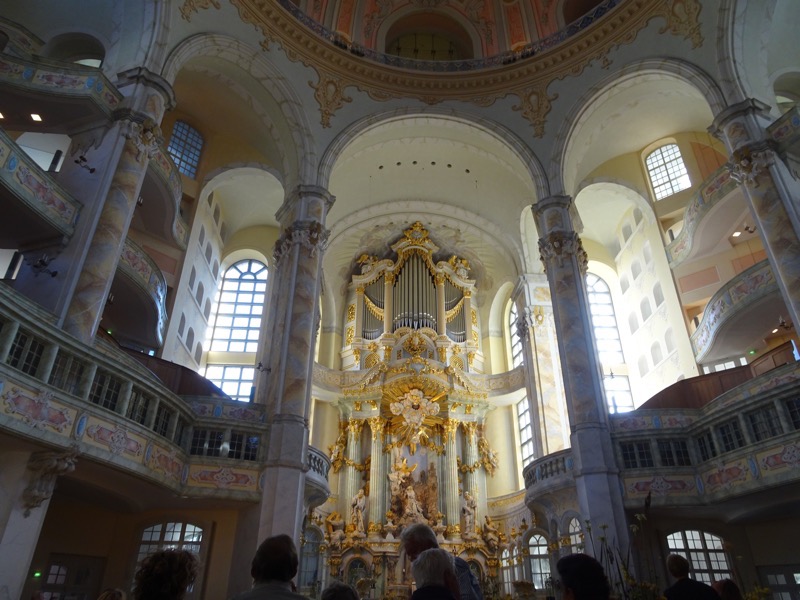
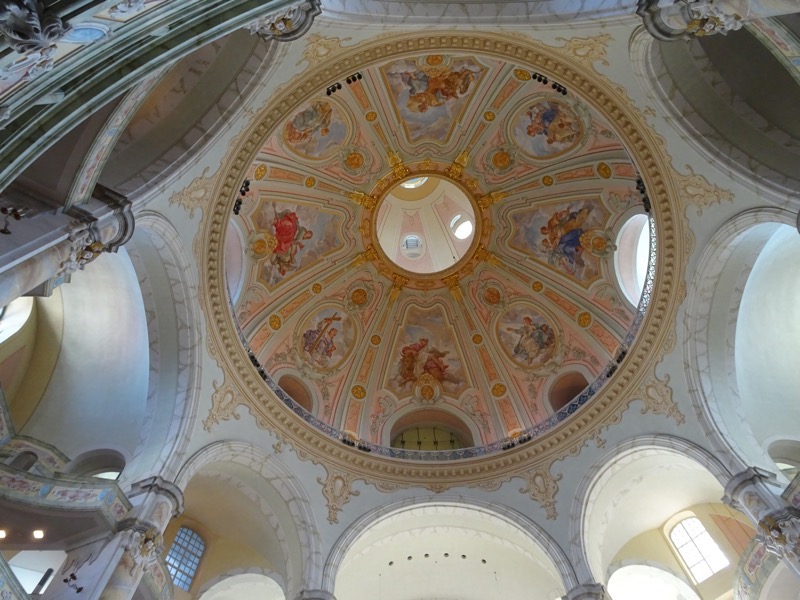 Saw the strangest ‘weird tourist’ moment in the church this morning when a woman put her €1 in the collection box to pay for a votive candle, and instead of lighting it and saying a prayer – she gave it to her kid who pocketed it. No idea where they were from, but I’m never seen someone ‘buy’ a votive candle to take home before.
Saw the strangest ‘weird tourist’ moment in the church this morning when a woman put her €1 in the collection box to pay for a votive candle, and instead of lighting it and saying a prayer – she gave it to her kid who pocketed it. No idea where they were from, but I’m never seen someone ‘buy’ a votive candle to take home before.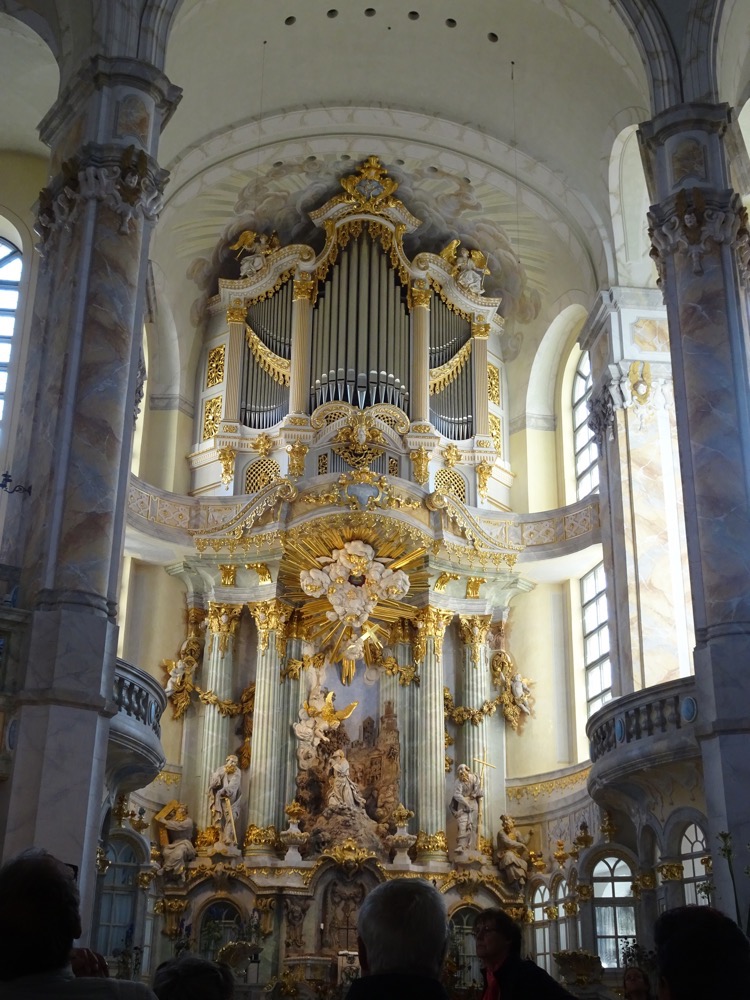 Neumarkt:
Neumarkt: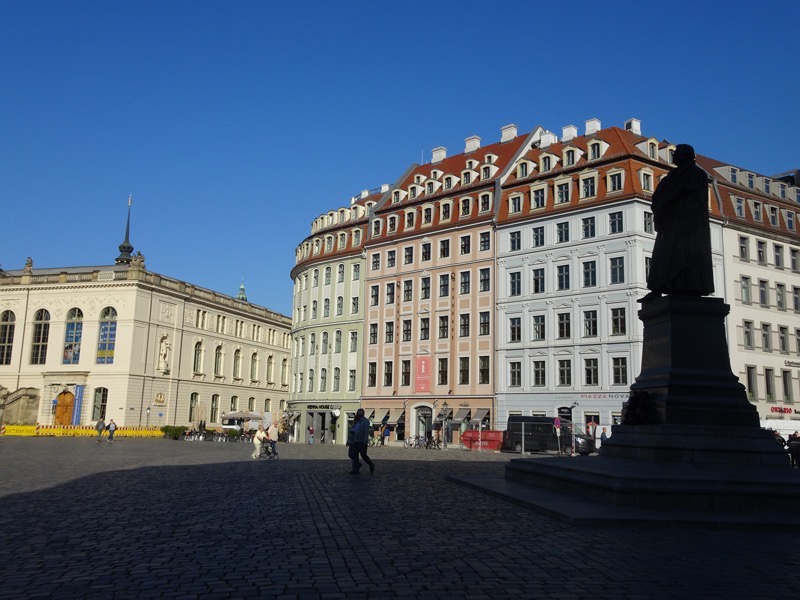 Our hotel. Lovely place, highly recommend it… and so cheap compared to Iceland! 😛 I have a feeling that is going to be a running theme for the rest of our stay in Eastern Europe.
Our hotel. Lovely place, highly recommend it… and so cheap compared to Iceland! 😛 I have a feeling that is going to be a running theme for the rest of our stay in Eastern Europe.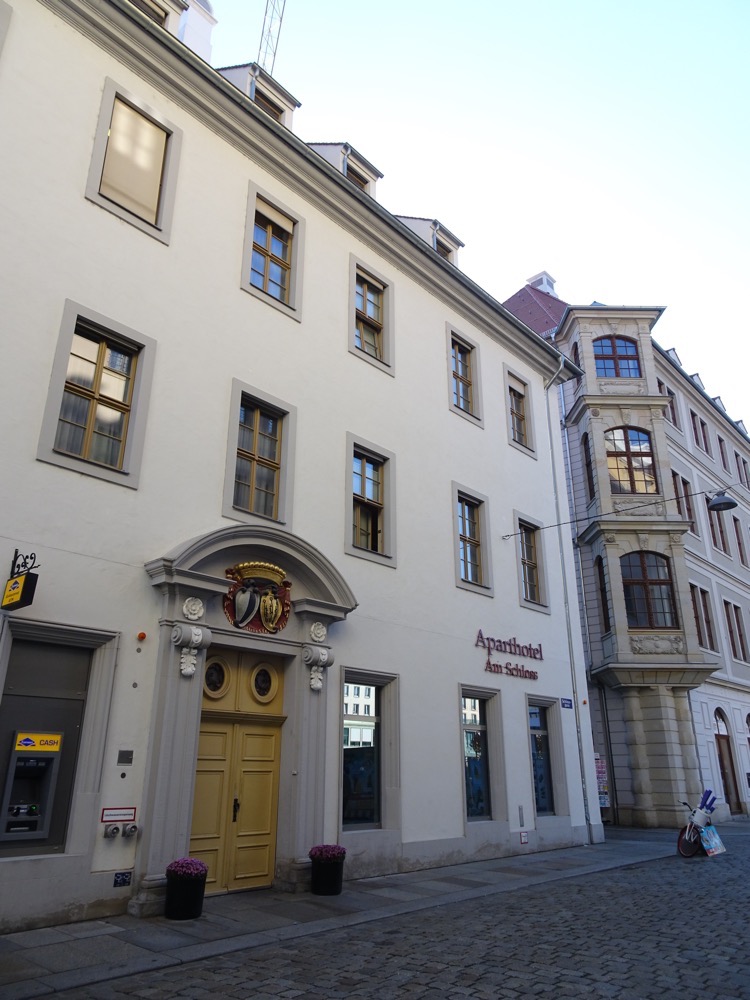
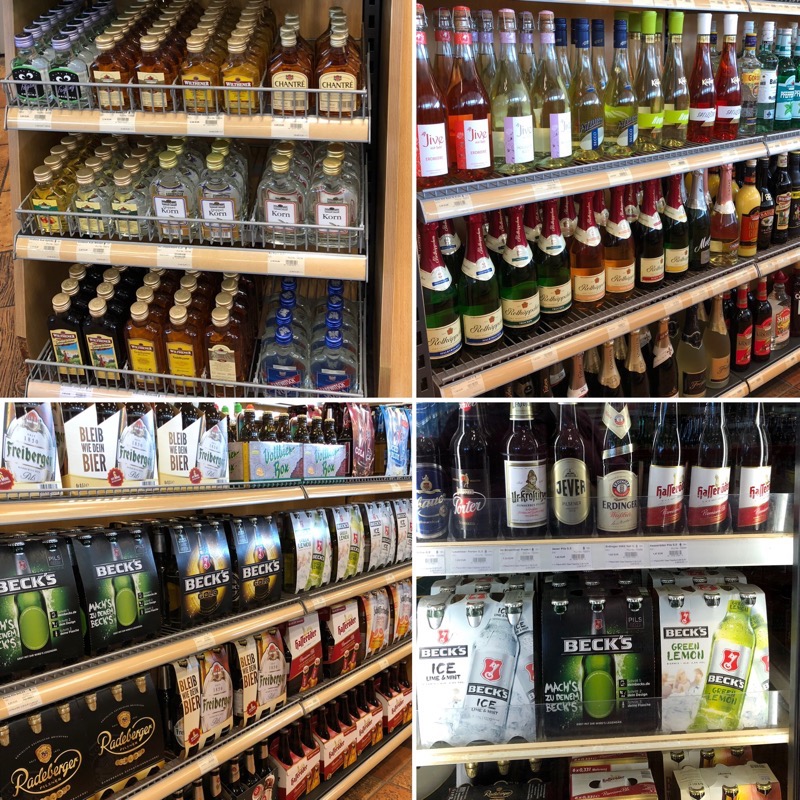
 On the way through – I saw this awesome luggage conveyor belt to help you get your luggage up long flights of stairs when there are limited or no lift facilities. Never seen anything so brilliant before in my life – Japan, New York, take notes: You need these!
On the way through – I saw this awesome luggage conveyor belt to help you get your luggage up long flights of stairs when there are limited or no lift facilities. Never seen anything so brilliant before in my life – Japan, New York, take notes: You need these!

 The train was clean and comfortable though, but unfortunately, the onboard wifi didn’t appear to be working – that or my enquiring of the (possibily Czech) train conduction ‘Sprechen zie English?’ was off-putting and she decided not to tell us how to hook onto it. 😛
The train was clean and comfortable though, but unfortunately, the onboard wifi didn’t appear to be working – that or my enquiring of the (possibily Czech) train conduction ‘Sprechen zie English?’ was off-putting and she decided not to tell us how to hook onto it. 😛
 We arrived in Prague around 3:30pm, and then went searching for taxis. On our way, we ran into another Aussie couple (the Crumpler bags and the 4163 postcode on their luggage tag told us they were from Victoria Point – about 20 mins from where I live!), they too were looking for cabs. Directly exiting the station we found the cab rank – we needed to go all of 1.5km and they were going approximately 1.6km. Walkable – but not really when you are dragging suitcases over cobblestones. The cabbies were all charging flat rate of €15.00 or Kč500.00 to take you the 1.5kms to the city centre… which according to the online fare calculators, it should be somewhere around the Kč215.00 mark to do the trip. Fuck the taxi industry – no wonder they have such shit reputations. When I started working down the line looking for a cabbie who would agree to take us on the meter, they all refused and told me that there were taxis upstairs outside the bus station that do metered trips. Get up to that rank and find the same bullshit ‘private car/flat rate’, Kč400.00 to get to the city. Urgh. It’s been a long day so once I managed two vehicles for our newly met neighbours from home, we capitulated and overpaid to get to our hotel.
We arrived in Prague around 3:30pm, and then went searching for taxis. On our way, we ran into another Aussie couple (the Crumpler bags and the 4163 postcode on their luggage tag told us they were from Victoria Point – about 20 mins from where I live!), they too were looking for cabs. Directly exiting the station we found the cab rank – we needed to go all of 1.5km and they were going approximately 1.6km. Walkable – but not really when you are dragging suitcases over cobblestones. The cabbies were all charging flat rate of €15.00 or Kč500.00 to take you the 1.5kms to the city centre… which according to the online fare calculators, it should be somewhere around the Kč215.00 mark to do the trip. Fuck the taxi industry – no wonder they have such shit reputations. When I started working down the line looking for a cabbie who would agree to take us on the meter, they all refused and told me that there were taxis upstairs outside the bus station that do metered trips. Get up to that rank and find the same bullshit ‘private car/flat rate’, Kč400.00 to get to the city. Urgh. It’s been a long day so once I managed two vehicles for our newly met neighbours from home, we capitulated and overpaid to get to our hotel. And just like Fontana Trevi – the place was overrun with people waiting for the clock to chime the hour. The town square is packed, but I know it will be empty tomorrow morning and I will be able to get some quiet photos of the clock like it may have been hundreds of years ago.
And just like Fontana Trevi – the place was overrun with people waiting for the clock to chime the hour. The town square is packed, but I know it will be empty tomorrow morning and I will be able to get some quiet photos of the clock like it may have been hundreds of years ago.
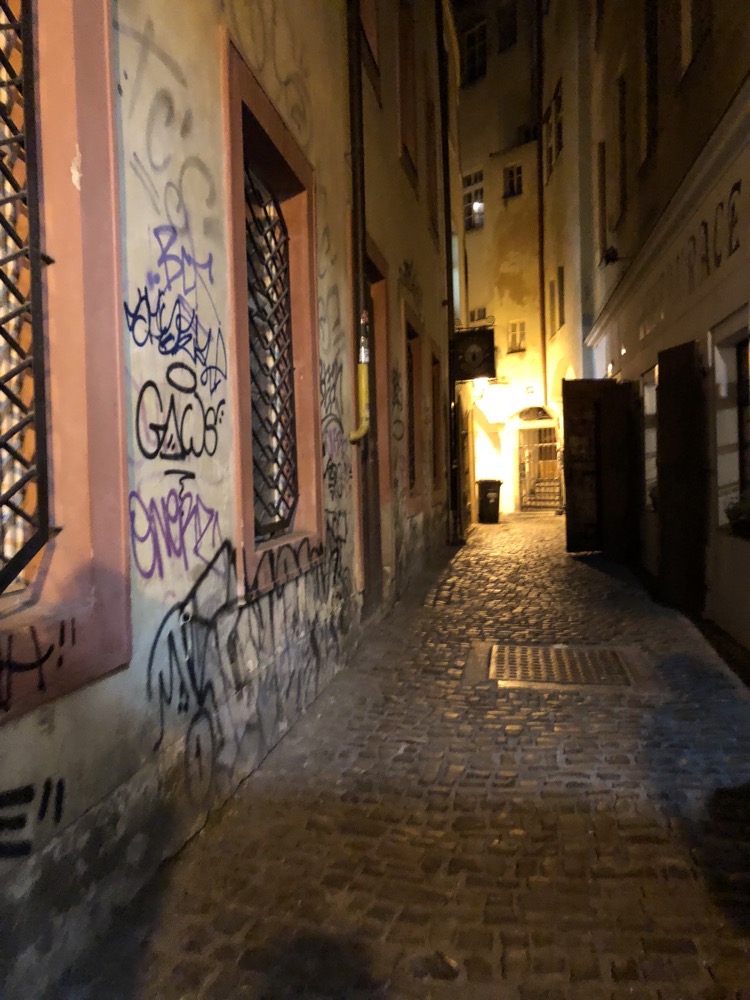 As it turns out the
As it turns out the  The menu was quite extensive, it was hard to choose what to have – it’s so nice to be back in the world of affordable food again!
The menu was quite extensive, it was hard to choose what to have – it’s so nice to be back in the world of affordable food again! Baked brie with cranberry sauce served with toast:
Baked brie with cranberry sauce served with toast: And we totally over orded for our mains (after Icelandic food being rather fancy and small plated):
And we totally over orded for our mains (after Icelandic food being rather fancy and small plated):  Roast duck in Blueberry Sauce:
Roast duck in Blueberry Sauce: Potatoes with cream, Niva blue cheese and a bit of garlic:
Potatoes with cream, Niva blue cheese and a bit of garlic: Beef goulash in a loaf of bread:
Beef goulash in a loaf of bread: Apple Strudel with whipped cream and Vanilla ice cream:
Apple Strudel with whipped cream and Vanilla ice cream: This is happy full yale – who ordered everything he wanted and yet the bill came in just under AUD$70 including 3 pints of cider and 15% included tip! Madness. If everything feels relative to Iceland, I think yale can afford to eat again after his two-week crash diet of cuppa noodles and wraps made in the back of the car for lunch!
This is happy full yale – who ordered everything he wanted and yet the bill came in just under AUD$70 including 3 pints of cider and 15% included tip! Madness. If everything feels relative to Iceland, I think yale can afford to eat again after his two-week crash diet of cuppa noodles and wraps made in the back of the car for lunch! With full tummies and a cider buzz, we talk a short turn around the Prague Old Town looking at all the touristy shit. The place sure has changed since I was here back in 1995… so many visitors, and flashing lights and massage parlours ( 😮 ), and souvenir stores. And in a direct radius out from them – ALL the hugely expensive designer shopping brands, and I mean ALL of them. It’s weird, right? Tacky tacky souvenirs, and then across the street and fanning out – Tiffany, Boucheron, Cartier, Philippe Patek, Burberry, Louis Vuitton, and on and on and on. They’re all here.
With full tummies and a cider buzz, we talk a short turn around the Prague Old Town looking at all the touristy shit. The place sure has changed since I was here back in 1995… so many visitors, and flashing lights and massage parlours ( 😮 ), and souvenir stores. And in a direct radius out from them – ALL the hugely expensive designer shopping brands, and I mean ALL of them. It’s weird, right? Tacky tacky souvenirs, and then across the street and fanning out – Tiffany, Boucheron, Cartier, Philippe Patek, Burberry, Louis Vuitton, and on and on and on. They’re all here.



